OneWeb Minisatellite Constellation
Non-EO
Quick facts
Overview
| Mission type | Non-EO |
| Launch date | 27 Feb 2019 |
OneWeb Minisatellite Constellation for Global Internet Service
On June 15, 2015, Airbus Defence and Space announced that it has been selected by OneWeb Ltd. (UK) as its industrial partner for the design and manufacturing of its fleet of microsatellites. The program is backed by the Virgin Group,Bharti Enterprises, Hughes Network Systems, Intelsat, Qualcomm, Airbus Group, and others. This initial production of 900 satellites, each with a mass of ~150 kg, is planned for launch into LEO (Low Earth Orbit) beginning in 2018 to deliver affordable Internet access globally. 1) 2) 3)
Airbus, which up to now has built large one-off satellites, will have to upgrade its satellite manufacturing approach to complete up to four satellites a day. Design and production of the first 10 satellites will be carried out at Airbus Defence and Space’s facilities in Toulouse (France). Full series production will take place at a dedicated plant located in the USA.
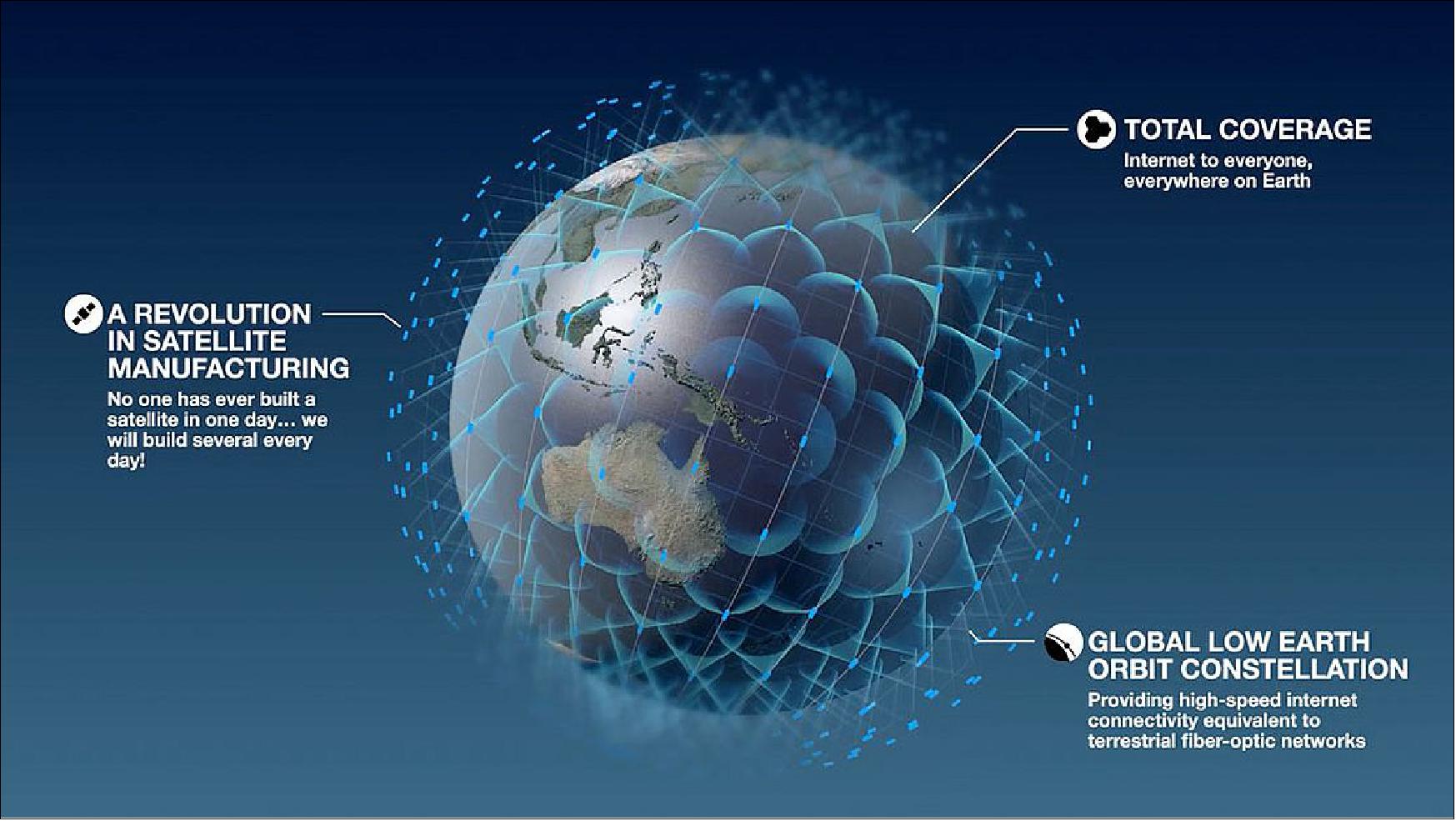
Of the constellation, 648 of them will be placed in18 orbital planes with an altitude of about 1200 km. The remaining satellites will be used as spares on the ground or in orbit. Launches are expected to begin in 2018, probably using Virgin Galactic, and the system should be operational by 2020.
The funding allows OneWeb to further develop key technologies to enable affordable broadband for rural and underdeveloped locations. The OneWeb User Terminals are optionally solar powered, and with their embedded LTE (Long Term Evolution) standard, 3G, 2G and WiFi access capabilities will extend the mobile operator’s reach. The network will also provide unprecedented speeds and low latency access to ships, planes, trains and oil platforms while providing seamless interoperability with Intelsat’s fleet of Ku-band satellites.
Following the announcement on June 15 of its joint venture with Airbus Group (pending regulatory approvals) to design and manufacture its first 900 microsatellites, OneWeb announced on June 25 the largest commercial rocket acquisition ever of more than 65 rockets including 21 Soyuz launch orders from Arianespace. Arianespace will utilize the Soyuz launch pads from Guiana Space Center, Baikonur and additional launch pads from Russia to ensure the timely deployment. 4)
Virgin Galactic has signed a contract with OneWeb Ltd. to serve as one of its inaugural satellite launch providers. Under the terms of the Launch Services Agreement, Virgin Galactic’s LauncherOne rocket will perform 39 satellite launches for OneWeb—one of the largest commercial procurements of launches in history. 5)
In July 2015, ESA announced support of the planned megaconstellations like OneWeb and LeoSat to ensure that the European and Canadian space industry remains competitive in the face of what could be a major transformation of the Satcom industry. ESA has established the ARTES 3-4 Megaconstellations Opportunity. Recognizing the urgency of the matter and the tight development schedules that will be required as well as the very high stakes involved, a new dedicated ARTES 3-4 Call for Proposals will be announced in the coming weeks which will run until June 2016. 6)
In April 2016, OneWeb has filed an application with the FCC (Federal Communications Commission) seeking access to the U.S. market for their planned LEO (Low Earth Orbit) satellite system. The company’s constellation is anticipated to make broadband connectivity available in unserved or underserved regions today, and when fully deployed, to support services including cellular backhaul, mobility services, community and residential Internet access, and emergency communications in the U.S. and globally. 7)
OneWeb’s application demonstrates that the system will comply with the Commission's rules and the ITU (International Telecommunication Union) requirements for highly spectrum-efficient sharing of the Ku-band and Ka-band with geostationary satellites. The progressive pitch technology is designed to modify the orientation and power level of the OneWeb satellites as they pass over the equator, thereby enabling sharing with geostationary satellite operators.
Overview
WorldVu Satellites Limited, operating as OneWeb, Ltd, announced in June 2015 plans to build, launch and operate a LEO (Low Earth Orbit) satellite constellation to help bring high-speed Internet and telephony to billions of people around the world. Qualcomm Inc. and The Virgin Group have been announced as initial investors, with Qualcomm Executive Chairman Paul Jacobs and Virgin Group Founder Sir Richard Branson to join OneWeb founder Greg Wyler on the company's board of directors. 8) 9)
According to the ITU (International Telecommunications Union), as of the end of 2014, more than half the world’s population lacks Internet access. OneWeb, founded in 2012 under the name WorldVu, hopes to bring high-speed Internet and telephony to people living in underserved areas. The OneWeb satellite system introduces the first-ever telecom-class microsatellites.
OneWeb aims to provide user terminals that are self-installable, enabling coverage in these areas for any nearby phone, computer or tablet. OneWeb’s network would also be able to provide global emergency and first responder access for disaster situations, refugee camps or other areas in need.
OneWeb’s regulatory license allows it to operate, but only on condition that its broadcasts do not bother Ku-band signals from satellites in higher orbit, which by virtue of being there for the past several decades have established priority with international regulators. Standing on the shoulders of now-dead constellations of 15 years ago that successfully fought for low-orbiting constellations’ ability to coexist with the geostationary operators, OneWeb has committed to lower its power output around the equator to avoid interference. 10)
Airbus Defence and Space and OneWeb create the OneWeb Satellites company – the next stage of the OneWeb adventure: 11) 12) 13) 14) 15) 16) 17)
• June 1, 2016: As anticipated, the proposed merger between Intelsat and Jersey-based satellite constellation OneWeb has been pulled. Intelsat, in a statement issued early on June 1st, said that not enough of its bond-holders had agreed the terms of the SoftBank-enabled financial restructuring to make the scheme work. Intelsat needed an 85 % acceptance level of the new terms on offer, and by the midnight May 31st deadline acceptance levels were short of this amount. 17)
- Intelsat’s president/CEO Stephen Spengler, said he was disappointed by the result. However, as expected, he outlined that a relationship would continue with OneWeb. “Even without a merger of our companies, the pre-existing commercial agreement among Intelsat, OneWeb and SoftBank will continue. Under this agreement, we plan to jointly develop integrated solutions utilizing both of our fleets and to act as a sub-distributor to SoftBank for the attractive application segments of mobility, energy, government, and connected car. As we create integrated services for these applications, we expect to accelerate and enhance our goal of unlocking new and larger opportunities in the communications landscape. We remain focused on achieving our operating priorities for 2017, including the continued commercialization of our Intelsat Epic high throughput satellite services.”
• March 16, 2017: Intelsat announced a merger with OneWeb that will transform the satellite industry. The companies announced an agreement in which Intelsat and OneWeb will merge in a share-for-share transaction, with Japan's SoftBank Group agreeing to invest $1.7 billion in the combined company. 16)
- This agreement has the potential of creating a space industry leader in both GEO and LEO. The new combined company will be unique in its ability to provide affordable broadband anywhere in the world. Intelsat was an early equity investor in OneWeb, recognizing the inherent advantage of a new network that could complement Intelsat's next-generation Intelsat EpicNG high-throughput satellite fleet.
• February 28, 2017: Intelsat and OneWeb have entered into a definitive combination agreement pursuant to which Intelsat and OneWeb will merge in a share-for-share transaction. Intelsat and SoftBank Group Corp. ('SoftBank') also entered into a definitive share purchase agreement. Both the merger and the SoftBank investment are subject to, among other conditions, successful completion of debt exchange offers to certain existing Intelsat bondholders as well as receipt of certain regulatory approvals. 15)
- The complementary strengths of Intelsat and OneWeb, combined with the investment by SoftBank, are intended to create a financially stronger company with the flexibility to aggressively pursue new growth opportunities resulting from the explosion in demand for broadband connectivity for people and devices everywhere.
• Dec. 21, 2016: OneWeb reports it has secured $1.2 billion in funded capital from SoftBank and existing investors, of which $1 billion will come from SoftBank. The $1.2 billion fundraising round announced will support OneWeb's revolutionary technological development and the construction of the world's first and only high volume satellite production facility. 14)
The new facility, based in Exploration Park, Florida will be capable of producing 15 satellites per week at a fraction of the cost of what any satellite manufacturing facility in the world can produce today, and expediting construction, launch and operations of its communications network. The investment is expected to create nearly 3,000 new engineering, manufacturing and supporting jobs in the U.S. over the next four years.
• June 1, 2016: MDA from Canada, Sodern from France and Teledyne Defence from the UK are now part (subcontractors) of the OneWeb venture. To equip each of the 900 satellites forming the OneWeb fleet, MDA will provide on board antenna systems, Sodern has customized to constellation its star tracker technology, while Teledyne Defence has designed communications repeater equipment derived from its high volume manufacturing heritage. 13)
• April 19, 2016: OneWeb Satellites LLC is preparing to break ground on the firm's new, estimated, $85 million, high volume satellite manufacturing factory in Exploration Park, Florida. 12)
- Announced during a ceremony with Florida Governor Rick Scott and OneWeb founder Greg Wyler, the factory near NASA’s Kennedy Space Center is set to open in 2017. Delivery of initial satellites will occur later that year or early in 2018. OneWeb Satellites is a joint venture between OneWeb, a satellite based Internet provider, and Airbus Defence and Space.
- The high volume satellite factory will be built in partnership with the State of Florida and Space Florida and is anticipated to create nearly 250 direct jobs. It will bring further growth and development to the world’s-leading space industry in Florida. The facility of ~10,000 m2 will be the industry’s first satellite factory designed to mass-produce spacecraft cost effectively using automated assembly and test capabilities similar to those used in aircraft production facilities.
• January 26, 2016: Airbus Defence and Space, the world’s second largest space company, and OneWeb, which is building a new global satellite communications system, announced the creation of OneWeb Satellites. The new joint venture, equally owned by Airbus Defence and Space and OneWeb, will design and build the 900 satellites of the OneWeb constellation, which will offer high-speed Internet with global coverage. The new company will be led by Brian Holz as CEO. 11)
OneWeb Satellites is a joint venture equally owned by Airbus Defence and Space and OneWeb
Company to design and build 900 satellites for OneWeb, as well as satellites for other future constellations marketed by Airbus Defence and Space
OneWeb Satellites will also be able to build satellites, platforms and equipment to be marketed by Airbus Defence and Space to other operators of future constellations.
“The next stage of the OneWeb adventure is here! On both sides of the Atlantic, our teams are now working under a common flag to meet the incredible challenge: to mass-produce 900 satellites for the OneWeb constellation,” said Eric Béranger, Head of Programs Space Systems. “For several months now, we have been working on the design of this unprecedented constellation and how we are going to manufacture them – both ground-breaking in their own way. The next step will be to set up a prototype line in Toulouse for production of the first 10 satellites. This will also be used to test the industrialization method for the series production of the other satellites.”
"Airbus is a key partner to our success as we move forward and are very happy to have them being a part of OneWeb and our new joint venture. We are benefiting from Airbus Defence and Space’s manufacturing and assembly knowledge as we look to initiate services,” said Matt O’Connell, CEO of OneWeb. “As we build out the constellation, besides its very reliable satellite performance heritage and technical support, Airbus brings design for manufacturing capability into this operation which is key to achieving both our short term and long term goals for providing cost effective solutions on time for our future customers,” O’Connell added.
OneWeb Satellites will undertake design activities for the entire satellite fleet and the manufacture of the first 10 flight models will take place in France, with the first ever mass production of the operational satellites planned for North America. Each satellite will weigh less than 150 kg and will operate in low Earth orbit. They will be launched by Arianespace and Virgin Galactic starting from 2018 and reach their orbital positions using electrical propulsion.
• March 20, 2018: Citing recent reforms that provide more time to orbit a new satellite constellation, satellite broadband-startup OneWeb asked U.S. telecom regulators to nearly triple the size of its authorized low-Earth-orbit constellation. 18)
- The Federal Communications Commission (FCC) in June approved OneWeb’s request to serve customers in the United States using a constellation of 720 satellites. Writing to the commission March 19, OneWeb asked that the company be permitted another 1,260 satellites, bringing the total number to 1,980 spacecraft.
- OneWeb said the FCC’s September decision to give companies more time to fully deploy their constellations enables OneWeb to plan a larger fleet. The FCC previously required companies to launch 100 percent of their satellites within six years of authorization. Under the new rules, companies have six years to deploy half their fleet.
- “OneWeb responsibly designed its LEO Constellation on the basis of a milestone regime that required launch and operation of the entire constellation within a six-year time frame .... If the current milestone regime had been in effect when OneWeb began planning its constellation and network architecture, OneWeb would have proposed a much more expansive LEO Constellation,” the company wrote the FCC.
- The FCC imposes deployment deadlines to prevent companies from “warehousing” spectrum, laying claim to frequencies and barring them from use by other companies. The new regulations require full constellation deployment in nine years. If an operator fails to reach full deployment in that time, its authorized number of satellites shrinks to the number already in orbit. OneWeb spoke against the FCC modifying constellation deployment deadlines during last year’s rulemaking procedure.
- OneWeb said the new satellites will use the same Ku- and Ka-band spectrum as the first 720 satellites. To accommodate the additional 1,260, OneWeb said it would double the number of orbital planes from 18 to 36, and increase the maximum number of satellites per plane from 40 to 55.
- The larger fleet will require more ground stations, OneWeb said, with as many as 50 antennas each to connect with the constellation. OneWeb’s gateway supplier Hughes Network Systems of Germantown, Maryland, said March 13 that it has shipped the first completed gateways.
Doubling MEO (Medium Earth Orbit) Constellation: (Ref. 18)
OneWeb’s modified LEO plans follow a Jan. 4 request to revise a pending application before the FCC for a medium-Earth-orbit constellation of 1,280 satellites, also for broadband. The company asked the FCC for twice as many satellites — 2,560 total — for MEO, and to expand its frequencies from the scarcely used V-band to include Ku-, Ka-, and the seldom used E-band.
OneWeb gave the same explanation for the additional MEO satellites, namely that the new FCC rules allow more time to deploy a constellation.
“The Commission’s dramatic relaxation of the milestone rules mid-way through various Commission processing rounds has compelled OneWeb to reassess what it can achieve now in the newly expanded milestone timeframe,” OneWeb wrote Jan 4.
OneWeb made no mention of the impact these changes may have on a move by Boeing to transfer one of its V-band constellation filings to OneWeb founder Greg Wyler. Boeing asked the FCC in December to swap ownership of its 1,396- to 2,956-satellite V-band filing to a company under Wyler’s name called SOM1101 LLC.
The FCC has not yet authorized any of the six V-band constellations submitted in 2016 and 2017. To date, the FCC approved three new non-geostationary satellite systems in Ku- and Ka-band for market access: OneWeb, fleet operator Telesat of Canada for 117 LEO satellites, and Space Norway for two satellites in highly elliptical orbits. Another eight proposals are still under consideration, including SpaceX’s Starlink constellation of 4,425 satellites that FCC Chairman Ajit Pai publicly supported last month.
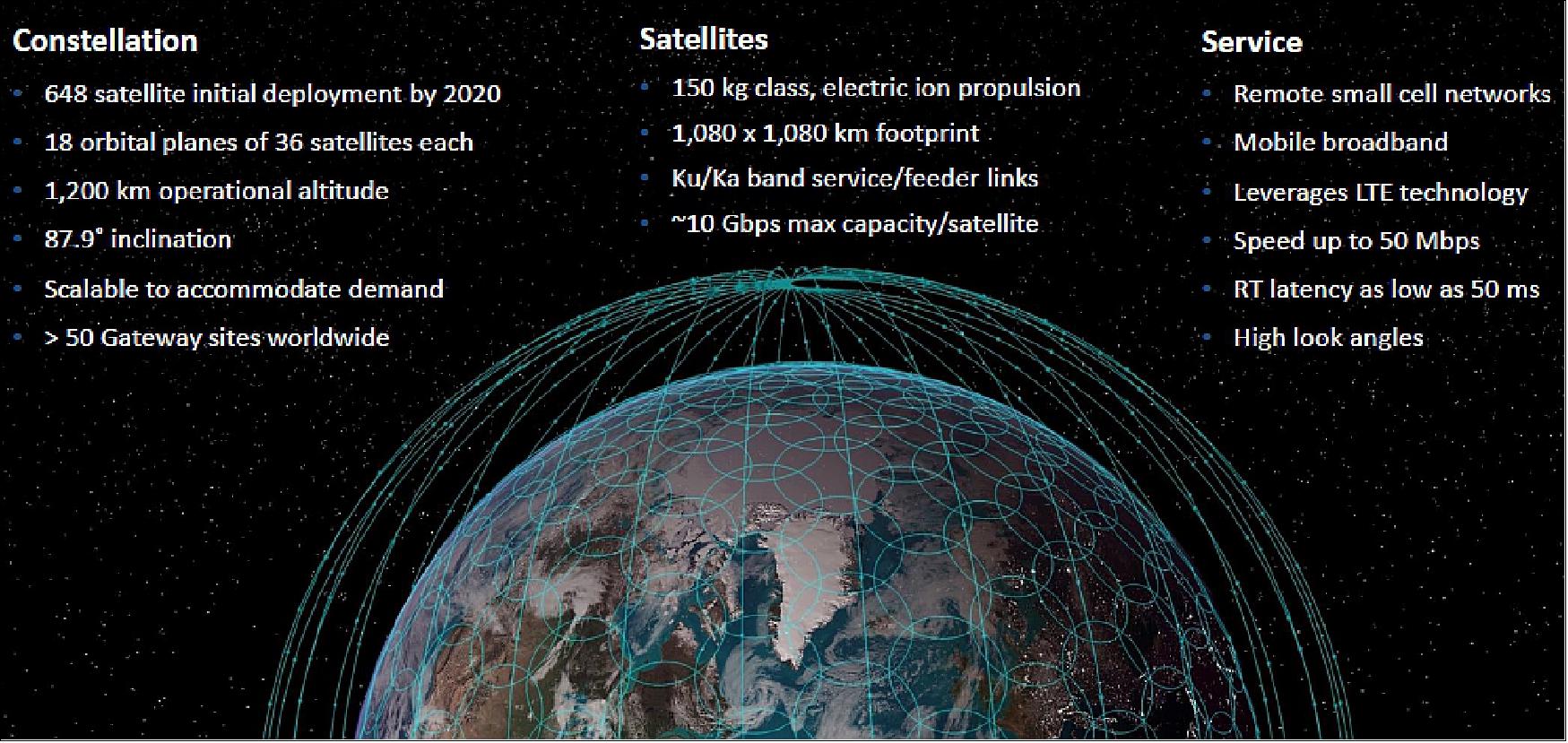
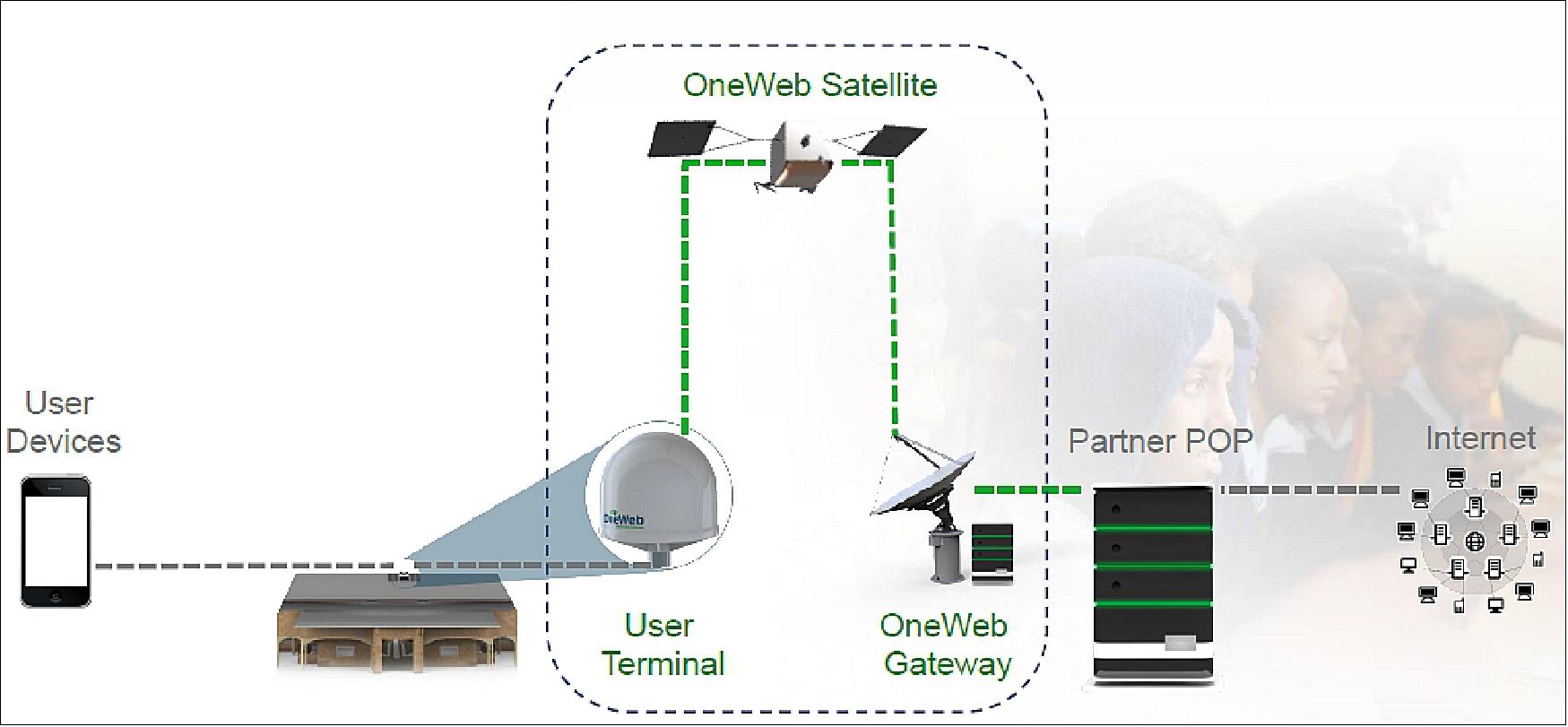
Spacecraft
Satellite production
OneWeb Satellites is a joint venture between OneWeb and Airbus DS (Defence and Space):
• Airbus DS is responsible for the design and fabrication of OneWeb satellites
• The first 10 satellites will be built in Toulouse to validate the design and manufacturing processes
• A satellite factory is being built next to KSC (Kennedy Space Center) in Florida. 20)
- $85 million facility
- More than 13,900 m2 in size
- Set to open in 2018
- State-of-the art assembly and I&T (Integration and Test).
• Production contract
- Initial production of 900 satellites
- Peak production rate of 1-2 satellites per day.
• June 27, 2017: OneWeb has inaugurated their assembly line in Toulouse, France, to start end-to-end validation, testing, and integration of their first satellites, set for launch in a little more than nine months. 21)
- The 4,600 m2 Toulouse facility will serve to validate the production methods necessary to manufacture high-performance satellites at a scale never achieved before, de-risk any potential issues, and lay the framework for the larger multi-line OneWeb Satellites factory near the Kennedy Space Center, Florida. The initial 10 pilot and Toulouse-built satellites, after having undergone a comprehensive set of tests, will become the first of OneWeb's fleet.
- Benefiting from the industrial and space expertise at Airbus, this assembly line will include state-of-the-art automation, test equipment and data acquisition capabilities to shorten assembly times and provide means to analyze factory performance and process improvements. These satellites will provide valuable in-orbit data to confirm the design of the spacecraft and proceed with fine tune adjustments if necessary. They will also enable nearly real-time detection and correction of any anomalies in the manufacturing process.
- As well as building the fleet of satellites, OneWeb Satellites will provide customized versions of these ultra-high performance satellites, platforms and core technologies to Airbus to support their third party sales to other commercial and government operators globally. The mini-satellites, coming from the huge production line, will enable new cost and performance paradigms for those looking to benefit from the advantages satellites can bring to Earth observation, sensor and telecommunications markets. The development of this facility has been supported by Bpifrance in the framework of the French PIA (Programme d'Investissements d'Avenir) program .
- Greg Wyler, Founder and Chairman of OneWeb, stated that the company has just about nine months until the first of the fleet launches into orbit. Then, if all goes well, OneWeb will initiate the world's largest launch campaign, sending new satellites up every 21 days and building not just a fleet but a digital bridge to enable affordable broadband access for the billions of unconnected around the world.
• On October 25, 2017: OneWeb's new satellite constellation is being built with a mission to close the global digital divide by 2027, bringing speeds of up to 2.5 Gbit/s direct to homes around the world, according to the company's Founder and Executive Chairman, Greg Wyler. 22)
- Wyler testified before the Senate Committee on Commerce, Science, and Technology at a hearing entitled "The Commercial Satellite Industry: What's Up and What's on the Horizon." Wyler discussed OneWeb's approach to providing broadband Internet through the firm's global satellite constellation, which will service Alaska starting in 2019, and in the following year, the constellation coverage will reach every square mile of America and territories, leaving no one behind. In June of this year, OneWeb received the Federal Communications Commission's (FCC) first approval for market access to launch satellites and ultimately provide Internet services to Americans.
- Wyler's testimony detailed some of the early accomplishments of OneWeb, which included breaking ground on a new $85 million satellite production facility in Exploration Park, Florida, that will manufacture the firm's satellites and ultimately employ 250 people. The facility, opening in 2018, will be capable of producing 15 satellites per week and will have tremendous multiplier effects for the regional economy.
- OneWeb's rockets are in place and the first launch is scheduled for May of 2018. This global system will mean a brighter future for the half of America with substandard access to the Internet, primarily in rural areas, and will be a foundation for ubiquitous 5G service, enabling the Internet of Things (IoT), connected vehicles, telemedicine and online education.
OneWeb Satellite Design and Production
In order to produce 900 satellites in such a short time span with an unprecedented production rate of up to 15 satellites per week, a disruptive approach towards design and production for space applications had to be taken. Design-to cost, design to manufacture and test approaches have been implemented throughout the program, from the selection of components, production of equipment and satellite assembly, integration and testing. 23) 24)
Large-scale production and test approaches from other industries, including advanced levels of automation, have been applied and merged with established space methods adapted to the large scale of the OneWeb’s constellation. State-of-the-art robotics, inspection methods, test equipment and automated data acquisition systems will be implemented to support end-to-end integration and test activities.
The OneWeb Satellites will be of the 200 kg class and are designed for a 5 years life-time. At a size of roughly 1 m x 1 m x 1.3 m, they feature two external solar panels, electric propulsion and antennas for the user links in Ku-band and the gateway links in Ka-band. When a OneWeb satellite nears the end of its intended service life, it will de-orbit automatically, ensuring that the space around our planet remains free and clear for future generations, being therefore fully compliant with existing IADC (Inter-Agency Space Debris Coordination Committee) regulations.
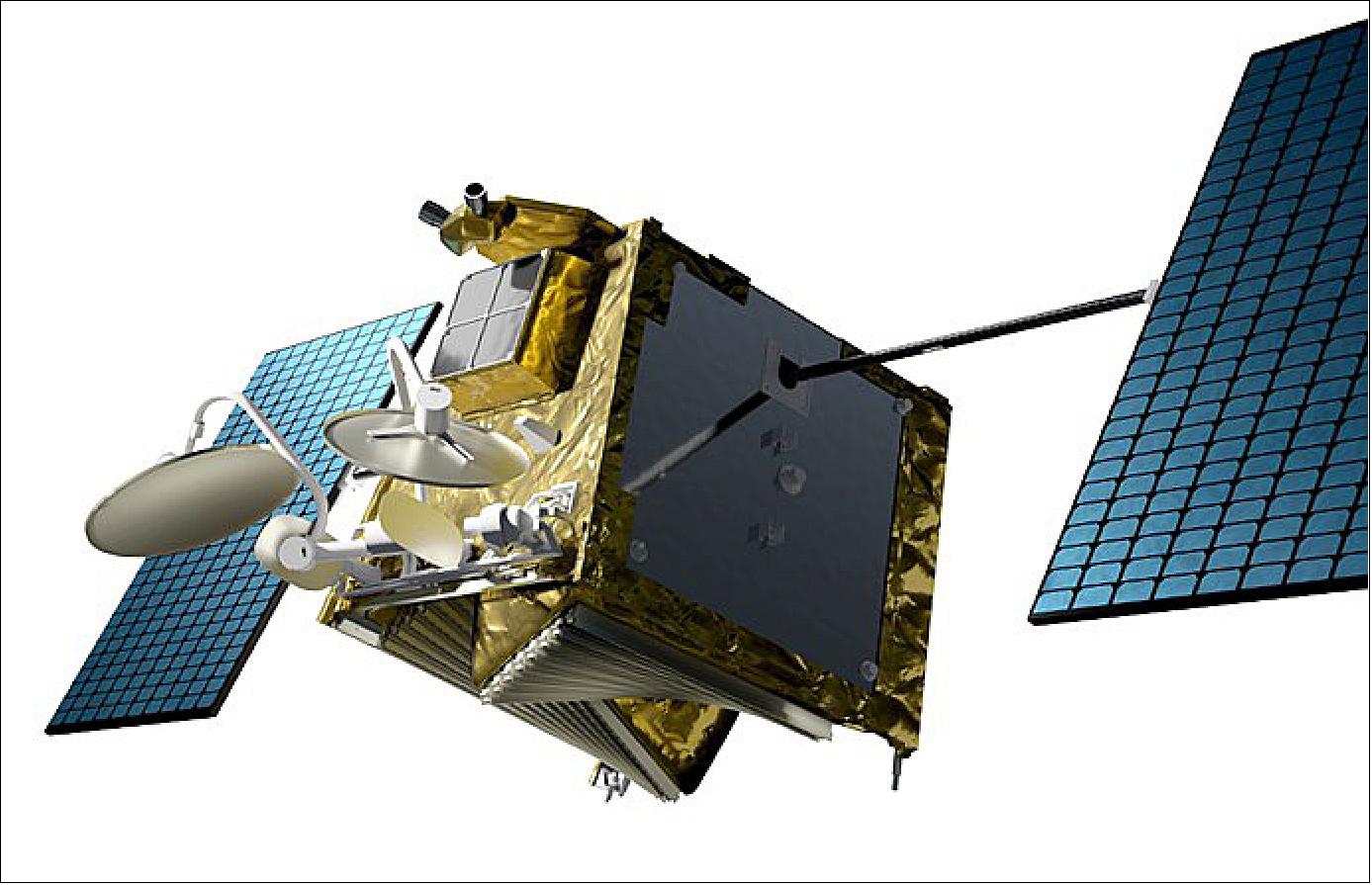
The OneWeb 3rd Party Platform Program
As an interesting side product of the OneWeb program, additional recurring OneWeb platforms, i.e. excluding the OneWeb mission specific Payload, will be produced and commercially sold to external customers for the so called “3rd party” missions. Based on the design experience and the capabilities of the high throughput production line, this offers a uniquely affordable and powerful solution to the 150 kg class of satellites.
The bare OneWeb platform can accommodate payloads of up to 60 kg. It can provide for an Earth panel surface for external units of up to 750 x 850 mm2 and supply an on-orbit average power of up to 200 W end of life. Qualified to high reliability standards within the OneWeb program, it is designed for a 5 years minimum lifetime in LEO orbits up to 1200 km altitude. It is compatible with dedicated and shared launches. Its electric propulsion system allows for high flexibility in orbit parameters, provides significant orbit raising capability and makes it compliant with post-mission disposal regulations.
Airbus DS will act as a one-stop shop for third party applications offering design and development services as well as launch, LEOP and in orbit operations if requested by the customer. A dedicated organization has been implemented within Airbus DS for this purpose. Production lines are available in Europe and the US to adapt to customer needs. First platforms are envisioned to be available for 3rd party applications from late-2018/early-2019.
Development Status
• Eutelsat and OneWeb said July 26 they have agreed a plan to merge their businesses to create a global multi-orbit satellite broadband operator. 25)
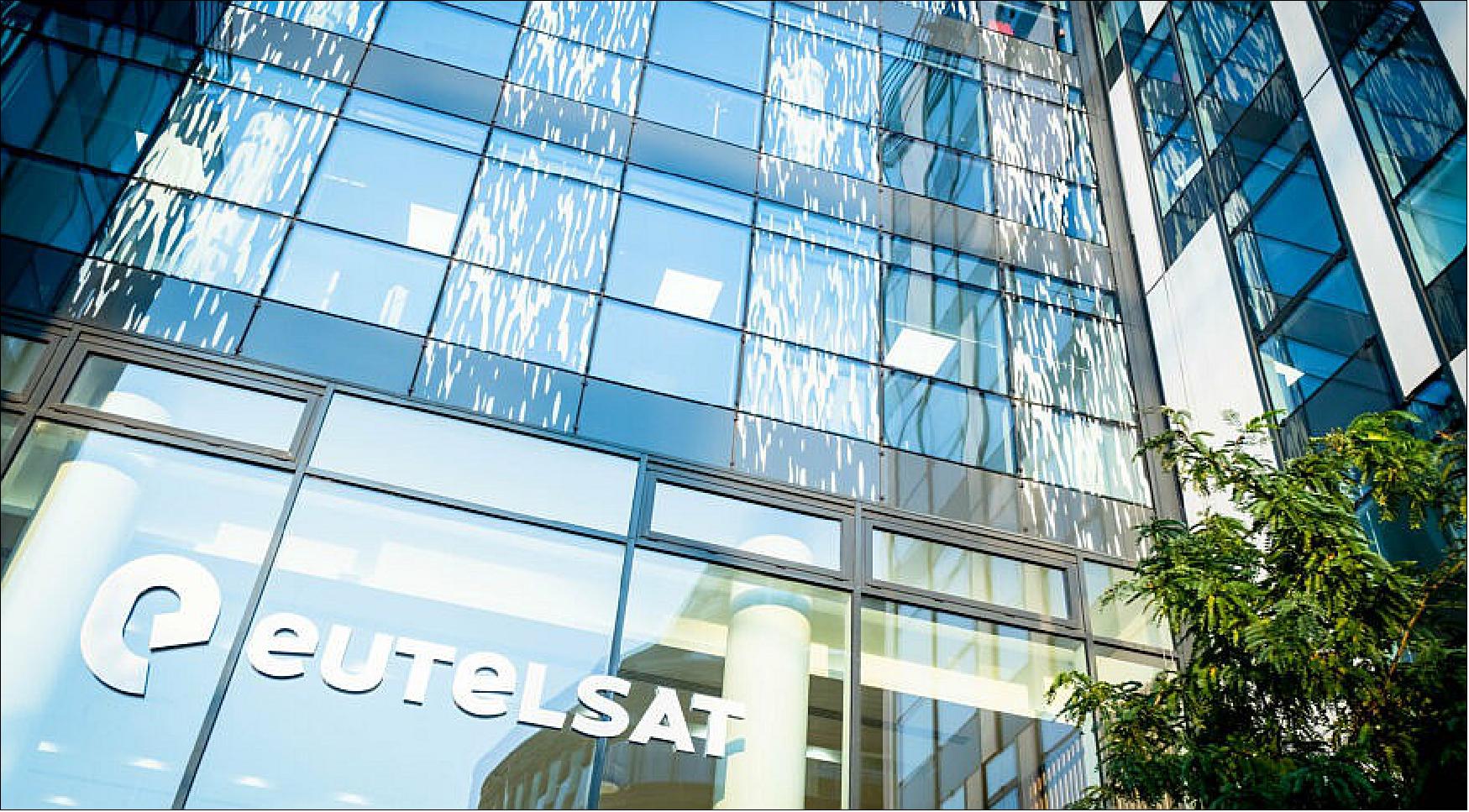
- The deal would combine France-based Eutelsat’s satellite fleet in geostationary orbit (GEO) with British startup OneWeb’s constellation in low Earth orbit (LEO).
- Eutelsat already owns 23% of OneWeb and has been building a position in the startup to strengthen connectivity services amid a gradual decline in its satellite TV business.
- The combined company would be “the first multi-orbit satellite operator offering integrated GEO and LEO solutions,” Eutelsat said, targeting a satellite connectivity market projected to be worth $16 billion by 2030.
- It comes amid plans for other multi-orbit combinations that seek synergies from integrating satellites operating in GEO and LEO.
- A satellite fixed in GEO can provide more capacity to a specific region than non-geostationary satellites in a megaconstellation that has to serve the entire globe. Constellations closer to the Earth, however, promise low-latency solutions that can integrate with terrestrial infrastructure more effectively.
- Eutelsat’s European rival SES operates a satellite network in GEO and medium Earth orbit (MEO).
- U.S.-based GEO broadband operator Viasat is in the middle of acquiring British satellite fleet operator Inmarsat, which has plans for satellites in LEO and highly elliptical orbit.
- Canadian GEO operator Telesat plans to start deploying LEO satellites for its delayed Lightspeed constellation in 2025.
- Intelsat had also tried to merge with OneWeb but scrapped the deal in 2017 after failing to win support from debt holders to buy the company.
- Indian telecom company Bharti Global is OneWeb’s largest shareholder. Other shareholders include Japanese internet giant SoftBank, South Korean conglomerate Hanwha, U.S.-based Hughes Network Systems and the British government.
- French state-owned investment bank Bpifrance is the largest shareholder in publicly listed Eutelsat.
- The Chinese government is Eutelsat’s fourth-largest shareholder via sovereign fund China Investment Corp, reported Reuters citing data from financial research firm Refinitiv.
The deal
- Eutelsat and OneWeb signed a Memorandum of Understanding to combine through an all-share transaction that would result in Eutelsat taking over OneWeb, although the British government would continue to hold a share in the British startup with priority voting rights.
- OneWeb’s shareholders would contribute their stake in the startup to Eutelsat in exchange for newly issued shares in the French company, valuing OneWeb at $3.4 billion.
- Eutelsat and OneWeb shareholders would each get 50% of the combined company’s shares.
- The companies said the transaction has the backing of each of their long-term investors, including Bpifrance and French investment firm Fonds Stratégique de Participations on Eutelsat’s side, and Bharti, SoftBank, Hanwha and the British government for OneWeb.
- Eutelsat plans to hold a shareholder meeting in the first half of 2023 to vote on the deal. The transaction also requires regulatory approvals, including permission from foreign investment authorities.
- OneWeb would continue to operate the LEO business from its headquarters in the U.K. following the deal, and Eutelsat would remain headquartered in France and listed on the Euronext Paris stock exchange.
- The combined group’s board of directors would comprise 15 members: seven proposed by OneWeb and seven by Eutelsat in addition to its CEO Eva Berneke, who would be CEO for the combined group.
- Eutelsat’s chair Dominique D’Hinnin is being lined up to take on the same role for the merged company, while Bharti founder Sunil Bharti Mittal would be co-chair.
- The companies expect to complete the merger by the end of the first half of 2023.
Industry shake-up
- The proposed transformational deal comes after Eutelsat’s board rejected an unsolicited $3.2 billion takeover attempt in September from Patrick Drahi, the billionaire magnate who founded multinational telecommunications firm Altice.
- Former CEO Rodolphe Belmer announced plans a month later to leave Eutelsat after six years with the company.
- Berneke, a technology and telecoms veteran who previously led Danish IT and software company KMD, took Eutelsat’s reins as CEO at the start of 2022.
- “This ground-breaking combination will create a powerful global player with the financial strength and technical expertise to accelerate both OneWeb’s commercial deployment, and Eutelsat’s pivot to Connectivity,” Berneke said in a statement.
- Eutelsat reported 1.15 billion euros ($1.8 billion) in revenues for the year to the end of June, down 6.7% compared with the period the year before. Its broadcast segment, representing 61% of total revenues, fell 6.9% on a like-for-like basis when adjusted for foreign exchange rates.
- Revenues from fixed broadband and mobile connectivity services jumped up 36% and 13%, respectively.
- Eutelsat and OneWeb expect their combined company would generate 1.2 billion euros for the year to the end of June 2023.
- They forecast revenues to grow at a low double-digit compound annual growth rate (CAGR) over the next decade.
- Eutelsat operates 36 satellites in GEO. OneWeb currently has 428 satellites in LEO, about 66% of its planned feet, and has lined up missions with SpaceX and India’s space agency to resume launches later this year.
- The British company expects to have deployed the remaining satellites by the end of 2023 to provide global connectivity services.
- Meanwhile, U.S.-based SpaceX has amassed more than 2,700 satellites in LEO for its Starlink broadband constellation as it expands global coverage, according to astronomer and spaceflight analyst Jonathan McDowell.
- The latest batch of 53 Starlink satellites launched July 24 on a Falcon 9 rocket from Launch Complex 39A at the Kennedy Space Center, Florida.
• July 12, 2022: Plans to use the 12 GHz band for terrestrial 5G would severely disrupt non-geostationary orbit (NGSO) broadband across the United States, OneWeb said July 11 in analysis supporting an earlier study from SpaceX. 26)

- In a letter to the Federal Communications Commission, OneWeb urged the regulator to reject a request from satellite broadcaster Dish Network and spectrum holder RS Access to run two-way mobile services in the band.
- If approved, “it would leave significant areas of the United States unusable by the otherwise ubiquitous NGSO [fixed satellite service] user terminals,” wrote Kimberly Baum, OneWeb’s vice president of spectrum engineering and strategy.
- To connect user terminals, the SpaceX-owned Starlink and OneWeb megaconstellations use a satellite downlink band that extends from 10.7 GHz to 12.7 GHz.
- The analysis from OneWeb is the latest in a string of studies assessing how a high-power mobile network in the 12.2-12.7 GHz band would impact NGSO services.
- According to studies conducted by engineering firm RFK Engineering Solutions for RS Access, the 5G network would impact fewer than 1% of NGSO terminals, and mitigation techniques are readily available for those that are affected.
- However, SpaceX told the FCC June 21 that its analysis shows Starlink users would suffer harmful interference 77% of the time.
- SpaceX said the RFK analysis was full of inaccuracies, and also failed to address how NGSO operators share the band among themselves through coordination agreements.
- The coalition took particular issue with how SpaceX’s analysis extrapolated nationwide assumptions from tests conducted in Las Vegas.
- Baum said OneWeb’s analysis largely used the same assumptions as the RFK study, with “corrections only to the most egregiously flawed assumptions adopted by RS Access when applied to the OneWeb system, some of which overlap with corrections made by SpaceX in its study.”
- OneWeb spokesperson Katie Dowd said the study drew from a suburban area where both systems could be deployed, which she declined to disclose.
- “Additionally, we made a number of changes to take into account the OneWeb system and our business model, such as looking at NGSO user terminals deployed on the tops of several story commercial buildings that one might find in a suburban business park,” Dowd said.
- Like SpaceX, OneWeb’s main issue with the RFK analysis is its assumption that NGSO FSS terminals will be deployed with a heavy bias toward rural areas, while mobile base stations and devices will be heavily skewed towards urban areas.
- “There is no real world justification for this bias,” Baum wrote to the FCC.
- OneWeb’s study warns the operation of NGSO FSS user terminals in an area of expected mobile deployment “will almost always” result in harmful interference.
- This is “completely masked in the RS Access studies, since it looks at deployment spread over the entire United States as opposed to local conditions,” Baum said.
- The RS Access studies also only used Starlink to model interference, ignoring other NGSO operators she said “are architecturally, systematically, and entrepreneurially distinct from Starlink.”
- According to Baum, including OneWeb and others would substantially increase the number of customers that an expanded terrestrial service would adversely harm.
- While Starlink is currently providing broadband services across the United States, OneWeb expects to cover the country in 2023 after resuming satellite deployments later this year.
- “The RS Access studies were only able to show that a two-way mobile terrestrial service could coexist with incumbent NGSO FSS operations in the 12 GHz band by creating artificial separation between the geographic operating areas of satellite user terminals and mobile devices,” Baum added.
- “In reality, no such separation can or will exist. As the record illustrates, the viability of both NGSO FSS and mobile deployments hinge on the ability to be ubiquitously deployed.”
- Chip Pickering co-chair of the 5G for 12 GHz Coalition, described OneWeb’s study as “another in-house, non-independent effort to discredit the scientifically proven feasibility of coexistence” in the 12 GHz band.
- “It is important to note that the FCC has already made it clear that any NGSO FSS company utilizing the 12 GHz band is doing so at its own risk and there should be no expectation of exclusivity within the band,” Pickering said.
- He said the coalition remains committed to working with the FCC to prove how NGSO and terrestrial 5G operators can co-exist in the band.
• July 1, 2022: OneWeb will launch some of its next-generation satellites on Relativity Space’s next-generation launch vehicle starting as soon as 2025, the companies announced June 30. 27)
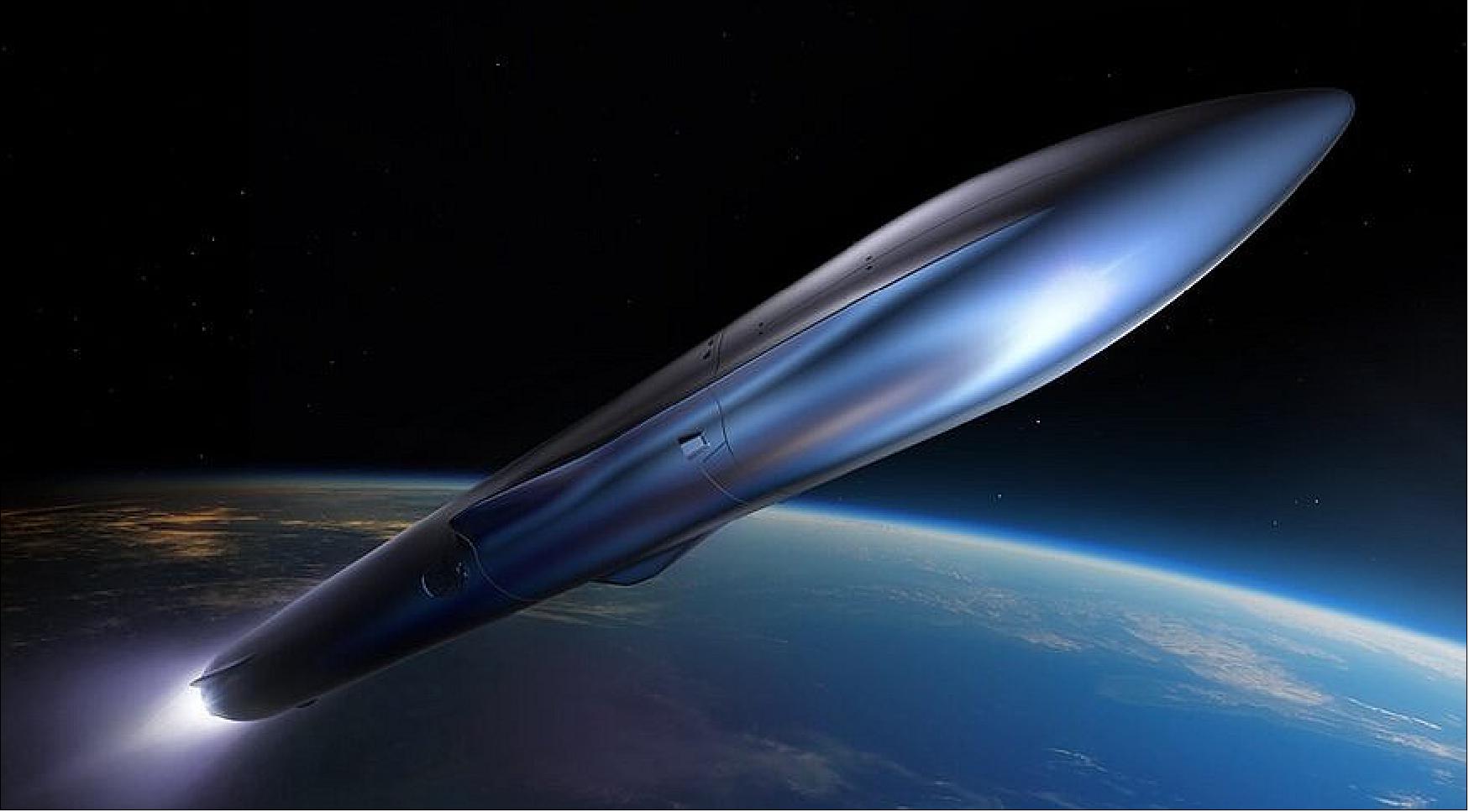
- Relativity Space announced that OneWeb signed a launch services agreement for multiple launches of OneWeb Gen 2 satellites on Relativity’s Terran R reusable launch vehicle under development. The companies declined to disclose details about the agreement, including the value of the contract and the number of launches included.
- OneWeb has disclosed few details about the planned Gen 2 constellation, although it is expected to feature far more satellites than the current generation of 648 satellites the company is deploying. Those future satellites will likely offer additional communications services and could also carry navigation payloads.
- The lack of details extends to the size of the satellites themselves. The companies declined to disclose how many satellites would fit on a Terran R, a rocket with a projected payload capacity in the same class as SpaceX’s Falcon 9.
- OneWeb is the first customer that Relativity has announced for the Terran R but the fifth overall. Tim Ellis, chief executive of Relativity, said in a written response to questions that the other four undisclosed customers are “are top satellite operators we are extremely excited about having on our manifest.”
- Ellis said that, among all customers, Relativity has orders for more than 20 Terran R launches, with a backlog the company valued at more than $1.2 billion. “The OneWeb agreement represents a large anchor customer with other significant customer agreements making up the total announced today,” he said. The other four customers each signed multi-launch agreements.
- Relativity announced the Terran R in June 2021 at the same time it disclosed a $650 million funding round. Terran R will be constructed using 3D-printing technologies the company has been working on since its inception. Both stages and its payload fairing will be reusable.
- The company is nearing the first launch of its smaller Terran 1 rocket. The vehicle is undergoing testing at Launch Complex 16 at Cape Canaveral Space Force Station ahead of a launch projected for later this summer. That mission, called “Good Luck, Have Fun” by the company, will not carry a payload.
- S Somanath, chairman of the Indian space agency ISRO, told reporters June 30 that two GSLV Mark 3 launches of OneWeb satellites are currently on the agency’s manifest, one for mid-September to October of this year and the other by January 2023.
• June 24, 2022: The in-space propulsion firm Busek Co. (Natick, MA) confirmed its supply of BHT-350 Hall effect thrusters for a range of missions supported by Airbus OneWeb Satellites (AOS). The Busek thrusters have been engineered and qualified to rigorous standards and are suitable for high-reliability, long-lifetime applications where thrusters are used for orbit raising, maintenance, and end-of-life de-orbit. 28)
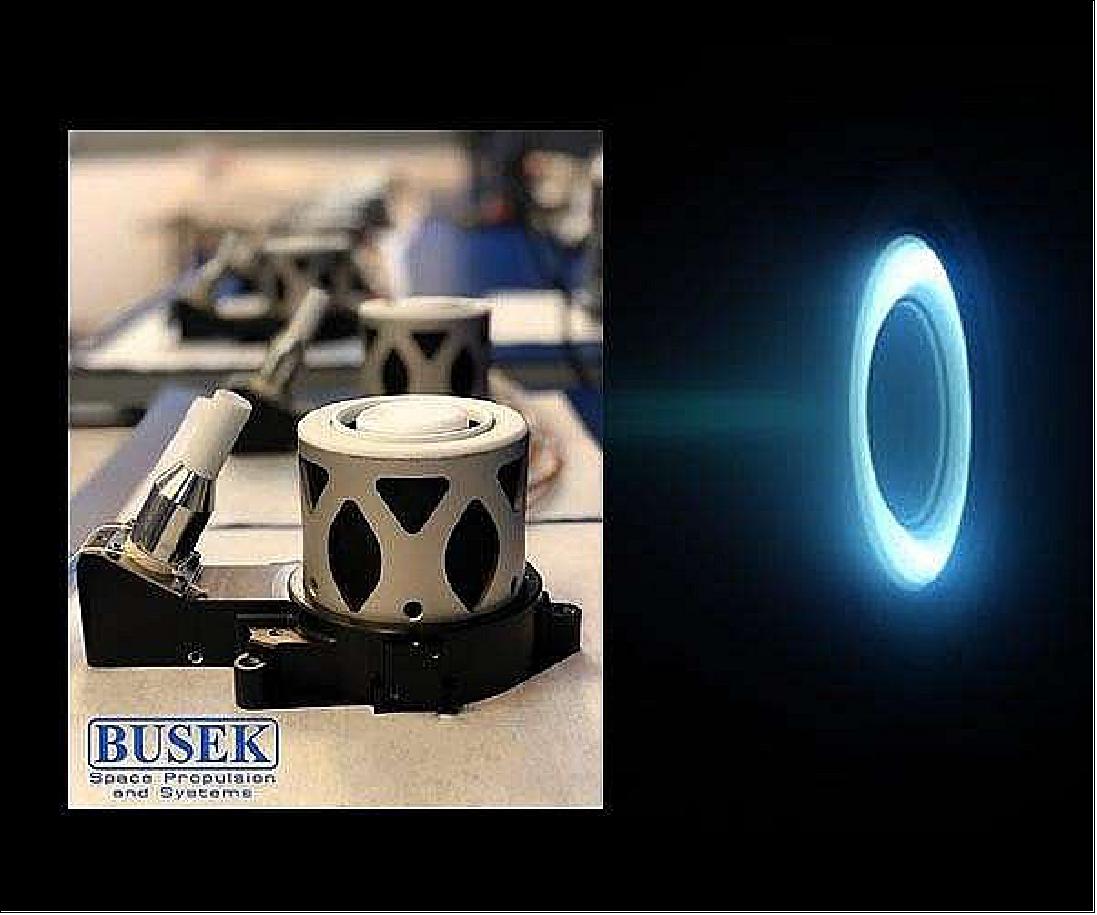
- "We have long been proud to support Airbus OneWeb Satellites' mission set. The BHT-350 is well-matched to a multitude of small satellite applications, where the design benefits from a proven supply chain, and an industrialized production line with 100% hot-fire acceptance testing." said Vlad Hruby, President of Busek.
- Busek and Airbus OneWeb Satellites have been working closely together since AOS began building out their supply chain, as thrusters are a key part of any spacecraft. Today the entire team is executing at speed to meet customer demand. AOS operates a state-of-the-art satellite production facility on Merritt Island, Florida, and has built and delivered over 400 spacecraft which are operating on-orbit today.
• May 27, 2022: The world’s first mission to remove several small telecommunications satellites from orbit once they reach the end of their operational service is about to start building and testing its prototype spacecraft. 30)
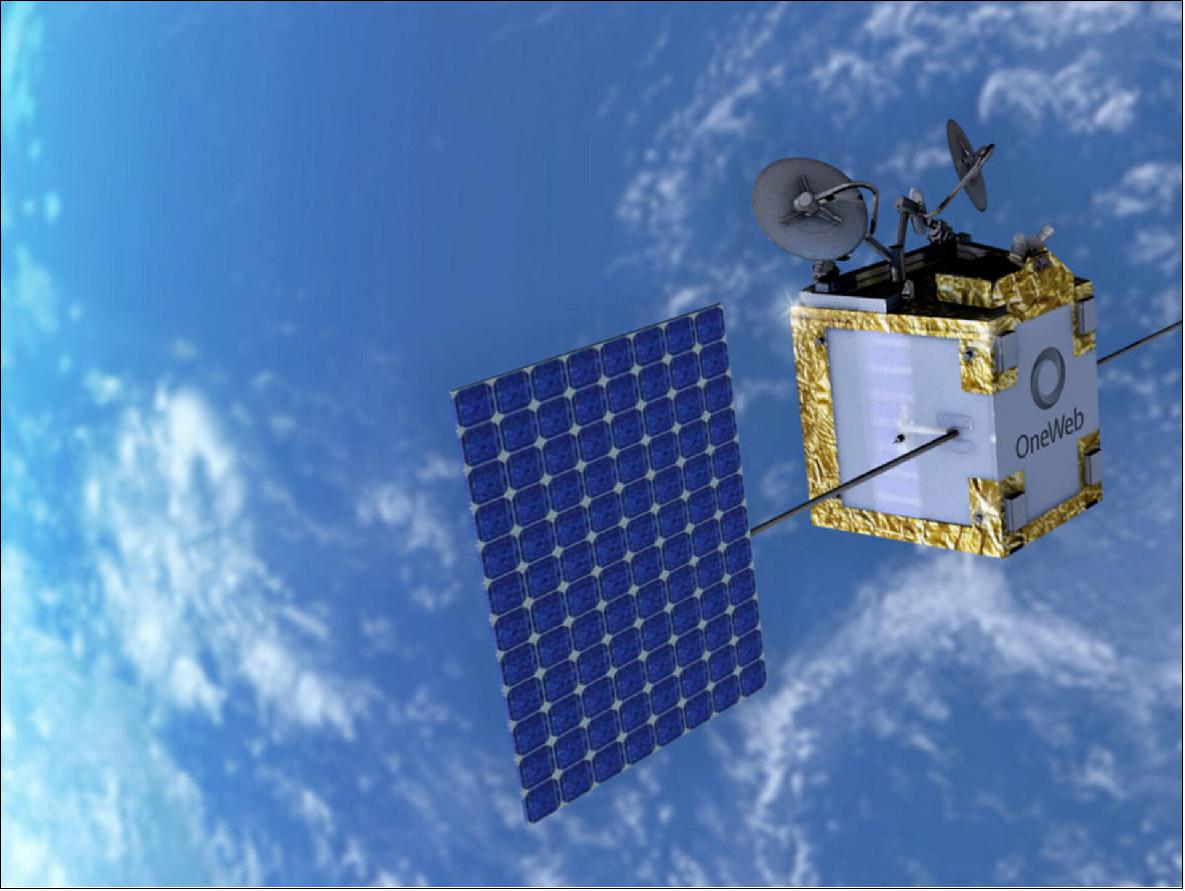
- British-based in-orbit servicing company Astroscale – working in an ESA Partnership Project with satellite operator OneWeb – will begin manufacturing the first commercial “servicer” prototype designed to capture multiple satellites in low Earth orbit under the ESA Sunrise Programme.
- Companies such as OneWeb are launching constellations comprised of hundreds of communications satellites to connect people in the hardest-to-reach locations through global satellite internet broadband services.
- OneWeb currently has 428 satellites orbiting approximately 1200 km above the Earth; its completed constellation will number almost 650 satellites.
- Removing these telecommunications satellites from their orbits once they are at the end of their lives is essential to ensure that today’s interconnected digital world is not compromised by collisions that damage active satellites in space – and to protect the low Earth orbit environment as a natural and shared resource.
- There are currently two options for removing end-of-life OneWeb satellites from their orbits at the end of their predicted five to six years of service.
- Each has been allocated enough fuel to be able to actively deorbit at the end of its useful lifetime. But, in case of failure, each has also been built with either a magnetic or a grappling fixture, so that a servicer spacecraft could collect and actively deorbit the satellite.
- The servicer spacecraft that Astroscale will build and test is called “ELSA-M” and is planned for launch in 2024. The servicer spacecraft will be the first “space sweeper” capable of removing multiple defunct satellites from their orbits in a single mission.
- Following this demonstration, Astroscale will offer a commercial service for clients that operate satellite constellations in low Earth orbit, providing the technology and capability to make in-orbit servicing part of routine satellite operations by 2030.
- ESA fosters innovation in the European space industry through its Partnership Projects, which seek to de-risk the investments of its industrial partners to meet market needs.
- UK Science Minister George Freeman said: “With thousands of satellites already in orbit and thousands more being launched every year, addressing the issue of space debris and finding new ways to remove defunct spacecraft and other types of space junk is of ever-increasing importance – to both reduce the cost of debris damage for satellite operators and ensure space is safe and sustainable.
- “That is why the UK government has made space sustainability a key theme of our National Space Strategy and it is fantastic to see leading roles for UK companies Astroscale and OneWeb in this ESA project, helping us continue to show UK technology leadership in this important area.”
- Paul Bate, Chief Executive of the UK Space Agency, said: “Space debris threatens the satellites we depend on every day for vital services, such as navigation, banking and communications.
- “That’s why the UK is taking action, by funding new commercial technologies to remove debris from space and working with international partners to lead efforts to promote sustainability. This latest phase of the Sunrise programme partnership between Astroscale and OneWeb will deliver an innovative spacecraft servicer to remove multiple defunct satellites, putting the UK at the forefront of efforts to clear up space.”
- Massimiliano Ladovaz, Chief Technology Officer at OneWeb, said: “Responsible space is central to our mission at OneWeb and we are committed to sustainable practices in all the environments in which we operate. The development of the ELSA-M servicer prototype is another significant milestone towards a responsible approach to space, ensuring that our satellites can be de-orbited and that the low Earth orbit environment is protected as a natural and shared resource.”
- John Auburn, Managing Director of Astroscale, said: “Phase 3 of the Sunrise programme is a major step forward for ELSA-M towards an in-orbit demonstration and the start of a commercial debris removal service, capable of removing multiple defunct satellites in a single mission. The ELSA-M in-orbit demonstration, planned for late 2024, will build on lessons learned from the ELSA-d mission and demonstrate our innovative rendezvous, capture and de-orbit capabilities with a full-size constellation client.”
- Elodie Viau, Director of Telecommunications and Integrated Applications at ESA, said: “It is vital to ensure the responsible use of space to protect today’s interconnected world, because our digital economy and society rely on the ability to communicate. I am proud of ESA’s track record in fostering innovation in the space industry in Europe, bringing to fruition new ways of ensuring the sustainable use of space, and of the role that ESA’s Partnership Projects play as a trusted partner for investors, operators and industry.”
- The ESA Sunrise programme is supported by the UK Space Agency and involves not only OneWeb and Astroscale, but also British start-up companies SatixFy and Celestia UK, as well as the University of Surrey.
• April 20, 2022: OneWeb has signed a contract to use India’s largest launch vehicle to deploy at least some of its remaining LEO broadband satellites this year, according to a company executive. 31)
- The U.K.-based megaconstellation startup said in a brief April 20 news release it has reached an agreement with New Space India Limited, Indian space agency ISRO’s commercial arm, that covers launches from Satish Dhawan Space Centre for an undisclosed number of satellites.
- “The first launch with New Space India is anticipated in 2022 from the Satish Dhawan Space Centre (SDSC) SHAR, Sriharikota. The launches will add to OneWeb’s total in-orbit constellation of 428 satellites, 66 per cent of the planned total fleet,” OneWeb said in a statement.
- Chris McLaughlin, chief of government, regulatory affairs and engagement at OneWeb, told SpaceNews the company plans to use India’s Geosynchronous Satellite Launch Vehicle (GSLV). — He declined to disclose further details.
- India last launched a GSLV Mark 3 in 2019 as part of the country’s Chandrayaan-2 lunar exploration mission.
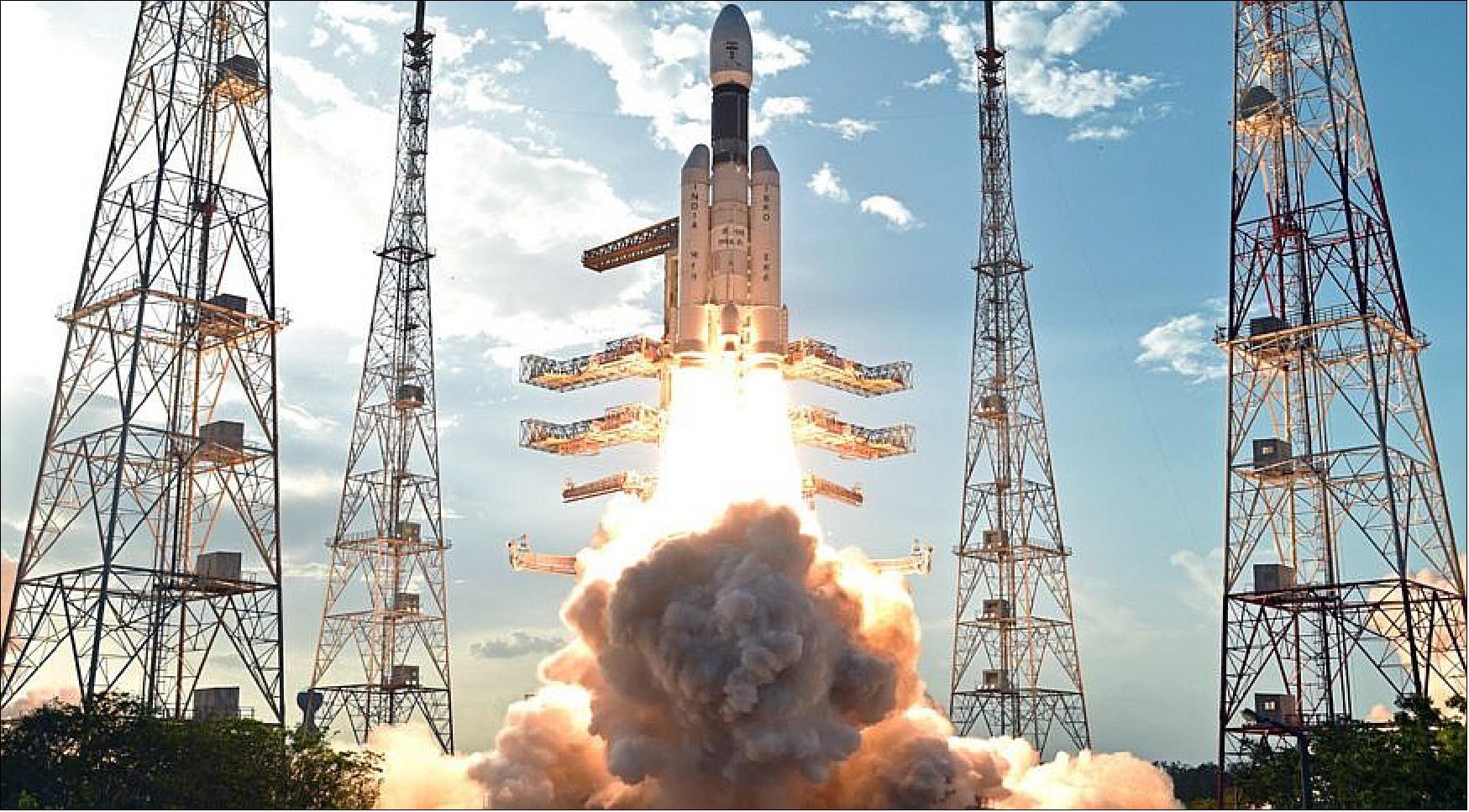
• March 22, 2022: Australian communications company Telstra announced plans March 22 to build and maintain three dedicated teleports to provide satellite gateway services in the Southern Hemisphere for OneWeb’s broadband constellation. 32)
- The teleports, spread across Australia, are being built as part of a 10-year agreement between Telstra and OneWeb announced at the Satellite 2022 conference.
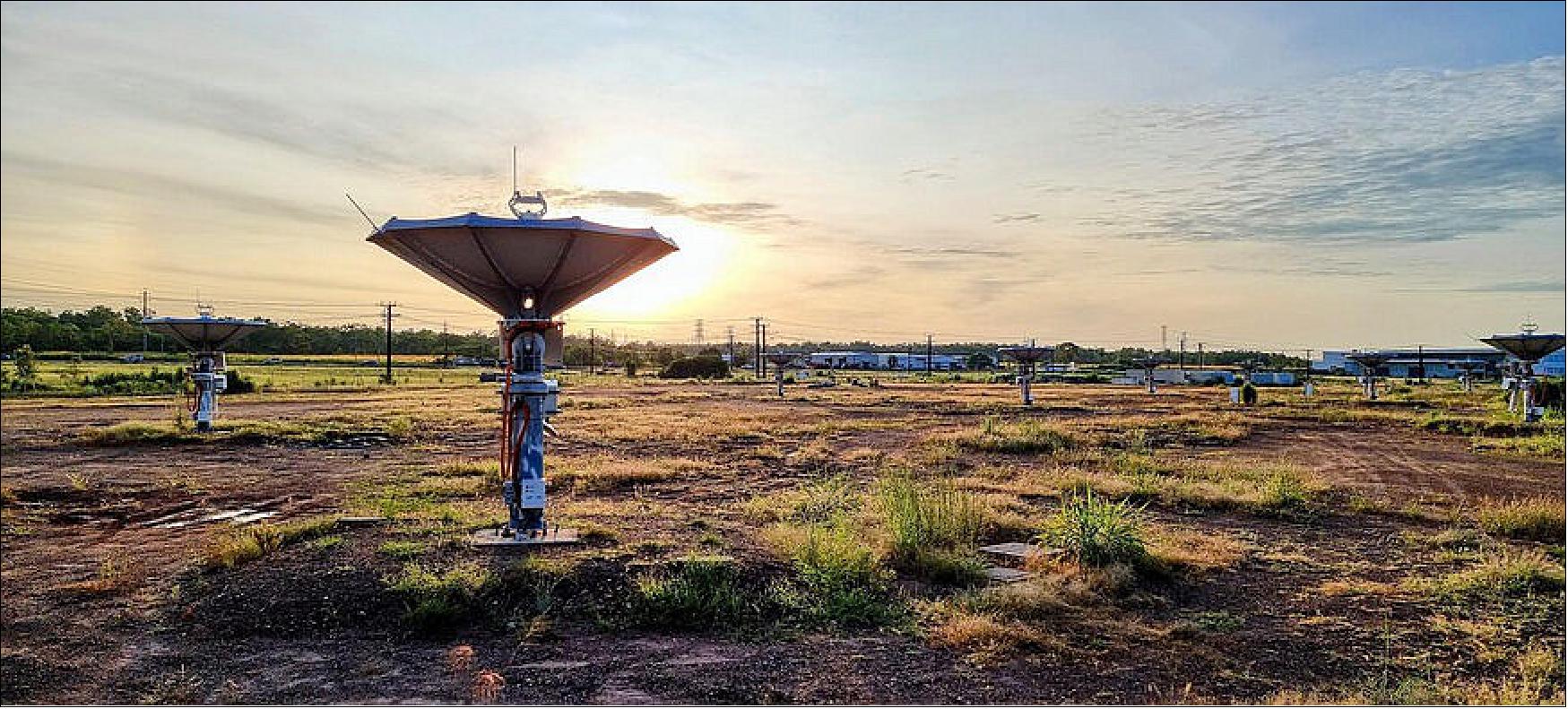
- Satellite constellation operators continue to forge ties with telecommunications companies that own and operate terrestrial and subsea assets, including fiber networks, IP backbones and data centers.
- The first OneWeb teleport, scheduled to begin operations in July, is located in Darwin Tivendale. Telstra plans to complete work on two additional sites in Charlton Toowoomba and Wangara, Perth, Western Australia later this year. Each facility is designed to provide turnkey ground station support for OneWeb’s growing fleet of low-earth orbit satellites.
- “OneWeb had exacting requirements from the outset, and we worked in close partnership with them from site selection through construction,” Vish Vishwanathan, Telstra Americas vice president for wholesale and satellite, said in a written statement. “Teleports are complex sites involving access to secure and resilient infrastructure and on-the-ground expertise, which Telstra has provided to OneWeb throughout this project.”
- OneWeb has 428 satellites in orbit, about two-thirds of its constellation. For now, OneWeb is providing coverage above the 50th parallel North, reaching areas in Alaska, Canada and the Arctic that often lack broadband.
- “Low Earth Orbit satellite technology is transforming the global connectivity landscape, not only by creating new business opportunities, but also giving more businesses, communities and governments the internet access they need for progress,” Michele Franci, OneWeb chief of delivery and operations, said in a statement. “More connectivity options benefit everyone and our approach in establishing strategic partnerships with experienced providers like Telstra is core to how we deliver the OneWeb mission.”
- Earlier this month OneWeb and Telstra announced a memorandum of understanding to look at ways to improve digital connectivity for Telstra customers in Australia and the Asia Pacific region.
- “We see lots of opportunities for our consumer, small business and enterprise customers using LEO satellite connectivity – from backhaul to back-up for resiliency, from internet of things to supporting emergency services, from home broadband to supporting agritech,” Andrew Penn, Telstra CEO said in a statement.
• February 3, 2022: After the successful launch of NASA’s Webb Space Telescope on December 25 with Ariane 5, Arianespace is back to the Guiana Space Center (CSG) with Soyuz for a February 10 lift-off. 35)
- The first Arianespace mission of the year will orbit 34 additional OneWeb satellites.
- With this mission, Arianespace will exceed 100 satellites launched on Soyuz from the CSG, while OneWeb’s fleet will be brought to 428 satellites on Low Earth Orbit.
- Scheduled for February 10 at 03:09 p.m. local time (06:09 p.m. UTC), Arianespace’s Soyuz Flight VS27 will mark the European launch service provider’s first flight of the year. Performed from the Soyuz Launch Complex (ELS) at Sinnamary, French Guiana, Flight VS27 will put 34 of OneWeb’s satellites into a near-polar orbit at an altitude of 450 km. The total duration of the mission will be 3 hours and 33 minutes and will include nine satellite separations, after which the satellites will subsequently raise themselves to their operational orbit.
- This thirteenth launch for OneWeb will deliver high-speed, low-latency connectivity services to a wide range of customer sectors including aviation, maritime, backhaul services, as well as governments, emergency response services and more. Central to its purpose, OneWeb seeks to bring connectivity to every place where fiber cannot reach, and thereby bridge the digital divide.
- Once deployed, the OneWeb constellation will work with user terminals that are capable of offering 3G, LTE, 5G and Wi-Fi coverage, providing high-speed access globally – by air, sea and land.
- The next OneWeb missions through 2022 will enable the start of OneWeb’s global services this year.
- OneWeb Satellites, a joint venture between OneWeb and Airbus Defence and Space, is the constellation’s prime contractor. The satellites were built thanks to its leading-edge satellite manufacturing process that can build up to two satellites a day on a series production line dedicated to the assembly, integration, and testing of the satellites.
- Arianespace offers proven launch solutions, fully adapted to the requirements of constellations and validated by the market. The 34 OneWeb satellites on Flight VS27 will be the 561st to 594th constellation satellites launched by Arianespace and will put at over 100 the number of satellites launched on Soyuz from the CSG.
• January 20, 2022: OneWeb has signed a deal to distribute broadband in India through a local partner as it hopes to get regulatory permission for its low Earth orbit services this year. 36)
- The megaconstellation operator said Jan. 20 it has struck a six-year distribution partnership with Hughes Communications India Private Ltd (HCIPL), a recently formed joint venture between Indian telco Bharti Airtel and U.S.-based Hughes Network Systems.
- Bharti Airtel is owned by Bharti Global, which is OneWeb’s largest shareholder, and Hughes is a minority investor in OneWeb that is also developing gateways for the operator in India and elsewhere.
- HCIPL is India’s biggest satellite service operator with more than 200,000 VSATs in the country, the joint venture owners said Jan. 4 when they announced the company’s formation.
- Some 135,000 of those VSATs come from Hughes which owns about a third of HCIPL and the rest come from Airtel, Hughes Network Systems president Pradman Kaul told SpaceNews in an interview.
- The VSATs currently connect to satellites in geostationary orbit (GEO), but Kaul said HCIPL plans to introduce multi-orbit capabilities once OneWeb gains regulatory clearances to operate in the country.
- SpaceX’s LEO broadband operator Starlink also requires regulatory permission to deploy services in India.
- Sanjay Bhargava, Starlink’s former lead executive in India, said late last year that the company hoped to have applied for a commercial license on or before Jan. 31, 2022. Bhargava recently announced he had resigned from the company, shortly after India’s government ordered SpaceX to stop preselling Starlink until it gives regulatory approval.
- For OneWeb, Kaul said regulatory approval in India “should happen hopefully in the next three to six months.”
- He pointed to broad transformation across India’s regulatory landscape as rules are being relaxed to encourage investments in the space industry.
- Bharti only owns about a third of U.K.-based OneWeb, and its other shareholders are based outside of India.
- Kaul said that means OneWeb is set to become one of the first foreign satellite operators permitted to serve India on a long-term basis.
- Foreign operators are sometimes allowed to lease capacity temporarily to India’s Department of Space, when the country cannot meet demand with domestically operated satellites.
- However, Pradman said “the conditions are very onerous and don’t encourage investment.”
- He said the shifting regulatory landscape is encouraging Hughes Network Systems to explore a high-throughput GEO satellite for India, similar to the company’s Jupiter 3 for North America that an undisclosed launch provider is slated to loft in the second half of 2022.
- “We definitely will start looking at that, but it’s not the most important thing right now,” Pradman said.
- “Right now we want to integrate the LEO OneWeb capability with our existing GEO network, and make them all play together and start offering services.”
- OneWeb has so far deployed more than 60% of the 648 satellites in its planned constellation, with the remaining satellites slated to launch this year for global connectivity services.
- The company has announced a raft of distribution partners worldwide to expand its services.
- Most recently, Australian telecoms carrier Field Solutions said Jan. 19 it will offer OneWeb’s services to rural, regional, and remote Australia under a distribution partnership.
• November 2, 2021: BT (British Telecom) Group PLC of London and OneWeb have agreed terms for a new Distribution Partner Agreement, with OneWeb to provide Low Earth Orbit (LEO) satellite communication services across BT Group. This builds on an initial Memorandum of Understanding signed in July and means BT is testing how LEO satellite technology integrates with its existing terrestrial capabilities to meet the communications needs of customers. On successful completion, BT will commence the first live trials with customers from early next year. The partnership will span a growing range of connectivity solutions around the world as well as specific opportunities for the UK market. 37)
- Philip Jansen, Chief Executive of BT Group, said: "Space is an emerging and enormous digital opportunity, and this is an important step towards harnessing its potential for BT's customers across the globe. We will put OneWeb's technology through its paces in our UK labs with the goal of delivering live trials in early 2022. Delivered securely and at scale, satellite solutions will be an important part of our plans to expand connectivity throughout the UK and globally, and to further diversify the range of services we can offer our customers."
- OneWeb's Chief Executive Officer Neil Masterson said: "BT has taken the lead in the recognition of LEO satellite's advantage. We are delighted as this agreement with BT Group represents an important strategic partnership for OneWeb as we continue to make progress towards our operational launch. We are excited to be playing such a key role in improving the resilience of the overall telecom infrastructure in the UK. OneWeb's connectivity platform will help bridge the last digital divides across the country and enhance the nation's digital infrastructure."
- OneWeb is expected to deliver global coverage by June 2022 through a constellation of 648 LEO satellites and is poised to deliver services from the North Pole to the 50th parallel, covering the entire United Kingdom, later this year. The new partnership supports BT's wider network ambition, set out in July this year, to deliver digital solutions across the entire UK by 2028, through a combination of an expanded network and 'on demand,' requestable solutions anywhere beyond. In building a converged, software-defined network, BT will leverage and integrate both terrestrial and non-terrestrial technologies to deliver on the goal of seamless, ubiquitous connectivity.
- This agreement marks a clear path towards the first LEO solutions being available for customers within a year. As the next step, BT will test capabilities in its Bristol lab to demonstrate how they integrate with existing services. Current capacity levels within OneWeb satellites mean initial trials will focus on its role as a supplementary, low latency backhaul solution to sites where additional capacity or a back-up solution is required, and to deliver improved resilience for business customers.
- On successful completion, BT will begin early adopter trials for UK and international customers, expected early next year. As OneWeb grows their capacity, the list of future use cases could also widen, opening up the opportunity to explore the use of satellite for IoT backhaul and Fixed Wireless Access in rural areas.
- The work with OneWeb shows the capabilities being developed by UK businesses in the pioneering area of space technology and follows the UK Government's recently published National Space Strategy, which recognizes the enormous strategic opportunities on offer. BT, which boasts a heritage of nearly 60 years in space and satellite communication innovation, continues to explore a diverse range of partners across all its services, including space, to ensure the latest and best connectivity solutions are available for customers.
- About BT: BT Group is the UK's leading telecommunications and network provider and a leading provider of global communications services and solutions, serving customers in 180 countries. Its principal activities in the UK include the provision of fixed voice, mobile, broadband and TV (including Sport) and a range of products and services over converged fixed and mobile networks to consumer, business and public sector customers. For its global customers, BT provides managed services, security and network and IT infrastructure services to support their operations all over the world. BT consists of four customer-facing units: Consumer, Enterprise, Global and its wholly-owned subsidiary, Openreach, which provides access network services to over 650 communications provider customers who sell phone, broadband and Ethernet services to homes and businesses across the UK.
• October 27, 2021: Satellite broadband startup OneWeb and a company backed by Saudi Arabia’s sovereign wealth fund have signed a $200 million joint venture, with exclusive rights to distribute the network’s capacity in targeted Middle East regions. 38)

- OneWeb said Oct. 26 it is partnering with NEOM Tech & Digital Holding Company, a business entity Saudi Arabia created as part of an effort to develop a planned modern city and tourist destination in the northwest of the country.
- The OneWeb partnership is part of NEOM’s goal to secure access to tens of terabytes of scalable capacity by 2030, helping it attract urban and rural businesses and communities to the region. In addition to OneWeb’s low Earth orbit (LEO) satellites, the strategy includes the construction of subsea and terrestrial communications cables, 5G cellular towers and fiber networks.
- NEOM is spending $170 million to buy satellite capacity from OneWeb under a seven-year contract.
- The holding company is also investing $30 million in a joint venture with OneWeb that will resell the capacity in Saudi Arabia, the broader Middle East and neighboring East African countries.
- With more than half its 648-strong satellite constellation deployed to date, OneWeb expects to launch commercial services in the upper part of the Northern Hemisphere this year, with global services to follow in 2022.
- However, OneWeb expects its contract with NEOM to exclusively distribute its services in target regions to commence in 2023.
- “This agreement includes a ground station in NEOM so the timeline reflects the need to buil[d] that but we will commence global services in 2022,” a OneWeb official said via email.
- At 348 satellites, OneWeb said it is the second-largest LEO operator and the only one licensed in Saudi Arabia.
- SpaceX’s Starlink broadband constellation is currently the largest in LEO with more than 1,600 in-orbit so far.
- OneWeb said its joint venture with NEOM builds on an agreement it signed with Saudi Arabia’s Ministry of Communications and Information Technology (MCIT) back in 2017, when they agreed to collaborate on solutions to extend connectivity to more homes across the country.
- NEOM will help test and develop satellite-based cybersecurity solutions under the joint venture announced Oct. 26, in addition to positioning and navigation capabilities that OneWeb is exploring for the U.K. government.
- The British government is an investor in OneWeb, and the venture said the partnership with NEON also strengthens ties between Saudi Arabia and the U.K.
- “This joint venture brings together two emerging space and digital technology champions to deliver connectivity for the Middle East,” U.K. Investment Minister Gerry Grimstone said in a statement.
- “It demonstrates that the UK Government’s investment in OneWeb continues to be a catalyst for international collaboration, while securing jobs at home and driving investment into the UK space sector.”
• October 11, 2021: Bharti-backed OneWeb, the low Earth orbit satellite communications company, today announced an arrangement through Letter of Intent with NewSpace India Limited (NSIL), the commercial arm of Indian Space Research Organisation (ISRO), to use the Indian-built PSLV (Polar Satellite Launch Vehicle) and the heavier GSLV-MkIII (Geosynchronous Satellite Launch Vehicle) as potential platforms to launch OneWeb’s satellites in India from 2022. 39)
- The non-binding Letter of Intent was unveiled at the launch of Indian Space Association (ISpA) in the presence of the Hon’ble Prime Minister of India Sh. Narendra Modi. OneWeb is amongst the founding members of ISpA, which strives to be the collective voice of space and satellite companies in India and will work with stakeholders across for the development of India’s space ecosystem.
- OneWeb is building its initial constellation of 648 LEO satellites and has already put 322 satellites into orbit. Services will begin this year to the Arctic region including Alaska, Canada, and the U.K.
- By late 2022, OneWeb will offer its high-speed, low latency connectivity services in India and the rest of the world. Service testing on the satellites already in orbit is underway. The results are positive, including seamless satellite and beam handovers, high speeds and low latency.
- OneWeb and NSIL will expeditiously convert the Letter of Intent into a binding agreement after obtaining all necessary approvals from their respective Boards.
- Comments OneWeb Chairman, Sunil Bharti Mittal: “ISRO has built formidable launch capabilities and India is part of the select group of countries to have history of successful launches. OneWeb will be delighted to use ISRO’s proven platforms to fulfil its vision of taking broadband connectivity across the earth, oceans and sky. We believe this initiative will further the Hon’ble Prime Minister’s vision of making India a key hub in the global space ecosystem and also boost the India-U.K. strategic partnership. We look forward to a deeper engagement with NSIL/ISRO over the coming years.”
- Says Dr. K. Sivan, Chairman of ISRO: “We are delighted to have OneWeb looking into how our launch capabilities can help meet their global ambition to connect people everywhere. We are making tremendous progress and India is advancing its space capabilities and we look forward to working together.”
- OneWeb will undertake its 11th launch on the 14th of October with a further 36 satellites on board. In under a year, the company has passed the halfway stage of its first generation constellation with 322 satellites now in space.
• October 6, 2021: Eutelsat Communications (Euronext Paris: ETL) has exercised a call option on a portion of the latest OneWeb funding round subscribed by Bharti, for a consideration of $165 million, taking its shareholding from 17.6% to 22.9%. 40)
- The transaction was undertaken on identical financial terms to Eutelsat’s initial investment of $550 million announced in April and completed on 8 September. The completion of this latest transaction is expected around year-end 2021 subject to regulatory authorizations.
- Since Eutelsat’s initial investment, OneWeb has gained significant traction, both operationally, with a 100% launch success rate leading to nearly half of the constellation now in orbit, and commercially, with numerous distribution partnerships secured ahead of its partial entry into service, which remains on track for end-2021.
- In the meantime, as already announced by the company, OneWeb’s capital structure has been further strengthened with an additional $500 million commitment by Bharti completing the funding of its first-generation constellation and a $300 million capital injection from South Korea’s Hanwha.
- Following the exercise of the call option and the completion of Hanwha’s investment, Eutelsat’s 22.9% holding will make it the second largest shareholder behind Bharti with 30.0%, thereby strengthening its position as a key shareholder and partner of OneWeb.
- Eutelsat’s investment comes after it delivered a strong FY 2021 performance in terms of cash flow generation and leverage reduction, and is compliant with Eutelsat’s financial framework. At 30 June 2021, Eutelsat’s liquidity amounted to €1.9bn in cash and undrawn credit lines.
- Commenting on the transaction, Rodolphe Belmer, Eutelsat’s Chief Executive Officer stated: “We are hugely excited to grasp this opportunity to deepen our commitment to OneWeb. The significant progress it has made in the run-up to its now imminent entry into service, together with the vote of confidence demonstrated by the commitment of both its investors and future customers, makes us even more convinced of OneWeb’s right-to-win in the low earth orbit (LEO) constellation segment.”
• September 16, 2021: Under a new agreement with U.S. defense contractor Peraton, OneWeb’s satellite communications services will be more widely available to military users in hard-to-reach areas, including ships at sea. 41)
- Low Earth orbit satellite communications “is a game-changing capability for maritime, aviation, defense and other customers operating in remote environments outside of standard network coverage areas,” said Nate White, Peraton’s vice president and general manager of communications.
- Peraton is a systems integrator that provides managed satcom services to the government. The Pentagon frequently turns to integrators to stitch together networks from multiple vendors. Leonardo DRS Global Enterprise Solutions provides similar services.
- White said the U.S. military typically wants network services that combine satellites in geosynchronous, medium and low orbits. He noted that until OneWeb came online, Iridium was the only LEO-based satellite service available to the military and there is a huge demand for low-latency communications.
- “Military customers want almost the ease of a cell phone, with one interface to multiple networks so we’re working to be able to do that so they’re not having to go buy from individual service providers,” he said.
- Most of the military demand for satcom comes from the U.S. Army that has forces deployed in areas where there is limited telecom infrastructure. The Navy increasingly is looking for additional satcom capacity for ships at sea, White said. “OneWeb brings a lot more bandwidth to bear. With LEO systems, you don’t have these 300 millisecond round trip delays that you see in GEO satellites, so you’re going to have a conversation or get data moved at speeds closer to what a wired network does.”
- OneWeb’s planned constellation of 648 satellites is almost half way complete. Since the company emerged from bankruptcy in November and continued to build its network, it has signed global distribution partnerships and strategic agreements with AT&T, Hughes Network Systems, Alaska Communications, BT, Northwestel, and now Peraton.
- The company said it will start service this year at the 50th parallel and above, and reach global coverage in 2022.
- White said he expects the Navy and the Coast Guard to add LEO services to their satcom contracts. The maritime forces primarily rely on Inmarsat when they’re at sea and they need more bandwidth.
- With the new LEO systems, “you’re going to be able to connect a ship with as much as a gigabit per second of connectivity while at sea,” he said. “Now you start talking about maybe giving sailors live streaming over Netflix. There are very few providers that cover the big open ocean.”
- One of the challenges of bringing LEO satcom into the military are the user terminals. Current terminals are not interoperable with multiple satcom providers, creating a logistics problem for the military.
- “If you’re going into Africa or the Middle East, there’s only so much space on a C-17 or C-5 transport aircraft,” he said. “They can’t be bringing thousands of different terminals. We don’t want that. It creates a lot of challenges from a logistic support standpoint.”
- OneWeb’s user terminals, made by Intellian Technologies and Collins Aerospace, are about the size of a briefcase. But the military wants terminals that are smaller and also can talk to GEO satellites and other networks. “Kymeta is moving down that path and I think they’re shaking up the market a little bit,” White said.
- “Customers want one interface device that will access many different networks,” he said. “Everybody’s looking for bandwidth portability. But I think it’s going to be another five years or so before we start to see a lot more of that.”
• September 8, 2021: AT&T has agreed to use OneWeb’s low Earth orbit satellites to extend high-speed broadband services to areas outside its fiber footprint in the United States. 42)
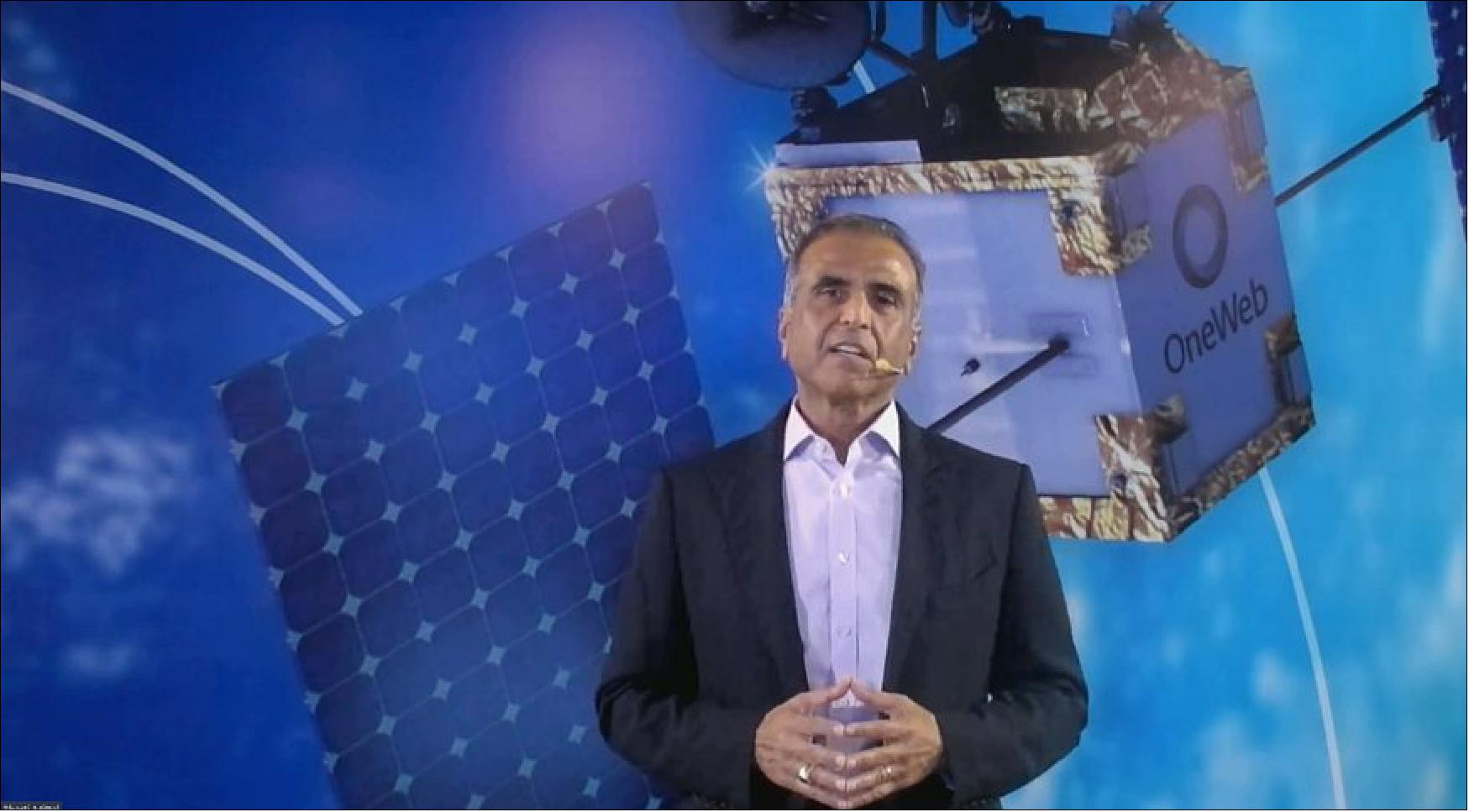
- Their partnership will focus on bolstering connectivity solutions for business and government customers, while also leveraging satellites to connect hard-to-reach cell towers across the country.
- AT&T provides high-speed connectivity to more than 2.5 million business in the U.S., according to the company, and more than nine million business customer sites are within 1,000 feet of its fiber network.
- However, the telco highlighted the many remote areas where it is too expensive or geographically challenging to expand high-speed fiber networks.
- OneWeb executive chair Sunil Bharti Mittal, who announced the agreement in his Satellite 2021 keynote Sept. 8, said the “U.S. market now has a huge distributor in the form of AT&T.”
- Asked about the services AT&T will provide through the OneWeb partnership, he first highlighted the potential to provide faster and more reliable cellular backhaul.
- Higher quality cellular backhaul “will allow [AT&T] to put up base stations where none exist today,” Mittal said.
- He also underlined the potential to improve AT&T’s enterprise services, as well as “the government delivery of various kinds of broadband services,” pointing to the billions in subsidies the Federal Communications Commission provides through the Rural Digital Opportunity Fund as justifying OneWeb’s vision and business plan.
- “That means there are still very large parts of the U.S. which remain unconnected or poorly connected,” he noted.
Looking for more partners
- Mittal said OneWeb is holding “dozens of conversations in very advanced stages” with other telecom partners.
- The company had earlier announced a distributor partnership with British telco BT June 27.
- Mittal is founder and chair of Indian conglomerate Bharti, a OneWeb investor that also owns a sizable India-based telecoms company called Airtel.
- He told the conference that Airtel will partner with OneWeb to cover India, Southeast Asia and many countries in sub-Saharan Africa.
- With nearly half of its 648-strong constellation deployed so far, he said OneWeb expects to launch partial services in the Northern Hemisphere in the next 60-90 days.
- Mittal said Alaska “will probably go first with our services,” adding that OneWeb has also partnered with local telco Alaska Communications.
- OneWeb plans to launch full commercial services in 2022, and Mittal said it expects to have signed up a telecom operator in every country as it works on gaining worldwide market access.
- He highlighted stiff regulatory conditions in 30 countries in particular, of which OneWeb has been able to penetrate 12-13 of them.
- “They are very large markets, some of them,” he continued.
- “We need the permission to put up our .... ground stations, we need the permission to use the spectrum in their countries. We need the permission to go and access the market and provide the services.”
- Bharti is U.K-headquartered OneWeb’s largest investor in an international mix of shareholders that includes the British government, Japanese internet giant Softbank, French satellite operator Eutelsat, U.S.-based antenna specialist Hughes Network Systems and — more recently — South Korea’s Hanwha.
- Eutelsat said Sept. 8 that it closed a $550 million equity investment in OneWeb that it announced in April.
- If Bharti and Hanwha’s investments also close as expected following regulatory approvals, Eutelsat would own 17.6% of OneWeb.
- OneWeb also announced Sept 8 the appointment of Air Vice-Marshal Chris Moore as vice president of international government and trade engagement to its government and regulatory affairs team.
- Moore spent three decades at the U.K.’s Royal Air Force, and was the MOD’s director of operations for defence’s core IT services between 2017 and 2021.
- “His sectoral knowledge, spectrum engineering, and real-time application of satellite connectivity, alongside a deep cyber-security background, are of great benefit as we roll-out our global services,” stated OneWeb CEO Neil Masterson.
• August 25, 2021: South Korean antenna maker Intellian Technologies, a major supplier to British satellite broadband startup OneWeb, is planning to build its second manufacturing plant by May 2022 to meet increasing demand for user terminals for low Earth orbit broadband. 43)
- Intellian unveiled the plan Aug. 23, saying it will spend 30 billion won ($25.6 million) on building the new plant near the firm’s headquarters in the Jinwi Industrial Complex, Pyonegtaek, Gyeonggi Province. Its construction will begin in October, according to the company.
- “To build the new plant is part of efforts to ensure a stable supply to OneWeb,” Intellian said in a statement. “We see an increasing demand for user terminals for low Earth orbit broadband as competition among satellite-based communications providers intensifies and their business grows faster than expected.”
- The second plant, whose size is nearly 6,000 m2, will house production lines for user terminals for LEO broadband and gateway antennas, according to the company. The existing first plant is in the company’s headquarters.
- When the second plant becomes operational, an Intellian official told SpaceNews, the combined production capacity of the two plants will be “about 2.5 times higher than present.” The official declined to give details.
- Intellian is a major antenna supplier to OneWeb. The two have signed three contracts since 2019 — in August 2021, March 2021, and December 2019 — with a combined value of nearly 113.4 billion won ($97 million).
- In July, Intellian opened its European headquarters and logistics center in Rotterdam, the Netherlands, underpinning its commitment to the European market. The company also contributed to developing a briefcase-sized electronically steered user terminal called OW1, which OneWeb unveiled Aug. 24 during the 36th Space Symposium in Colorado Springs, Colorado.

• August 24, 2021: OneWeb has unveiled a briefcase-sized electronically steered user terminal called OW1, which it says is the smallest yet that is capable of connecting to its LEO (Low Earth Orbit) constellation. 44)

- The startup plans to integrate the flat-panel antenna with a OneWeb satellite modem in a sealed outdoor unit for distribution later this year.
- OW1 was developed in partnership with South Korean antenna maker Intellian Technologies and Collins Aerospace, a subsidiary of Raytheon Technologies.
- OneWeb has said it has plans in place to develop a range of antennas, comprising flat panels and dual parabolic dishes, to support a LEO broadband constellation of nearly 650 satellites.
- OW1’s unveiling comes after Intellian announced a US$73 million contract with OneWeb March 8 to develop and supply compact user terminals.
- The flat-panel antenna is 50 x 43 x 10 cm, according to OneWeb, weighing around 10 kg.
- The outdoor antenna is designed to connect to an indoor unit through a single combined power and data cable, enabling connectivity to devices including laptops and routers.
- “The OW1 is our first flat-panel antenna, following years of investment in R&D, expanding our comprehensive OneWeb portfolio,” said Intellian CEO Eric Sung.
- Intellian has teamed up with Hughes Network Systems to demonstrate managed satcom services in strategic Arctic locations for the U.S. Air Force Research Laboratory (AFRL).
- OneWeb has also partnered with Israel antenna maker SatixFy to build terminals for aircraft to enable in-flight connectivity services.
- On Aug. 12, OneWeb said it had received a $300 million strategic investment from Hanwha, the South Korean conglomerate that bought British antenna startup Phasor Solutions last year.
- It remains unclear how OneWeb could integrate Hanwha’s antennas into its infrastructure.
- “We will be working with a number of user terminal providers and look forward to learning more about Hanwha’s products,” a OneWeb spokesperson said.
- The investment from Hanwha gives OneWeb $300 million on top of the $2.4 billion it had already secured, which it said completed the constellation’s funding.
- OneWeb CEO Neil Masterson told SpaceNews on the sidelines of Space Symposium in Colorado that the company has not yet decided how to deploy the extra cash.
- “First of all, it’s always good to have dry powder in any business, and particularly these sorts of businesses,” Masterson said.
- He said the funds could be used to accelerate market penetration, for acquisitions or deploy a second-generation constellation faster.
- Arianespace successfully launched an extra 34 satellites for OneWeb’s first-generation network Aug. 21.
- At 288 satellites so far, OneWeb has deployed 44% of its constellation, ahead of planned services before the end of this year to Canada, the U.K. and Northern Europe.
- The operator plans to provide global services for enterprise and government customers in 2022.
• August 12, 2021: Hanwha, the South Korean Fortune 500, global technology and manufacturing company has announced a USD $300m equity investment by Hanwha Systems (“Hanwha”) in OneWeb, the Low Earth Orbit (LEO) satellite communications company. Hanwha brings further defence capabilities and the latest antenna technologies to OneWeb, alongside relationships to new government customers and expanded geographical reach. 45)
- This investment brings OneWeb’s total equity investment since November 2020 to USD $2.7bn with no debt issuance. The investment is expected to be completed in the first half of 2022, subject to regulatory approvals.
- OneWeb’s first generation fleet of 648 satellites that will deliver global coverage in 2022 is fully funded. To date, the company has launched 254 satellites into orbit, with another launch planned this August from Baikonur, Kazakhstan. Thanks to the success of recent launches, OneWeb’s network will be ready to offer connectivity services from 50th parallel and above by the end of 2021.
- Sunil Bharti Mittal, Founder and Chairman of Bharti Enterprises, said: “We welcome Hanwha to OneWeb. These are exciting and fast paced times in the space sector. With Hanwha alongside, we will be able to access the highest quality of technological thinking and development. They are a powerful partner in our global mission to connect the world.”
- Youn Chul KIM President, Chief Executive Officer and Director at Hanwha Systems said: "We are pleased to join hands with OneWeb, which has strength in the LEO communication area, the core of space business. To OneWeb ‘s vision of connecting all the people across the globe, Hanwha System’s satellite and antenna technology will bring more advantages."
- UK Business Secretary, Kwasi Kwarteng said: “Today’s $300m investment in OneWeb by Hanwha is the latest in a series of votes of confidence in the company from the market. It’s clear that leading global investors see a promising future for this ground-breaking company and a robust commercial case for investment.
- “The Government’s equity stake in OneWeb not only allows the UK to capitalise on our first-mover advantage to deploy low Earth orbit technology but will put our country at the forefront of the small satellite market, which is set to rapidly expand over the years ahead.”
- Neil Masterson, Chief Executive at OneWeb, said: “Hanwha brings advanced defence and antenna technology development to the OneWeb line-up. We are all delighted that they have chosen to join us on this journey of innovation, shaping a global service to connect the most remote locations and to provide a critical digital pathway from space to our interconnected world.”
- On completion, OneWeb will appoint a Board Director to represent Hanwha’s share in the Company.
• August 12, 2021: The next Arianespace mission is planned from Baikonur Cosmodrome with Soyuz on August 20 (local time), to deliver 34 satellites into orbit bringing the total OneWeb’s fleet to 288 satellites in Low Earth Orbit. 46)
- This 59th Soyuz mission conducted by Arianespace and its Starsem affiliate will be the first launch from the Baikonur Cosmodrome in 2021 and represents the ninth launch for OneWeb overall.
- Flight ST34, the first commercial mission performed by Arianespace and its Starsem affiliate from the Baikonur Cosmodrome in 2021, after four successful launches from Vostochny earlier this year, will put 34 of OneWeb’s satellites into a near-polar orbit at an altitude of 450 kilometers. The mission will have a total duration of three hours and 45 minutes and will include a first separation of two satellites followed by eight separations of four satellites, which will raise themselves to their operational orbit. This ninth launch to the benefit of OneWeb will raise to 288 the number of satellites deployed for the global telecommunications operator.
- This launch represents a straight continuation of the ambition carried and achieved by the previous one. On July 1st, ST33 placed into orbit enough satellites to enable connectivity services to the 50th parallel and above by years end which includes Canada, U.K., Northern Europe, Alaska and Arctic regions. OneWeb’s launch campaign will continue thereafter as it works toward delivering global service in 2022.
- OneWeb’s constellation will deliver high-speed, low-latency connectivity services to a wide range of customer sectors including aviation, maritime, backhaul services, as well as governments, emergency response services and more. Central to its purpose, OneWeb seeks to bring connectivity to every place where fiber cannot reach, and thereby bridge the digital divide.
- Once deployed, the OneWeb constellation will enable user terminals that are capable of offering 3G, LTE, 5G and Wi-Fi coverage, providing high-speed access globally – by air, sea and land.
- OneWeb Satellites, a joint venture between OneWeb and Airbus Defence and Space, is the constellation’s prime contractor. The satellites were built thanks to its leading-edge satellite manufacturing process that can build up to two satellites a day on a series production line dedicated to the assembly, integration, and testing of the satellites.
• July 26, 2021: British telecoms regulator Ofcom (Office of Communications) is proposing rule changes that would affect Starlink, OneWeb and other satellite constellations operating in non-geostationary orbits (NGSO). 47)
- It is increasingly difficult for companies to agree on how to operate their NGSO networks without causing harmful radio interference to each other, Ofcom warned in a July 26 consultation document it issues before creating new rules.
- NGSO operators are required to coordinate their networks under International Telecommunication Union (ITU) radio regulations; however, Ofcom pointed to how “in many cases” these arrangements have not yet concluded.
- “This creates a risk that interference between NGSO networks could cause localized degradation to the quality and reliability of these services,” it stated.
- SpaceX’s Starlink constellation is currently estimated to exceed 1,600 satellites in NGSO, U.K.-based OneWeb has 254 and Canada’s Kepler Communications is operating around 15. All aim to expand their network significantly.
- Canada-based Telesat, Amazon’s Project Kuiper and other NGSO ventures are racing to join them with large constellations of their own in low Earth orbit.
- Ofcom proposes new checks on interference risks when it considers NGSO license applications and more powerful tools to deal with them if they emerge.
- It said it is also seeking greater visibility into license applications in a public comment period that ends Sept. 20.
- Following this consultation period, Ofcom plans to confirm and implement licensing changes in a public statement that will be published before the end of 2021.
- “We also want to mitigate the risk of earlier systems hindering the deployment of those coming later because of the interference they could cause, and therefore potentially restricting competition,” Ofcom added in the document.
- “To do this we are proposing new checks on competition when we consider NGSO licence applications.”
- The changes affect Ofcom-issued “Satellite (Earth Station Network)” licenses that any operator delivering services in the U.K. must have if they want to use NGSO user terminals.
- Rules around Ofcom’s “Satellite (Non-Geostationary Earth Station)” licenses, which authorize gateways that connect to the in-orbit networks, are also in line for an update.
- Ofcom said a “small number” of existing licenses would have to be adjusted if it issues new rules.
- Starlink, OneWeb and Kepler have existing “Satellite (Earth Station Network)” licenses under Ofcom for operating in the U.K.
- Notably, Ofcom said it is not processing any new license applications during the consultation process.
- To ensure all relevant satellite equipment becomes subject to the updated rules, it is also removing an existing license exemption for user terminals that are being developed to operate in Ka-band.
- As part of the changes, Ofcom expects to establish a period for comments on license applications when it issues new NGSO licenses, enabling stakeholders to provide information on how they could cause interference or impact competition.
- Viasat, which operates broadband satellites in geostationary orbit (GEO), and TV broadcaster Dish Network are pursuing legal action in the U.S. to stop Starlink’s expansion.
- The U.S. Court of Appeals for the District of Columbia Circuit denied a motion from Viasat July 20 to halt Starlink’s deployment while it seeks to compel a thorough environmental review of the megaconstellation.
- Ofcom said in its consultation document that it recognizes “the growing significance of these new systems to the space sector more broadly and will be considering this in more detail as part of our Space Sector Spectrum Strategy,” which will be published this fall.
• June 29, 2021: Indian telecom company Bharti Global is set to own the largest share of low-Earth-orbit broadband venture OneWeb, after investing an extra $500 million to complete the constellation’s funding. 48)
- Bharti and the British government jointly bought OneWeb out of Chapter 11 bankruptcy for $1 billion in 2020, rescuing the startup in the middle of a pandemic that had disrupted its funding plans.
- Japanese internet giant SoftBank, which was the venture’s largest shareholder before OneWeb fell into bankruptcy, invested $350 million in January and U.S.-based antenna maker Hughes Network Systems injected $50 million.
- In April, French satellite operator Eutelsat paid $550 million for what would have given it a 24% stake in OneWeb.
- However, Bharti had a call option to increase its holding, which it said June 29 it had activated.
- That gives the Indian group 38.6% of the company. The U.K. government, Eutelsat and Softbank will each own 19.3% — if Eutelsat and Bharti’s latest investments get regulatory clearances later this year.
- OneWeb said another call option exists that might change its final shareholder structure in the future.
- Bharti’s investment means OneWeb has secured the $2.4 billion it needs for deploying 648 satellites by 2022, providing connectivity to enterprise, government, maritime and aviation customers.
- Arianespace is due to launch another batch of 36 satellites for OneWeb July 1, from Vostochny Cosmodrome in Russia, expanding its network to 254 in orbit as it prepares to start partial services this year.
- That launch will also give OneWeb coverage north of 50 degrees latitude, spanning the United Kingdom, Alaska, Northern Europe, Greenland, Iceland, the Arctic Seas and Canada.
- SpaceX’s Starlink LEO broadband constellation is estimated to have more than 1,600 in orbit following an aggressive launch campaign.
- Gwynne Shotwell, SpaceX’s president, recently said it will be able to provide global coverage by around September — dependent on various regulatory approvals.
- However, OneWeb CEO Neil Masterson said his startup has the advantage of having a “significantly lower entry cost of any LEO” broadband constellation.
- “We benefit from $3.4bn of pre-Chapter 11 investment by the original shareholders, making new OneWeb a three-times lower cost Constellation,” Masterson said in a statement.
- “With the forthcoming launch we will have completed 40% of our Network. We are intently focused on execution and just ten more launches will enable us to deliver global coverage. Investors have backed the extraordinary efforts of the OneWeb team to deliver more of the global connectivity the World needs.”
• May 26, 2021: Eutelsat’s investment in OneWeb may be incompatible with continued participation in the European Union’s proposed satellite broadband constellation, an EU official warned. 49)

- Eutelsat is part of an industry consortium that received a study contract from the European Commission in December 2020 to examine the feasibility of a European satellite constellation to provide secure communications and broadband services, particularly for underserved parts of Europe. The contract, which includes a wide range of European space and telecommunications companies, is worth 7.1 million euros ($8.7 million) and will last a year.
- Eutelsat, though, is also taking investing in OneWeb, the broadband constellation that emerged from Chapter 11 bankruptcy last year after being acquired by the British government and Indian telecommunications company Bharti Global. Eutelsat announced April 27 it was acquiring a 24% stake in OneWeb for $550 million.
- Thierry Breton, the EU commissioner whose portfolio includes space, suggested in a call with reporters May 24 that Eutelsat’s OneWeb stake may pose a conflict of interest. “Personally, I do not see how, structurally and in governance, an entity can have stakes in two competing projects,” he said when asked about Eutelsat’s investment in OneWeb.
- He said he did not oppose, in general, Eutelsat’s investment in OneWeb. “They are free to do it, of course. I don’t want to prevent it,” he said. “However, we took a good note of the decision of Eutelsat to invest into a project in direct competition with the European initiative that we’re working on.”
- He emphasized the importance of the satellite communications project to the “strategic autonomy” of Europe. “It is therefore important to preserve the interests of the Union,” he said, including reconsidering Eutelsat’s continued participation in the project.
- Eutelsat, in comments last week after a conference session about the status of EU constellation study, argued that the two projects are not in conflict with each other, since the EU effort is focused more on the needs of European institutions, while OneWeb is doing business with companies and governments worldwide.
- Breton suggested he was unhappy with the industry group’s progress on the satellite communications study. “To tell you the truth, it was very interesting, it was important, but not too innovative,” he said of the first results from that effort. He said the EU will commission a second study involving smaller businesses and startups, rather that the larger companies involved in the first one. They will provide a report within two months. “My dream will be to be able to go on vacation with this new study.”
- The briefing was linked to Breton’s visit to the offices of the EU Agency for the Space Program (EUSPA), the former European Agency for Global Navigation Satellite Systems that was rebranded, with an expanded mandate, earlier this year. EUSPA’s focus will expand beyond the Galileo satellite navigation program to include the Copernicus series of Earth observation satellites as well as satellite communications and space situational awareness.
- The creation of EUSPA led some in the European space community to believe the EU was trying to create a competitor to the European Space Agency, an independent organization outside the EU umbrella. Both the EU and ESA have worked to clarify that EUSPA will carry out different roles than ESA, focusing more on operations than research and development.
- “EUSPA is more focused, if I may say so, on exploitation of Galileo,” he said, and later with Copernicus. “ESA is more of the design architect for the future generation of our satellites.”
- The EU and ESA are still finalizing what’s known as the Financial Framework Partnership Agreement that governs the roles and responsibilities of the two nations as they work on joint projects like Copernicus and Galileo. Breton said those negotiations are nearly complete, with a goal of completing it by June 22.
- “I’m very happy with the cooperation that we have with the new director general of ESA,” he said, referring to Josef Aschbacher, who took over the job in March.
• May 24, 2021: A OneWeb-led group has secured government funding to launch a beam-hopping satellite in 2022, demonstrating how a spacecraft could switch its coverage area in real-time to respond to surges in demand. 50)
- OneWeb, which has launched a third of its initial 650-strong constellation to LEO (Low Earth Orbit), said the so-called Joey-Sat spacecraft will test capabilities for a second-generation network it aims to start launching in 2025.
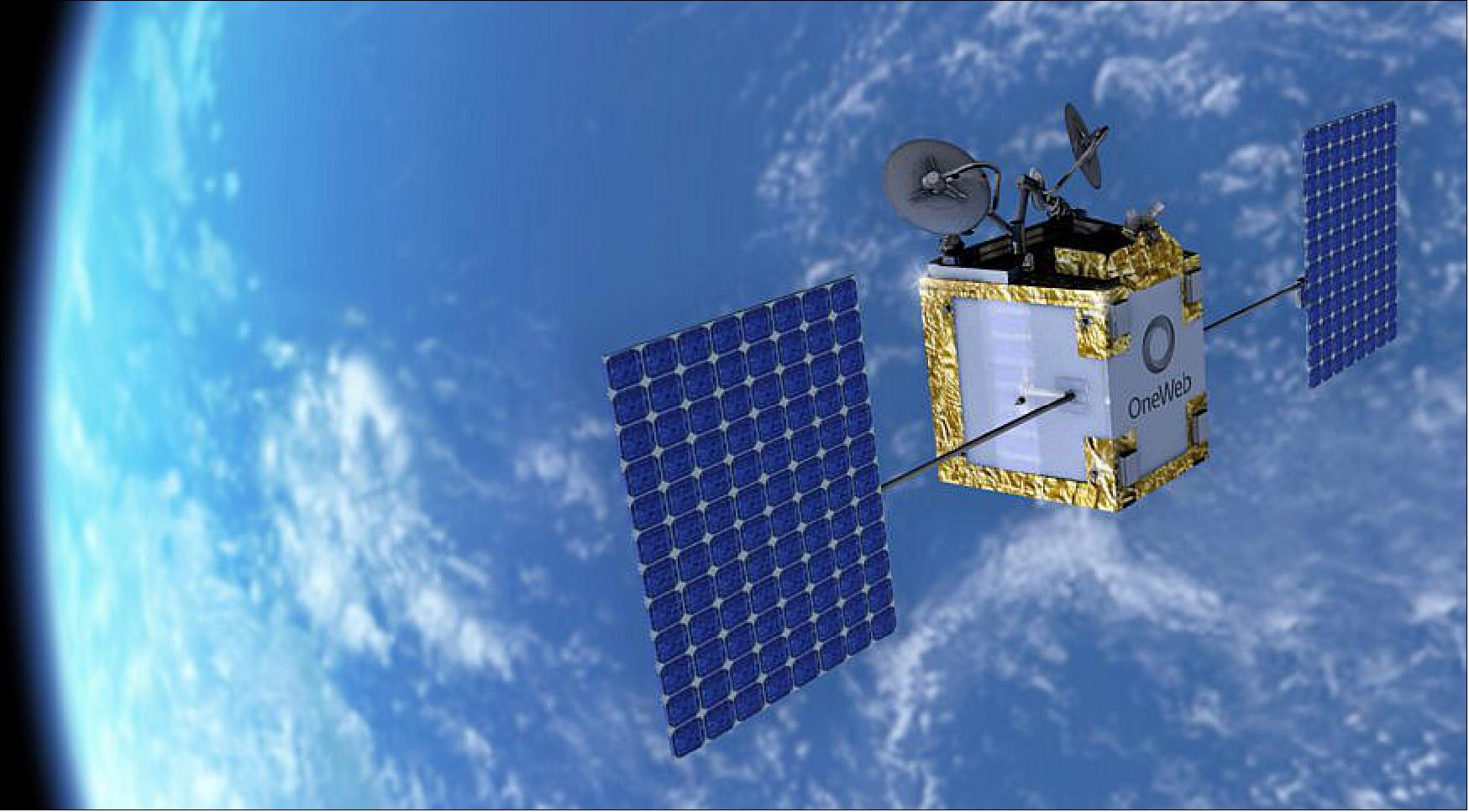
- The UK Space Agency awarded the group 32 million British pounds ($45 million) for the pilot mission, through ESA’s Sunrise program.
- OneWeb, partly owned by the British government, is teaming up with antenna maker SatixFy, ground station technology firm Celestia UK and satellite servicing startup Astroscale UK.
- SatixFy is getting the largest share of the funding at 25 million British pounds to build Joey-Sat’s beam-hopping payload and user terminal.
- According to SatixFy, the technology is the next step for HTS (High Throughput Satellites) that have been developing spot beam technology over the last decade.
- Joey-Sat’s design will enable it to remotely direct beams to increase capacity at higher usage areas in response to commercial demand spikes or emergencies such as natural disasters.
- In March, SatixFy agreed to build an in-flight connectivity terminal for OneWeb that will work with its LEO constellation, as well as geostationary (GEO) satellite systems operated by others.
- “From helping during a disaster to providing broadband on planes, this amazing technology will show how next-generation 5G connectivity can benefit all of us on Earth,” U.K. Science Minister Amanda Solloway said in a statement.
- “It is fantastic to see some of our finest space tech companies joining forces on this exciting project which will put the UK at the forefront of satellite communications technology.”
- SatixFy also entered a deal in March with Canadian satellite operator Telesat, giving it early access to modem chips that can support beam hopping for the Lightspeed LEO constellation it is developing.
- Celestia secured 4.4 million British pounds in Sunrise funding to trial ground station technology featuring a multibeam electronically steered antenna.
- Astroscale got 2.5 million British pounds to develop technologies that could safely deorbit unresponsive satellites like Joey-Sat.
- Its funding will support a servicing spacecraft it is developing called ELSA-m, which will demonstrate capabilities in 2024 for removing multiple retired satellites in a single mission.
- Astroscale’s ELSA-d servicer is currently in orbit, planning to conduct its first end-to-end test of technologies for debris removal this summer.
- “This ambitious project with OneWeb is the next step towards maturing our technologies and refining our UK capabilities to develop a full-service Active Debris Removal offering by 2024,” Astroscale UK managing director John Auburn said.
- Auburn added: “This multi-client strategy will drive down service costs and incentivise large satellite constellation partners to accelerate the speed at which they remove space junk.”
- Currently, Astroscale’s spacecraft can only latch onto satellites with compatible docking plates, and OneWeb is so far the only constellation that has added them to its spacecraft.
U.K. space boost
- The U.K. government sees debris cleanup and other emerging space markets as an important part of its strategy to capture 10% of the world’s space economy by 2030.
- In its latest update on reaching this target, included in its “Size and Health of the UK Space Industry” report published May 19, the government said its share sood at 5.1%.
- The report covers the 2018-2019 financial year, meaning the data it obtained from organizations could be for any 12-month period within those years.
- The U.K.’s share of the world’s space market was unchanged from its last update, covering the 2017-2018 financial year, as growth matched that of the global industry.
- Income increased 5.7% over the period to 16.4 billion British pounds, while the number of organizations with space-related activity increased from 948 to 1,218.
- Space-related employment grew from 41,900 to 45,100 over the period. The amount of industry research and development investments surged 18% to 702 million British pounds, which it said was five times the national average intensity.
- “The UK space industry is booming and this strong growth is a key part of our plans to level up and build back better from the pandemic, creating thousands of high value space jobs in regions right across the UK,” Solloway said in a statement that joined the report.
- “As we look to fulfil our bold ambitions for space, including the first satellite launches from UK soil next year, I look forward to seeing the sector growing further with more young people pursuing exciting careers in space, all while helping to cement the UK’s status as a global space superpower.”
- The report, based on surveys conducted by consultancy know.space, also looked at diversity for the first time and found just 36.5% of space industry employees in the U.K. identify as female.
• May 10, 2021: OneWeb, the U.K.-headquartered low Earth orbit (LEO) broadband operator, is buying Texas-based managed satcoms provider TrustComm to create a new government subsidiary. 51)

- The deal comes soon after the U.S. AFRL (Air Force Research Laboratory ) contracted OneWeb to demonstrate managed satcom services in Arctic locations.
- “OneWeb’s acquisition of TrustComm underpins our strategy to rapidly scale satellite communications service to the U.S. Department of Defense and other government agencies as they look to integrate high throughput, low latency solutions to meet new connectivity demands,” OneWeb head of government services Dylan Browne said in a statement.
- TrustComm CEO Bob Roe will lead a new subsidiary at OneWeb following the deal it expects to close this year, after regulatory approvals.
- OneWeb has only launched a third of its constellation of 650 satellites, but said it successfully demonstrated data rates of up to 500 Mbit/s to the DoD in March. It is advertising average network speeds of up to 195 Mbit/s.
- TrustComm signed an agreement March 16 to be OneWeb’s DoD distribution partner, focusing on early adopters including the U.S. Naval Research Laboratory (NRL) and U.S. Army Futures Research Lab.
- Established in 1999, TrustComm will be an important access point to the U.S government market for OneWeb, which expects the DoD will be its largest customer.
- The acquisition’s financial details were not disclosed.
- OneWeb’s 18-month contract with AFRL is worth about $3.4 million for testing services between certain U.S. Northern Command (NORTHCOM) sites.
- The increasingly strategic Arctic region suffers from poor connectivity because of its high latitude and extreme terrain.
- OneWeb aims to offer services in the Arctic region this fall after two more launches, each placing 36 satellites in polar orbits.
- SpaceX has also been launching Starlink LEO broadband satellites into polar orbits.
- However, Rick Lober, vice president and general manager of the defense and intelligence systems division at Hughes, told SpaceNews May 5 that only OneWeb will be able to deliver 24-hour high throughput services to strategic Arctic regions by the end of 2021.
- U.S.-based Hughes Network Systems, a OneWeb investor supplying parts of its ground segment, is prime contractor for the AFRL contract.
• May 5, 2021: The U.S. Air Force Research Laboratory (AFRL) has contracted low Earth orbit broadband venture OneWeb to demo managed satcom services in strategic Arctic locations. 52)
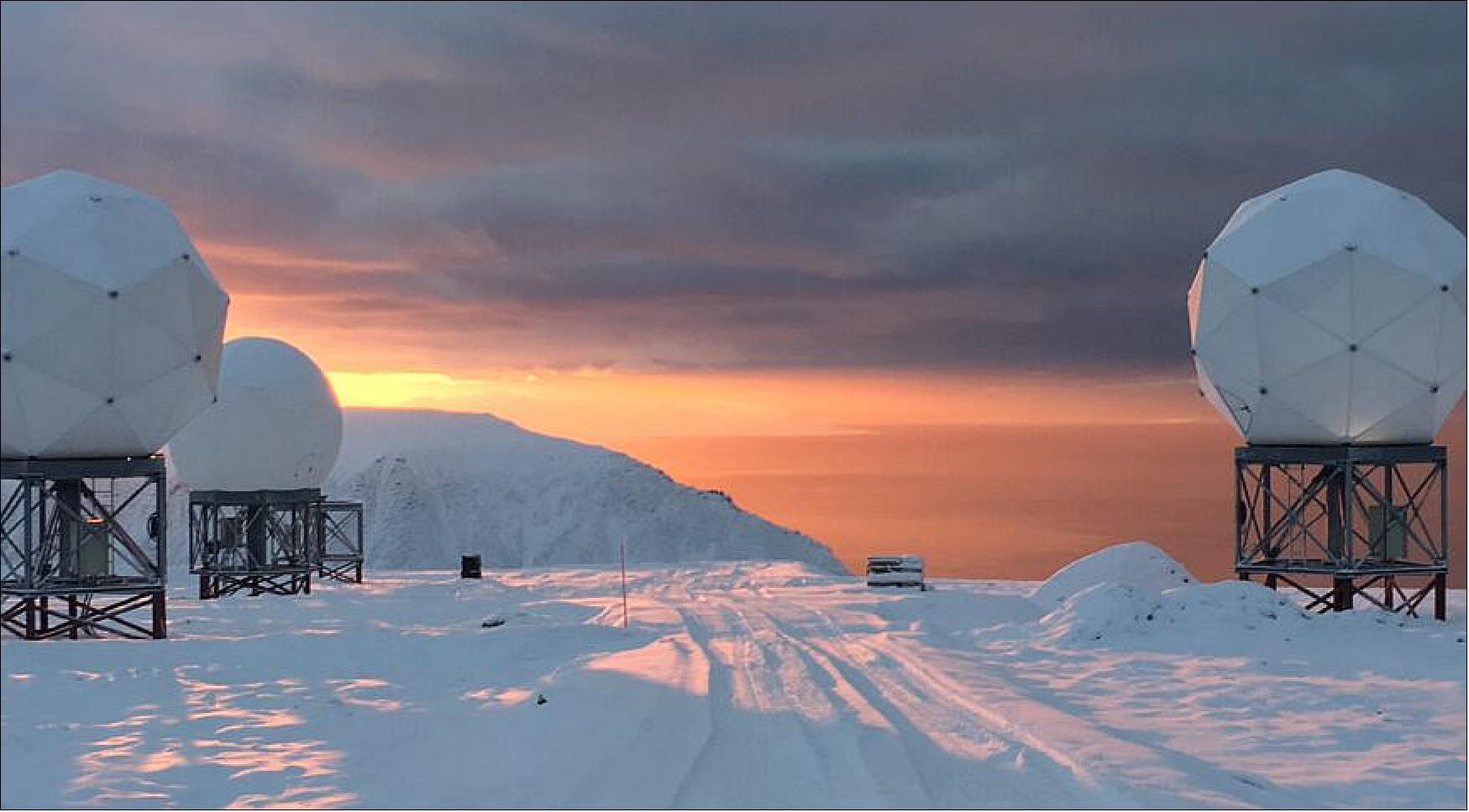
- Project prime contractor Hughes Network Systems, a OneWeb investor supplying parts of its ground segment, will test the services between certain U.S. Northern Command (NORTHCOM) sites.
- “The OneWeb constellation has been designed to enable low-latency broadband access across the globe, allowing connectivity in previously unreached areas—a capability that is ideal for tactical, multi-domain operations in the Polar region and beyond,” OneWeb head of government services Dylan Browne said in a statement.
- The Department of Defense contract is part of the U.S. Air Force’s Defense Experimentation Using the Commercial Space Internet (DEUCSI) program.
- OneWeb’s satellites are in polar orbits, and Browne told SpaceNews in March that this gives the company an advantage for Arctic regions of growing geopolitical interest.
- Currently, only Iridium Communications boasts pole-to-pole satcom coverage.
- However, SpaceX launched its first batch of Starlink LEO broadband satellites to polar orbit Jan. 24, supplementing the growing number of spacecraft it is sending to other orbits.
- In December 2018, SpaceX secured a three-year, $28 million contract under the DEUCSI program to test ways the military could use Starlink.
- Several other companies, including hardware providers Ball Aerospace, L3Harris, Raytheon and others, have also secured contracts under DEUCSI to explore how commercial broadband services could be integrated with military platforms.
- Nearly 1,500 Starlinks are currently in orbit, following SpaceX’s latest launch of 60 satellites May 4.
- SpaceX recently modified its license to operate 4,408 Starlinks at around 550 kilometers.
- OneWeb has 182 of a constellation of about 650 in orbit at around 1,200 kilometers, following its latest launch April 25.
- The company plans to start offering services in the Arctic region this fall after launching two more batches of 36 satellites.
- U.S.-based Hughes, which is producing the company’s gateway equipment and user terminal core modules, is managing the Arctic service demos for the U.S. Air Force. It is partnering with South Korea’s Intellian, the antenna maker designing OneWeb’s user terminals.
- “This opportunity reinforces the relationship between Hughes and the U.S. Air Force to ensure resilient, flexible SATCOM networks for tactical, multi-domain operations,” stated Rick Lober, vice president and general manager of the defense and intelligence systems division at Hughes.
- “We look forward to partnering with OneWeb to bring LEO innovation into the military SATCOM enterprise, especially in the strategic Arctic region where connectivity has been limited—until now.”
- Lober told SpaceNews in an email that it will start staging the LEO network in “the next few months” at Hughes and government locations in the U.S., before moving to the Arctic this fall.
- “This particular contract covers experimentation only,” he said.
- “As the system matures and other DoD users such as NORTHCOM develop specific requirements, a service contract is a possible option through various contract vehicles.”
- He added: “Our understanding is the Hughes-OneWeb team will deliver the only system with high throughput service to support the strategic Arctic region, 24 hours per day by the end of this year.”
- An AFRL spokesperson said the contract value is about $3.4 million.
- The British government and Indian telecom company Bharti Global bought OneWeb out of bankruptcy last year with a $1 billion investment. In January this year, OneWeb raised $350 million from Japanese internet giant SoftBank and $50 million from Hughes.
- After a $550 million investment April 27 from French satellite operator Eutelsat, OneWeb is expected to raise about $500 million this year to complete the constellation’s funding.
• April 27, 2021: French satellite operator Eutelsat is paying $550 million to buy part of OneWeb, the startup deploying a broadband network in low Earth orbit. 53)
- The company is buying a 24% stake to give it similar governance rights to the British government and Indian telecom company Bharti Global, which bought OneWeb out of bankruptcy last year.
- Part of the investment will be funded by the $507 million that Eutelsat is getting from clearing C-band spectrum in the U.S. for terrestrial 5G networks.
- The Paris-based company operates a fleet of geostationary (GEO) satellites, but has been dipping its toes into LEO with a constellation called Eutelsat ELO, targeting the market for connecting Internet of Things (IoT) devices.
- The first nanosatellite for this network, ELO Alpha, is slated to launch April 20 on a Vega rocket that is delayed following a launch failure in November.
- Buying a part of OneWeb’s LEO broadband constellation is a major strategy shift for Eutelsat, which is seeing its satellite TV business slowly decline as Netflix and other streaming services rise in popularity.
- “OneWeb will become our main growth engine outside our broadcast and broadband applications, as we continue to maximize cash-flow extraction from our highly profitable heritage business and grow our fixed broadband vertical leveraging our geostationary assets,” Eutelsat CEO Rodolphe Belmer said in a statement.
- Arianespace launched the latest batch of 36 OneWeb spacecraft April 25, growing the operator’s satellites to 182 ahead of partial services this year.
- OneWeb aims to launch two more batches of 36 satellites by June to expand coverage north of 50 degrees latitude, spanning the United Kingdom, Alaska, Northern Europe, Greenland, Iceland, the Arctic Seas and Canada.
- It expects to provide global services with 650 satellites in 2022 to enterprise, government, maritime and aviation customers.
- Following the investment from Eutelsat, which will give the French company a board seat, OneWeb’s LEO fleet could potentially find synergies with broadband satellites in GEO.
- Canadian GEO satellite operator Telesat, which plans to start launching its LEO broadband constellation Lightspeed next year, was previously the only megaconstellation player exploring this kind of opportunity.
- Sunil Bharti Mittal, OneWeb’s executive chair, said: “Together we are stronger, benefiting from the entrepreneurial energy of Bharti, extensive global outreach of UK and long-term expertise of the satellite industry at Eutelsat.”
$1.9 billion in fresh equity
- OneWeb emerged from Chapter 11 bankruptcy protection in November with a $1 billion investment from Bharti and the British government — each owning 42.2% at the time.
- The startup said Jan. 15 it raised $350 million from SoftBank, which was its largest shareholder before it filed for Chapter 11, and $50 million from Hughes Network Systems.
- Comments made earlier by Mittal suggest that, following Eutelsat’s investment, the company now needs to raise about $500 million to complete the constellation.
- Eutelsat said April 27 that OneWeb is “well advanced in terms of securing its remaining funding needs this year.”
- OneWeb expects to generate around $1 billion in annual revenues in three to five years after deploying its full constellation.
- Eutelsat said it is set to close its OneWeb deal in the second half of this year following regulatory approvals.
• April 8, 2021: The new chief executive of OneWeb says the company is still pursuing some kind of navigation capability for its broadband satellite constellation, although a full-fledged service may have to wait until a second-generation system. 54)

- Neil Masterson, a former executive with Thomson Reuters who was named chief executive of OneWeb when it emerged from bankruptcy in November 2020, said the company was planning to demonstrate a navigation service later this year, working with unnamed British organizations. The British government, along with Indian telecom company Bharti Global, acquired OneWeb out of Chapter 11 bankruptcy last year.
- “We expect to have a demo capability available later this year, and we’re working with certain bodies in the U.K. to advance our thinking there and help design that,” he said during a session of the Satellite 2021 LEO Digital Forum April 7. “We think that there’s something that can be done with the existing Gen 1 design. It’s a bit premature to talk about that right now, but we’re quite focused on that.”
- His comments echo those made by OneWeb’s executive chairman, Sunil Bharti Mittal, who said in December that the first-generation satellites could provide a timing service, but that a full-fledged PNT (Positioning, Navigating and Timing) system would have to wait until a second generation of satellites. “We have the ambition of providing PNT services through OneWeb,” he said. “We believe we will be onto this path in the coming years.
- Masterson also said that a full PNT system would have to wait until a second generation of the constellation. “To be a real alternative to GPS, we’ll have to wait until the second generation,” he said. “It is possible to provide some form of PNT services that are good enough, and certainly able to provide a form of redundancy. And that is where we will start from.”
- The British government’s decision to partner with Bharti on acquiring OneWeb has been linked in the minds of many in the industry in the government’s desire for its own satellite navigation system. After exiting the European Union, the British government can no longer access secure Galileo services sued by European militaries. The British government studied, but then abandoned, proposals to develop a standalone satellite navigation system.
- Using OneWeb for navigation services would face many challenges, including the fact that it does not use frequencies reserved for satellite navigation services like GPS and Galileo. There have been, however, studies about using low Earth orbit satellite constellations like SpaceX’s Starlink to provide alternative navigation services.
- Masterson offered no clues in his presentation about when OneWeb might pursue a second-generation system that could include a dedicated PNT service or other capabilities. The company’s focus is on deploying its initial constellation of 648 satellites to provide broadband services, which the company expects to complete next year. Service in polar regions north of 50 degrees latitude could begin later this year after three more Soyuz launches of 36 satellites each.
- “We’re starting to think about it already,” he said of a second-generation system. “I would like to hold off a little while before we make firm decisions on that because I really want to hear from our customers about what they want.”
- OneWeb, besides continuing to deploy those first-generation satellites, still needs to raise about $1 billion to complete the system. “We feel very confident about finding the remaining funding,” he said. He declined to offer a schedule for raising that funding.
• April 7, 2021: As part of its mission to deliver low latency, ‘fibre-like’ connectivity to the maritime and offshore industries, Low Earth Orbit (LEO) broadband satellite communications company OneWeb, has signed a Memorandum of Understanding (MoU) with The AST Group (AST), a global leader in satellite communications systems. 55)
- By working together, AST and OneWeb will offer fixed-land and maritime customers access to OneWeb’s fast, flexible and affordable connectivity solutions seamlessly in even the most remote locations on land and at sea. Customer beta trials will be undertaken with AST before the end of the year and will be focused on delivering fixed services to support remote connectivity in Northern Europe.
- Once full commercial service is available in 2022, OneWeb seeks to provide AST’s customers, primarily in the commercial shipping, fishing and high-end offshore sectors, with access to viable, high speed, low latency connectivity as an alternative to the current VSAT internet solutions to truly enable digitization and deliver the long-awaited leap in operational efficiencies.
- This comes at a time when regulatory and commercial influences are driving demand for companies in maritime and offshore industries to decarbonise, improve broader sustainability and governance standards as well as improving business performance – all of which are underpinned by the need for more technology and data.
- Commenting on the partnership, Gregory Darling, AST’s founder and Chairman said: “We’re delighted to strengthen our relationship with OneWeb by becoming its distribution partner so that we can offer customers a fibre-like alternative to current solutions. AST’s focus is solution-based to ensure that customers improve their overall operational efficiency. OneWeb’s new satellite constellation and next-generation connectivity aligned with AST’s INTEGRA network services will enable faster and better communications for the maritime industry. This new agreement marks further progress towards this transition.”
- Carole Plessy, Head of Maritime at OneWeb, said: “OneWeb believes that connectivity at sea should be as seamless and simple as it is onshore to improve the overall efficiency, sustainability and profitability of the maritime and offshore industries.
- We’re proud to work with The AST Group, not just because of the strength of its market insight, reach and capabilities, but because of our shared belief that remote, faultless connectivity is essential to delivering operational excellence. By partnering with AST, we are another step closer to making LEO connectivity available to more marine and offshore customers, ending the legacy of complex, slow and costly VSAT systems.”
• March 28, 2021: OneWeb plans to start offering broadband from space in the Arctic region this fall, a capability the company hopes will attract U.S. government and other national government customers. 56)
- “Our focus now is Alaska and the Arctic,” OneWeb’s head of government services Dylan Browne told SpaceNews.

- Since OneWeb came back from bankruptcy in November “we’ve been busy setting up engagements with the U.S. government,” Browne said. The company is now owned by the British government and Indian telecom company Bharti Global.
- OneWeb is racing to provide coverage in the Arctic where currently only Iridium offers satellite-based communications services. Following the latest launch of 36 satellites on March 25, OneWeb has 146 in operation. Browne said the company needs to deploy three more batches of 36 satellites to cover areas north of 50 degrees latitude, which would include Alaska and much of the Arctic region. The company is planning a constellation of about 650 satellites for global coverage.
- OneWeb satellites orbit around the poles. “Every time we put a satellite up we get a concentration above the poles which is really serendipitous because from a government and DoD perspective, that’s an area of geopolitical interest,” Browne said.
- “LEO scratches an itch for some of the new and emerging challenges the Department of Defense has,” he added.
- The Arctic has become an area of strategic interest where melting ice caps have set off a race for resources, and Russia and China are trying to grow their influence. The ability to provide coverage in the Arctic gives OneWeb an advantage over competitors, said Browne. “It sounds a bit cliche but timing is everything.”
- The demand for satellite-based communications in the Arctic is coming from both the commercial and government sides, Browne said. Industries like oil and gas are target customers, but the immediate requests are coming from governments, he said. “We literally just got a request from the office of the prime minister of Finland,” he added. “We have a strong engagement with Norway. This week we did a briefing for Icelandic regulators. They need high speed, low latency satellite connectivity for their maritime patrols.”
- OneWeb on Friday announced an agreement with satellite communications integrator and reseller TrustComm Inc. to distribute services to U.S. military users in northern latitudes.
- TrustComm has an operations center at Ellington Field Joint Reserve Base in Houston, Texas, and holds a number of DoD contract vehicles to provide managed satellite services. Browne said the U.S. Navy is one TrustComm’s major customers and will be using OneWeb’s services to provide connectivity to ships at sea.
- The coverage in the Arctic initially will be only for fixed sites. Starting in 2022 mobile services will be available, said Browne. That’s important for Navy and Coast Guard units that will be patrolling the waters.
- To increase its footprint in the U.S. military, OneWeb is hoping to get a contract from the Air Force Research Laboratory to participate in a program known as DEUCSI (Defense Experimentation Using the Commercial Space Internet). AFRL already has signed up several companies to help figure out how commercial broadband services would be integrated with military platforms.
- OneWeb also plans to compete for DoD contracts managed by the U.S. Space Force’s Commercial Satellite Communications Office. A solicitation for LEO satellite services is expected to be released this summer.
- The company also wants to work with DoD’s SDA (Space Development Agency) even though OneWeb’s network does not have inter-satellite links, which SDA requires so data can be moved around the world without having to send it back to ground stations. Browne said OneWeb’s current generation of spacecraft was not designed to have inter-satellites links but the company plans to incorporate that technology in the future.
• March 19, 2021: Flight passengers will soon be able to connect to their families and colleagues on Earth via low-orbit telecommunications satellites. 57)
- Speeds will be comparable to those at home, substantially boosting the service currently provided by geostationary satellites.
- On 19 March, communications company OneWeb signed an agreement to deliver Wi-Fi on aircraft with SatixFy, a British manufacturer of electronic components.
- They will develop in-flight connectivity terminals that will work over OneWeb’s constellation of low-Earth orbit satellites, as well as on geostationary satellite networks.
- OneWeb currently has 110 satellites in orbit but foresees a constellation of about 650.
- The terminals will use electronically steered multi-beam antenna technologies to provide multi-beam capability and operate simultaneously via many different satellites.
- The terminals use SatixFy’s state-of-the-art application-specific integrated circuit chip set, developed with the support of the UK Space Agency through ESA’s ARTES (Advanced Research in Telecommunications Systems) program.
- SatixFy has formed a joint venture called JetTalk with Singapore Technology Engineering Ltd to commercialize the terminal for commercial aviation markets.
- Elodie Viau, Director of Telecommunications and Integrated Applications at ESA, says: “Space and satellites are becoming increasingly important to the digital economy and there is a need to get data all the time and everywhere – even on board a plane.
- “ESA is proud to have supported SatixFy in the design of the chips used for this terminal – enabling the digital transformation of society using telecommunications satellites.”
- Catherine Mealing-Jones, Director of Growth at the UK Space Agency, says: “The past year has shown that connectivity has never been more important to our daily lives, and it is exciting to see SatixFy and OneWeb working together to provide commercial passenger planes with broadband internet for the first time.
- “The new aero terminal will make use of chips developed with UK Space Agency backing, which demonstrates how supporting our most innovative companies leads to results that make a real difference for people all over the world.”
- Yoel Gat, chief executive of SatixFy, says: “The ability to deploy multi-beam, multi-satellite, multi-orbit in-flight connectivity terminals is key in SatixFy’s offerings. Aggregating capacity from multiple satellites will give customers the grade of service they expect to get on flights. This great leap forward is made possible thanks to the continuous support by ESA and the UK Space Agency.”
• March 8, 2021: Intellian Technologies Inc. with HQs in Korea announced that it has won a US$73 million contract with low earth orbit (LEO) satellite network provider OneWeb to develop and supply affordable compact user terminals. These innovative, easily-installed antennas will use next-generation technology to provide high bandwidth, low latency connectivity to OneWeb’s global satellite service, delivering to multiple markets including enterprise and government services. 58)
- “We’re delighted to collaborate with our trusted partner OneWeb to design and produce this game-changing terminal, which is set to transform satellite communications by delivering cost-effective connectivity and enhanced user experience to multiple markets,” said Eric Sung, CEO, Intellian Technologies. “This is another significant milestone for Intellian: we believe that innovation and ease of use are key to empowering connectivity, and the work jointly announced today by Intellian and OneWeb is fundamental to our goal to enable a globally connected world.”
- OneWeb is launching a constellation of 648 LEO satellites, which when complete will deliver affordable, fast, high bandwidth and low latency Ku-band connectivity to every corner of the world.
- Michele Franci, Chief of System Delivery at OneWeb, said: “We have a clear ambition to be a leader in the transformation of Space communications technology. We are delighted to continue our work with Intellian to develop a range of User Terminals that meet the needs of our customers in many different sectors including: small, medium and large enterprises; and major vertical sectors such as Enterprise, Maritime and Governments with mission critical applications.”
- The new low cost compact terminals will be unveiled later in the year and are scheduled to become available in 2022.
• March 18, 2021: The next Arianespace mission is planned from Vostochny Cosmodrome with Soyuz on March 25, to deliver 36 satellites into orbit. 59)
- By operating this fifth flight on behalf of OneWeb, Arianespace will bring the total fleet to 146 satellites in Low Earth Orbit. Arianespace is proud to share in the fulfilment of its customer’s ultimate ambition: providing internet access for everyone, everywhere.
- Flight ST30, the second commercial mission performed by Arianespace and its Starsem affiliate from the Vostochny Cosmodrome, will put 36 of OneWeb’s satellites into a near-polar orbit at an altitude of 450 kilometers. The mission will have a total duration of three hours and 51 minutes and will include nine separations of four satellites, that will raise themselves to their operational orbit. This launch will bring up to speed Arianespace’s operations this year to the benefit of OneWeb, and will raise to 146 the number of satellites deployed for the global telecommunications operator.
- OneWeb’s mission is to bring internet everywhere to everyone, by creating a global connectivity platform through a next generation satellite constellation in low Earth orbit. OneWeb’s constellation will deliver high-speed, low-latency connectivity services to a wide range of customer sectors including aviation, maritime, backhaul services, as well as governments, emergency response services and more. Central to its purpose, OneWeb seeks to bring connectivity to every place where fiber cannot reach, and thereby bridge the digital divide.
- Once deployed, the OneWeb constellation will enable user terminals that are capable of offering 3G, LTE (Long Term Evolution), 5G and Wi-Fi (Wireless Fidelity) coverage, providing high-speed access globally – by air, sea and land.
- OneWeb Satellites, a joint venture between OneWeb and Airbus Defence and Space, is the constellation’s prime contractor. The satellites were built thanks to its leading-edge satellite manufacturing process that can build up to two satellites a day on a series production line dedicated to the assembly, integration, and testing of the satellites.
- A total of 110 OneWeb satellites have already been orbited by Arianespace: the first six were successfully orbited by Arianespace from French Guiana on February 27, 2019. On February and March 2020, Arianespace and its Starsem affiliate successfully launched 68 OneWeb satellites from Baikonur Cosmodrome on two successful Soyuz flights. On December 2020, the team successfully delivered an additional 36 satellites into orbit, with first commercial flight operated from new Vostochny Cosmodrome.
• January 15, 2021: Broadband satellite company OneWeb announced Jan. 15 it has raised $400 million from SoftBank and Hughes Network Systems, allowing the company to continue deployment of its constellation. 60)
- The new round includes $350 million from SoftBank, who was the biggest shareholder in OneWeb before it filed for Chapter 11 bankruptcy in March 2020. The remainder is from Hughes Network Systems, which announced last year it would invest $50 million into the restructured company.
- The companies did not disclose the new size of SoftBank’s stake in the company, but OneWeb announced that the Japanese company would get a seat on its board. According to an October notice by the Federal Communications Commission, SoftBank owned 12.3% of the company at the time, after owning 37.41% before the Chapter 11 filing.
- The same FCC notice said that Hughes’ planned investment was still being finalized, but that the investment would not have a “meaningful impact” on OneWeb’s ownership, with Hughes holding a 2.6% stake. The British government and Indian telecom company Bharti Global, which acquired OneWeb for $1 billion, each owned 42.2% of the company at that time.
- The funding will help support the company as it continues deployment of an initial constellation of 648 satellites. “We have made rapid progress to restart the business since emerging from Chapter 11 in November,” said Neil Masterson, chief executive of OneWeb, in a statement. “We welcome the investments by SoftBank and Hughes as further proof of progress towards delivering our goal.”
- OneWeb said the funding “positions the company to be fully funded for its first-generation satellite fleet,” but the $400 million alone is insufficient to fund the company through full deployment of the constellation, expected to be completed in mid-2022. Sunil Bharti Mittal, founder and chairman of Bharti Enterprises and executive chairman of OneWeb, said last month he expected OneWeb would need $2.5 billion to complete the constellation, of which about half had been raised. That suggests the company still needs to raise about $1 billion.
- Bharti Mittal, though, was optimistic about getting that additional funding. “I don’t see raising capital for this wonderful project for the balance amount to be any issue,” he said, noting that Bharti Enterprises had raised more than $12 billion in the last 18–24 months for other projects.
- OneWeb said last month that they expected to perform launches on a roughly monthly schedule to complete the constellation, with enough satellites in orbit by the fall of 2021 to enable service to begin at latitudes above 50 degrees north. Global service would begin in 2022, once the full constellation is in orbit.
- OneWeb resumed launches of that constellation, halted by the Chapter 11 filing, Dec. 18, with the deployment of 36 satellites on a Soyuz rocket. The company has not announced a date for its next launch.
- In addition to that initial constellation, the company is working on a larger “Phase Two” constellation. In a Jan. 12 filing with the FCC, OneWeb sought to modify its original application by reducing the number of satellites in that Phase Two system from 47,844 to 6,372.
• December 16, 2020: Hughes Network Systems, LLC has been chosen by OneWeb, the LEO (Low Earth Orbit) broadband satellite communications company, to develop and manufacture essential ground system technology for the new LEO constellation. In a three-year contract valued at approximately $250 million, Hughes will produce the gateway electronics for the OneWeb system as well as the core module that will be used in every user terminal. 61)
- “Today’s announcement of a continued technology partnership with OneWeb reflects our position as the trusted innovator in the industry,” said Pradman Kaul, president, Hughes. “The ground system we develop will enable reliable, low latency broadband data, ideal for a wide range of customer applications.”
- Neil Masterson, CEO, OneWeb, said: “OneWeb is building a global broadband network to deliver high-throughput, low latency enterprise grade connectivity services for a wide range of government, commercial, and mobility use cases. Our goal is to commercialize services in a year, and our partnership with Hughes will be vital in helping us launch a secure, trusted, resilient, space-based network.”
- Designed by Hughes engineers, each OneWeb gateway is capable of 10,000 hand-offs per second, orchestrating handover and tracking of hundreds of gigabits of data across hundreds of beams and millions of users. Under an agreement with OneWeb prior to a restructuring in March, seven gateways had been installed with several more in various stages of production. Under the new agreement, Hughes has ramped up production on the gateway equipment and resumed testing on the installed systems.
- The agreement announced today also calls for Hughes to develop and manufacture the core module for the OneWeb user terminals. Designed by Hughes, the core module is uniquely adaptable across fixed as well as aeronautical and maritime mobility terminals, for either electronically or mechanically steered antennas.
- After filing for bankruptcy protection in March, OneWeb is now under ownership by a new consortium led by the U.K. Government and Bharti Enterprises and in which Hughes has agreed in principle to invest $50 million.
• December 1, 2020: Florida-based OneWeb Satellites has returned to full-scale production of spacecraft after its big client and part owner, OneWeb, emerged from bankruptcy. 62)
- The high-tech factory near Kennedy Space Center churns out eight satellites a week, which is the average pace it was on before the bankruptcy, CEO Tony Gingiss said in an interview Friday.
- "We are stronger and leaner as an organization now," Gingiss said. "We hit pause, like many others had to in 2020, due to the pandemic and the OneWeb bankruptcy, but it made us think a lot about our value proposition."
- The company is leaner because it is operating with just less than 300 people, whereas the plant had almost 400 at its peak in early 2020, he said. OneWeb Satellites plans to hire only about 15 to 20 more to maintain full production.
- OneWeb Satellites' facility began operations in March 2019, to build satellites for OneWeb's planned constellation of up to 650 broadband communications satellites. The company made over 70 satellites in 12 months, before the bankruptcy threw the operation into doubt.
- The pandemic was the reason for closing the factory for over a week, Gingiss said, and not the bankruptcy.
- "We hit pause because people wanted to take breaks for their health or their family's health, and to thoroughly clean the factory," Gingiss said. "But we did reopen and produced about one satellite per week at the low point."
- The manufacturer, which is half-owned by the OneWeb parent company, delivered 36 satellites recently for a planned launch in Russia on Dec. 17. OneWeb has 74 satellites in orbit.
• November 20, 2020: Acquisition of global satellite communications company, OneWeb, completes today, following successful government bid in July 2020. 63)
- This is a significant strategic investment, demonstrating the government’s commitment to the UK’s space sector and ambition to put Britain at the forefront of a new commercial space-age. OneWeb is now staffing up to complete the development of its first generation constellation, adding new employees in the UK, and we will continue to work with OneWeb to maximise the benefits to the UK from the OneWeb program, both before and after commercial launch.
- The company has the foundation of the network already in place with 74 satellites launched and infrastructure in development in strategic locations around the world. The company is launching another 34-36 satellites in December, bringing its in-orbit fleet to 110 satellites. OneWeb is on track to begin commercial connectivity services to the UK and the Arctic region in late 2021 and will expand to delivering global services in 2022.
Business Secretary Alok Sharma said:
a) ”This strategic investment demonstrates government’s commitment to the UK’s space sector in the long-term and our ambition to put Britain at the cutting edge of the latest advances in space technology.
b) ”Access to our own global fleet of satellites has the potential to connect people worldwide, providing fast UK-backed broadband from the Shetlands to the Sahara and from Pole to Pole.
c) ”This deal gives us the chance to build on our strong advanced manufacturing and services base in the UK, creating jobs and technical expertise.”
- The government is committed to work with OneWeb’s shareholder partners to use this investment as a platform to promote UK jobs and supply chains and protect UK critical assets and intellectual property.
- OneWeb will provide a new source of broadband connectivity for businesses, communities, and governments around the world. It could also improve connectivity in a broad range of sectors, including aviation, maritime, government, and enterprise customers, unlocking digital services and applications in a wide range of locations that historically have not access to low latency broadband connectivity.
Sunil Bharti, Founder and Chairman, Bharti Global said:
a) ”Together with our partners at HMG, we are looking forward to a new Low Earth Orbit opportunity. Innovation, resilience and growth in the high-tech sector are all served by this powerful global opportunity.
b) By the end of 2022, OneWeb will be a truly global force for good.”
Graham Turnock, Chief Executive of the UK Space Agency, said:
a) ”This landmark government investment marks the start of an incredibly exciting period for OneWeb and the whole UK space sector, which can play a vital role in our economic recovery.
b) Global connectivity has never been more important and there is a significant opportunity for satellite constellations to deliver a range of valuable services to consumers, businesses and government.”
- OneWeb was formed in 2012, and has been developing cutting-edge satellite technology from its facilities both here in the UK and in the United States.
- The UK government will have a final say over any future sale of the company, and over future access to OneWeb technology by other countries on national security grounds.
• On October 2, 2020, the US federal bankruptcy court approved the sale of broadband megaconstellation company OneWeb to the British government and Indian telecommunications company Bharti Global. 64)

- At a confirmation hearing in the United States Bankruptcy Court for the Southern District of New York, judge Robert D. Drain approved the reorganization plan for OneWeb, which filed for Chapter 11 bankruptcy there in March. That plan will allow OneWeb to resume full business operations, including resuming deployment of a constellation of 650 satellites in low Earth orbit to provide broadband internet access.
- The British government and Bharti Global offered $1 billion to acquire OneWeb in a bid accepted by the court in July. Since then, they have been working to finalize the agreement, including working out agreements with various creditors.
- The court’s approval of the plan does not complete the sale of OneWeb. The company said in a statement that the sale will close once it receives “customary regulatory approvals” that it expects to be in place by the end of the year. “In the meantime, OneWeb is resuming operations and readying its commercial services which are planned to start next year,” it stated.
- OneWeb announced Sept. 21 it had a revised contract in place with Arianespace to permit launches of its satellites on Soyuz rockets to resume in December. Two days later, the court approved $235 million in additional debtor-in-possession financing to allow company operations to continue through the end of the year, including production of new satellites at the OneWeb Satellites factory in Florida.
- “As we await the final mechanical components of the transaction, we set our eyes back to the skies with the resumption of launches later this year and commencing commercial services within a year,” Adrian Steckel, chief executive of OneWeb, said in a statement.
• September 21, 2020: Arianespace and OneWeb will resume launch operations to continue the deployment of the OneWeb constellation. 65)
- The next Soyuz launch is planned as soon as December 2020 from the Vostochny Cosmodrome.
- Pursuant to an amended launch contract with OneWeb, the London-based communications company, Arianespace will perform 16 more Soyuz launches from three spaceports (Kourou, Baikonur and Vostochny) beginning in late 2020 and continuing through 2022. These launches will enable OneWeb to complete the deployment of its full global constellation of Low Earth Orbit satellites by the end of 2022.
- “I am delighted that we are back on track to support the deployment of the OneWeb constellation and the company’s mission to bridge the digital divide at a global scale,” said Stéphane Israël, CEO of Arianespace. “Our teams already are working hard to ensure a smooth and quick restart of the launch campaigns by year-end 2020.”
- The next Soyuz flight is scheduled for December 2020 from Vostochny with 36 satellites on board.
- Arianespace has launched 74 OneWeb satellites to date. The initial six were successfully orbited by Soyuz Flight VS21 from French Guiana on February, 2019. In February and March, 2020, Arianespace and its Starsem affiliate successfully launched 68 OneWeb satellites from Baikonur on Soyuz Flights ST27 and ST28.
- OneWeb’s goal is to deliver global connectivity from a network of 650 low Earth orbit (LEO) satellites that will provide high-bandwidth, low latency communication services to regions previously unconnected.
- In addition to the satellites, OneWeb’s global network will include gateway stations located around the world, and a range of user terminals will provide connectivity services for fixed and mobile communications. These terminals will be compatible with the future needs of the Internet of Things (IoT) and 5G.
- OneWeb Satellites – a joint venture between OneWeb and Airbus Defence and Space – is the constellation’s prime contractor. The OneWeb satellites are built in OneWeb Satellites’ Florida-based series production line that is dedicated to the assembly, integration, and test of OneWeb’s satellites.
• September 21, 2020: OneWeb planned to launch up to 672 satellites into low Earth orbit with the vision to provide broadband internet access to the entire world's surface. 66)
- The United Kingdom's communications company OneWeb, which had been bought out of bankruptcy by the British government and an Indian telecom provider, confirmed on Friday (18 September) resuming satellite production.
- "Yes - satellite production is underway!" the company replied to a Twitter user.
- In 2015, the company penned a contract with Roscosmos through European aerospace company Arianespace to carry out 21 launches to deliver all the satellites into space. In late March, OneWeb filed for Chapter 11 bankruptcy in a New York state court after launching just 74 satellites.
- The UK government and Indian mobile network operator Bharti Global have since agreed to pay $1 billion to acquire OneWeb and fund the restart of its projects.
• August 20, 2020: OneWeb, currently proceeding slowly through its Chapter 11 bankruptcy reorganization, is asking the US government to relax its rules on importing satellite components and materials under its Foreign Trade Zone regulations. 67)
- The Foreign Trade Zone (FTZ) rules permit businesses to lower import duties and easier customs processes.
- OneWeb has made its application via its joint-venture (OneWeb Satellites North America LLC) with Airbus, which is based in Merritt Island, Brevard County, Florida, and turns out OneWeb’s satellites.
- The US Dept. of Commerce announced the application on the government’s Federal Register on August 19th.
- “Airbus OneWeb already has authority to produce satellites for commercial, private, and military applications within FTZ 136. The current request would add foreign status materials/ components to the scope of authority. Production under FTZ procedures could exempt Airbus OneWeb from customs duty payments on the foreign- status materials/components used in export production. On its domestic sales, for the foreign-status materials/ components, Airbus OneWeb would be able to choose the duty rates during customs entry procedures that apply to its already authorized finished products (duty- free). Airbus OneWeb would be able to avoid duty on foreign-status components which become scrap/waste. Customs duties also could possibly be deferred or reduced on foreign-status production equipment,” explained the Department of Commerce.
• July 28, 2020: Hughes Network Systems, an original OneWeb investor, said July 27 it would put $50 million into the consortium that is purchasing OneWeb out of bankruptcy protection. 68)
- We are pleased to be part of this winning team, along with the British Government and Bharti Enterprises,” Pradman Kaul, Hughes president, said in a news release. “Our continuing and strengthened involvement with OneWeb extends naturally from our position as a leading geostationary satellite operator and ground network innovator.”
- Germantown, Maryland-based Hughes invested $50 million in OneWeb back in 2015, alongside Airbus Group, Bharti Enterprises, Coca-Cola, Intelsat, Qualcomm, Totalplay and the Virgin Group as part of OneWeb’s $500 million Series A round.
- OneWeb raised $3.4 billion and launched 74 out of 648 small broadband satellites before filing for chapter 11 bankruptcy protection in March. The British government and Bharti placed the winning bid to acquire OneWeb in July, with each agreeing to invest $500 million to revive the megaconstellation startup.
- Hughes said it still plans to be a distribution partner for OneWeb capacity, having announced earlier this year it would offer OneWeb connectivity to customers with networks for government and business sites, cellular backhaul needs and community Wi-Fi hotspots.
- Hughes has won more than $300 million in OneWeb business for gateway antennas and other ground infrastructure that remains unfinished. Hughes had $5.4 million in unsecured claims at the time of OneWeb’s bankruptcy filing.
• July 20, 2020, OneWeb’s bankruptcy court permitted the British and Indian joint-venture, (called ‘BidCo 100’) to pay $50.7 million into OneWeb in order to start re-building its initial constellation of some 648 satellites. OneWeb is authorized by the FCC to launch 720 craft out of a potential 1,980 mega-constellation. OneWeb also has an application with the FCC to dramatically expand the number of satellites up to 48,000. 69)
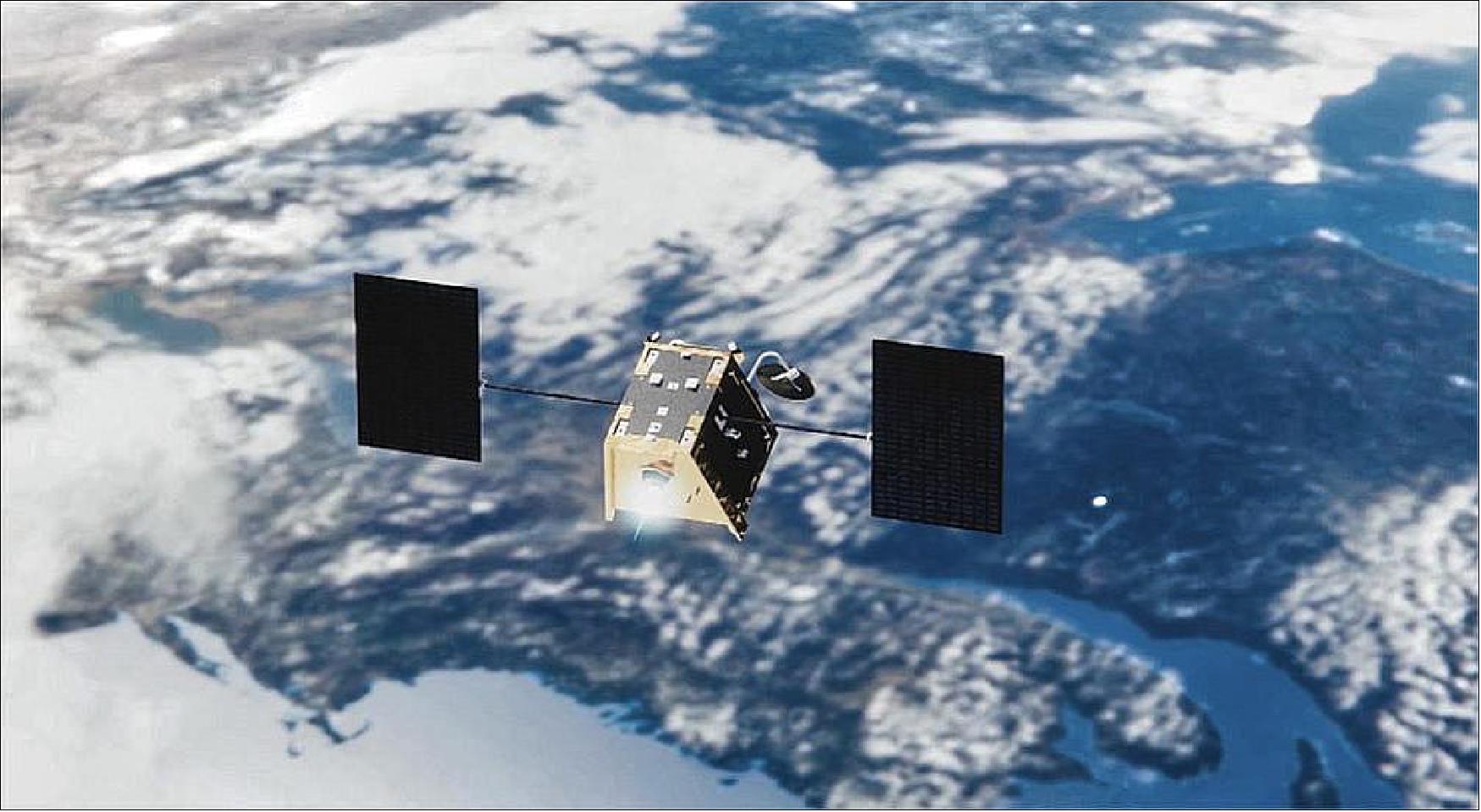
- OneWeb’s bankruptcy court permitted the British and Indian joint-venture, (called ‘BidCo 100’) to pay $50.7 million into OneWeb in order to start re-building its initial constellation of some 648 satellites. OneWeb is authorized by the FCC to launch 720 craft out of a potential 1,980 mega-constellation. OneWeb also has an application with the FCC to dramatically expand the number of satellites up to 48,000.
- OneWeb is under an ITU (International Telecommunication Union) timetable to get its satellites into orbit, not the least of which is because the ITU requires a large proportion of the fleet to be in orbit. OneWeb told the FCC that it would be providing service to Alaska by 2019 and rapidly rolling out its service to the rest of the US.
- OneWeb is obliged by the ITU to launch 360 satellites by June 2023 and 720 by June 2026. Failure to keep to this timetable will risk the core OneWeb spectrum licenses. The FCC has endorsed this timetable.
- Currently, OneWeb has just 74 satellites on-orbit and the agreement with the incoming new owners UK/Bharti will honor most of the existing supply and launch contracts. Arianespace, for example, was under contract to launch 21 of its Soyuz rockets plus 3 launches of the new Ariane-6 rocket (itself delayed until later in 2021). Each Soyuz would carry 34 satellites.
- However, Arianespace also wants more cash. The old contract called for a total of $273.8 million for the launches. Arianespace now says that the original sum, of course, does not include interest owed on the old contract and is now seeking $286 million.
- Add to these complications the inevitable bankruptcy process and it is highly unlikely that the current fleet of satellites under production will be further delayed in order for global positioning modifications to take place.
- Prior to the bankruptcy, OneWeb was producing satellites at around two per day. At 34 satellites per launch – and an obliged 300 craft still to be launched to meet the ITU rules – ten launches will see the task completed; however, the demands are considerable. Waiting for the bankruptcy to be fully concluded, and making positioning modifications, makes this timetable much tighter.
- Last week, Airbus confirmed that it was committed to its joint-venture with OneWeb in Florida and would continue operating the joint venture’s Florida factory to turn out OneWeb’s satellites. The joint venture would also continue to seek other – non-OneWeb – satellite orders.
- There are also reports that the UK is not insisting on early adoption of its satellite positioning plans. The UK’s science, research and innovation minister Amanda Solloway said that she believes ‘new’ OneWeb would be profitable. “This investment is likely to make an economic return, with due diligence showing a strong commercial basis for investment. The deal contributes to the government’s plan to join the first rank of space nations, and signals the government’s ambition for the UK to be a pioneer in the research, development, manufacturing, and exploitation of novel satellite technologies enabling enhanced broadband through the ownership of a fleet of Low Earth Orbit satellites.”
• July 3, 2020: Government leads a successful bid to acquire OneWeb which develops cutting-edge satellite technology in the UK and in the US. 70)
a) Government-led consortium’s ownership of OneWeb strengthens UK’s place on the world stage
b) government will provide $500 million to deliver first UK sovereign space capability, alongside $500 million from Bharti Global (see Note [1])
c) successful bid puts UK at the cutting-edge of the latest advances in space technology.
- The government has today (3 July) led a successful bid to acquire OneWeb, which develops cutting-edge satellite technology in the UK and in the US.
- The move signals the government’s ambition for the UK to be a pioneer in the research, development, manufacturing, and exploitation of novel satellite technologies through the ownership of a fleet of Low Earth orbit satellites.
- Business Secretary Alok Sharma confirmed that the government will invest $500 million and take a significant equity share in OneWeb. This is alongside Bharti Global Ltd, which is part of a group that controls the third largest mobile operator in the world. Bharti will provide the company commercial and operational leadership, and bring OneWeb a revenue base to contribute towards its future success.
- The deal will enable the company to complete construction of a global satellite constellation that will provide enhanced broadband and other services to countries around the world.
- The deal also offers the UK strategic opportunities across a wide range of other applications, working with our international allies.
- With a sovereign global satellite system, the UK will further develop its advanced manufacturing base, making the most of its highly skilled workforce as the hardware is further developed and equipment and services are deployed to make the most of this unique capability.
- OneWeb will also contribute to the government’s plan to join the first rank of space nations, along with our commitment to making the UK a world leader in science, research and development.
- The deal is subject to US court approval and regulatory clearances and is expected to close before the end of the year.
- It follows the formation of the UK’s first-ever National Space Council, chaired by the Chancellor of the Exchequer, to consider how space policy can enhance the country’s prosperity and place in the world, as well as our wider national security interests.
Note [1]: Bharti, through Bharti Airtel, is the third largest mobile operator in the world, with over 425 million customers. Bharti Airtel has its own extensive mobile broadband networks and enterprise business, which will act as the testing ground for all OneWeb products, services, and applications. Bharti Airtel also operates India’s leading satellite broadcasting service through Airtel Digital TV to over 16 million households. 71)
• March 27, 2020: OneWeb (the Company), the global communications company with a mission to bring connectivity to everyone everywhere, announced today that the Company and certain of its controlled affiliates have voluntarily filed for relief under Chapter 11 of the Bankruptcy Code in the U.S. Bankruptcy Court for the Southern District of New York. The Company intends to use these proceedings to pursue a sale of its business in order to maximize the value of the company. 72)
- To date, the Company has successfully launched 74 satellites as part of its constellation, secured valuable global spectrum, begun development on a range of user terminals for a variety of customer markets, has half of its 44 ground stations completed or in development, and performed successful demonstrations of its system with broadband speeds in excess of 400 Mbit/s and latency of 32 ms. In addition, OneWeb’s commercial team has seen significant early global demand for OneWeb’s high-speed, low-latency connectivity services from governments and leaders in the automotive, maritime, enterprise, and aviation industries.
- This demand for connectivity delivered from low Earth orbiting satellite constellations underscores the tremendous need for high-quality connectivity, especially for rural and under-connected communities worldwide. The OneWeb ecosystem has transformed the satellite industry introducing innovative new technologies and operational advances. These developments have fundamentally changed the economics of satellite communications, opening up new markets such as cellular backhaul and connectivity on the move.
- Since the beginning of the year, OneWeb had been engaged in advanced negotiations regarding investment that would fully fund the Company through its deployment and commercial launch. While the Company was close to obtaining financing, the process did not progress because of the financial impact and market turbulence related to the spread of COVID-19 (Coronavirus Disease-19).
- Today, the Company has filed a number of customary motions with the U.S. Bankruptcy Court seeking authorization to support its ongoing operations during the Chapter 11 process, including approval for the consensual use of its existing cash collateral to continue to fund the business. In addition, OneWeb is actively negotiating debtor-in-possession financing, which, if acquired and approved by the Bankruptcy Court, will ensure OneWeb is able to fund additional financial commitments as it conducts a sale process under Section 363 of the U.S. Bankruptcy Code. Together, these actions will allow OneWeb to meet post-petition obligations to its remaining employees and certain vendors in the ordinary course.
- Adrian Steckel, Chief Executive Officer of OneWeb, stated, “OneWeb has been building a truly global communications network to provide high-speed low latency broadband everywhere. Our current situation is a consequence of the economic impact of the COVID-19 crisis. We remain convinced of the social and economic value of our mission to connect everyone everywhere. Today is a difficult day for us at OneWeb. So many people have dedicated so much energy, effort, and passion to this company and our mission. Our hope is that this process will allow us to carve a path forward that leads to the completion of our mission, building on the years of effort and the billions of invested capital. It is with a very heavy heart that we have been forced to reduce our workforce and enter the Chapter 11 process while the Company’s remaining employees are focused on responsibly managing our nascent constellation and working with the Court and investors.”
• March 9, 2020: Hughes Network Systems, LLC (HUGHES), the global leader in broadband satellite networks and services, and OneWeb, the global communications company with a mission to bring connectivity to everyone everywhere, today announced that Hughes has become a worldwide distribution partner for OneWeb. 73)
- OneWeb's constellation of Low Earth Orbit (LEO) satellites will expand Hughes service offerings and ensure its customers can access low-latency, high-speed connectivity, wherever they are. Applications will include enterprise and government networking, cellular backhaul and community Wi-Fi hotspots.
- "We are entering a new era of global connectivity demand that can only be fulfilled by a mix of data transport services, including terrestrial, geostationary and Low Earth Orbit satellites," said Pradman Kaul, president, Hughes. "OneWeb complements our service portfolio with a truly global coverage, low-latency option that will enable our customers to meet their end users' needs for connectivity everywhere."
- The new agreement expands an already successful relationship between the two companies. Hughes is an investor, through its parent company EchoStar, and an ecosystem partner to OneWeb, helping to develop essential ground network technology for OneWeb's LEO system.
- OneWeb works with carefully selected distribution partners in each of its core markets, providing new business and expansion opportunities through the low latency, global, high throughput attributes of OneWeb's network.
- "Connectivity is only truly valuable when it delivers the user experience that customers need, and in today's fast-moving digital economy, businesses and civil government organizations need high quality, continuous internet access wherever they are," said Adrian Steckel, chief executive officer, OneWeb. "I'm delighted that Hughes is joining OneWeb on our mission to deliver this vision. Hughes is already an important investor and an invaluable technology partner, and I look forward to working together to bring OneWeb's pioneering technology to markets around the world."
- OneWeb is building its initial constellation of 650 LEO satellites. By late 2021, OneWeb will be offering low latency globally, with the same capacity over the water, in the air, in previously unconnectable places, and everywhere else.
- Service testing on the satellites already in orbit is underway, using gateways that Hughes is building for the network. Results are positive, including seamless satellite and beam handovers, high speeds and low latency.
- The gateways feature multiple tracking antennas to support operation and handoff of high-speed user traffic to and from the LEO satellites, and can handle up to 10,000 terminal hand-offs per second – a technological and engineering breakthrough. Every OneWeb terminal, whether for fixed or mobile services, will incorporate a core module, including modem, developed and manufactured by Hughes.
• February 7, 2020: As a key OneWeb supplier, RUAG Space built the satellite dispenser, which functions as an interface between the Soyuz rocket and satellites. The dispenser is tailored to the need of a constellation like OneWeb, being able to deposit up to 36 satellites safely into space. 74)
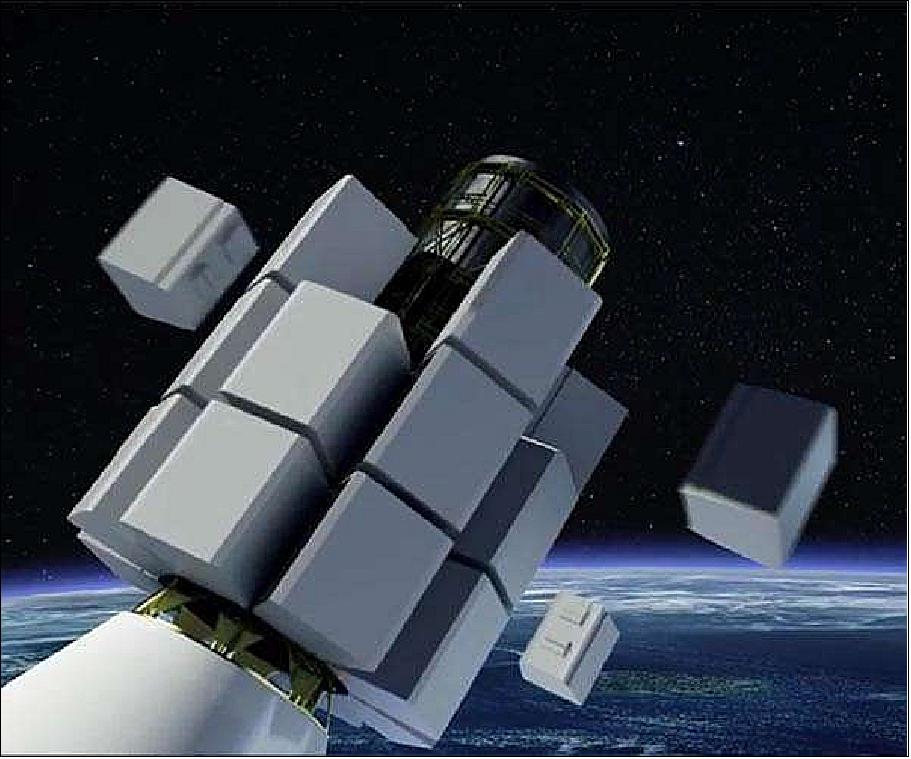
- "Our dispenser is super-light and includes state-of the art technology to safely place the satellites in orbit", says RUAG Space Executive Vice President Peter Guggenbach. "With our products we are contributing to this important project, which will enhance communication around the world."
- Starting from the launch in February 2020, the RUAG built OneWeb dispenser will include a conical top structure, a "hat", that has the capability to host up to four additional OneWeb satellites per mission.
- RUAG Space has developed a unique and cost effective solution that enables OneWeb to maximize the number of satellites per Soyuz launch. The top structure was developed within the contract with Arianespace for the OneWeb program.
- RUAG dispensers, produced in Sweden, are especially suitable for spacecraft constellations such as OneWeb, where a high number of spacecraft need to be placed in orbit within a short time frame. At its lower interface the dispenser structure is bolted to the launch vehicle upper stage. Each satellite is attached to the dispenser in separation nodes. The RUAG dispenser provides a stiff connection in each node during launch, a safe release and an accurate separation provided by the four separation nuts and spring units.
• February 3, 2020: Thirty-four satellites for the OneWeb constellation are ready for launch from Baikonur, Kazakhstan. The satellites which arrived in two shipments, including one last week, have been tested, and have now been fitted into the dispenser of the Soyuz-2.1b rocket. OneWeb’s upcoming launch of 34 satellites has been scheduled for Thursday 6 February 21:42 (GMT) / Friday 7 February 02:42 (local time) from the historic Baikonur Cosmodrome, Kazakhstan. 75)
- “This launch will be a massive step forward for OneWeb – one step closer to the ambition of improving global connectivity. These 34 satellites will join the six currently operating flawlessly in orbit. Our joint venture OneWeb Satellites produces two satellites a day – in series production, just like Airbus makes planes,” said Jean-Marc Nasr, Head of Airbus Space Systems.
- The satellites, which are manufactured at 1/50th of the cost of a traditional spacecraft, are all fitted with plasma thrusters enabling them to reach their correct position in LEO (Low Earth Orbit) at 1,200 km.
- “Watching the first batch of our factory-built satellites launch from the Soyuz will be the realization of a four-year journey... and just the beginning,” said Tony Gingiss, CEO OneWeb Satellites. “Our factory continues to ramp up and streamline our production to deliver the next batch ... and the next ... and the next!”
- The OneWeb constellation will provide global connectivity with an initial 650 satellites. OneWeb’s mission is to provide affordable, high-speed internet connectivity everywhere for everyone, by 2021.
- After this first launch from Baikonur, OneWeb is planning to launch around 30 satellites with Soyuz rockets every month.
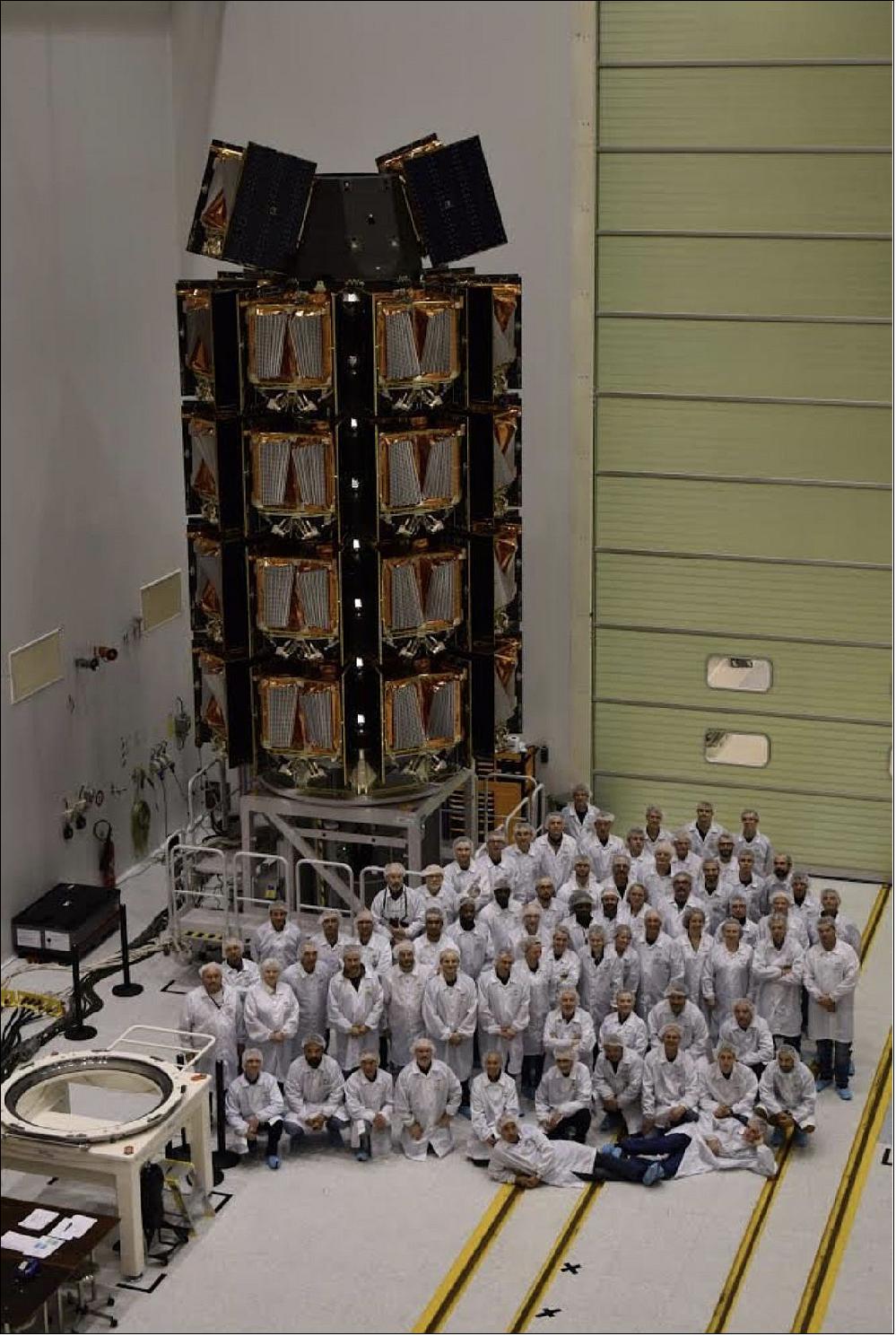
• January 30, 2020: OneWeb, the global communications company with a mission to bring connectivity to everyone everywhere, today confirms its upcoming launch of 34 satellites has been scheduled for Thursday 6 February at 21:42(GMT) / Friday 7 February 02:42 (local time)from the historic Baikonur Cosmodrome, Kazakhstan. 76)
- This marks the start of a regular launch campaign during 2020 that will rapidly grow OneWeb’s first phase constellation of 648 satellites and represents one of the largest civilian satellite launch campaigns in history. Each satellite forms an integral part of the high-speed global satellite broadband network and together will activate OneWeb’s first customer demos by the end of 2020 to provide full commercial global services for sectors such as maritime, aviation, government and enterprise in 2021.
- In this first OneWeb launch of 2020, thirty-four satellites will be aboard a Soyuz launch vehicle. Arianespace will perform the launch, which will place the satellites into a near polar orbit at an initial altitude of 450 kilometers from where they will rise to their final orbit of 1,200 kilometers and form part of OneWeb’s global communications network. All the satellites are manufactured by OneWeb Satellites, a joint venture between OneWeb and Airbus Defence and Space.
- OneWeb has chosen the theme Space for Everyone for the first launch of its 2020 Launch Program, showing how Space is becoming more relevant to everyday life as an important source of connectivity. In collaboration with governments, investors and distribution partners, OneWeb will bring its customers a new experience of connectivity together with social, educational and sustainability benefits. OneWeb’s vision is to see every school connected and it continues to be committed to tackling the digital divide that exists between the connected and unconnected.
- Launch Partner: Arianespace
- Launch Facility: Soyuz Launch Complex, Baikonur, Kazakhstan.
• November 12, 2019: The first Soyuz launch from Kazakhstan carrying a full load of more than 30 Florida-built satellites for OneWeb’s broadband Internet network has slipped from December to mid-to-late January, OneWeb officials said. 77)
- A OneWeb spokesperson said the satellites will be transported from their factory near NASA’s Kennedy Space Center to the launch base at the Baikonur Cosmodrome in Kazakhstan next month. OneWeb aims to begin limited service with its broadband network, which will eventually number at least 650 satellites.
- “We are taking the utmost care to prepare for launch and therefore are taking a few extra weeks to conduct additional tests on the satellites which will be shipped in December for launch,” said Katie Dowd, a OneWeb spokesperson. “We are targeting our next launch for mid-to-late January and remain on track for monthly launches thereafter and to begin service in the Arctic in late 2020 and global coverage in 2021.”
- OneWeb launched its first six test satellites — each about the size of a mini-fridge — in February aboard a Soyuz rocket from the Guiana Space Center in South America. Those satellites were built at an Airbus Defense and Space factory in Toulouse, France.
- OneWeb Satellites, a joint venture between OneWeb and Airbus, opened a 105,500 square foot (9800 m2) satellite production facility in July at Exploration Park, Florida, just outside the gates of the Kennedy Space Center. OneWeb is building the rest of its satellites there, at a rate the company says will increase to produce up to two spacecraft per day.
- Arianespace won a lucrative contract in 2015 for 21 Soyuz launches to carry OneWeb’s initial constellation of 650 satellites to orbit. After the launch in February from French Guiana, Arianespace has 20 more Soyuz flights in its backlog to fill out the OneWeb constellation. The launches could take off from Baikonur, French Guiana, or the Vostochny Cosmodrome in Russia’s Far East.
- The first flight of Europe’s new Ariane 6 rocket late next year will also loft a batch of OneWeb satellites. OneWeb and Arianespace announced the agreement for the Ariane 6 flight earlier this year. OneWeb has contract options for launches aboard two additional Ariane 6 missions.
- OneWeb’s Ku-band satellites fly polar orbit around 745 miles (1,200 km) above Earth, but the Soyuz launchers release the spacecraft — each about the size of a mini-fridge — at a lower altitude. The satellites use plasma thrusters to maneuver into the OneWeb constellation.
- OneWeb’s broadband fleet could grow to 1,980 satellites, the company said.
- Earlier this year, OneWeb announced that it demonstrated live HD video streaming through the company’s first six satellites. OneWeb and Iridium, which operates a low Earth orbit network with 66 cross-linked L-band communications and data relay satellites, announced an agreement in September to work toward a combined service offering.
- OneWeb is in heated competition with SpaceX, which has launched 120 Starlink broadband satellites on two dedicated Falcon 9 rocket flights this year, the most recent of which occurred Monday (11 November 2019 ).
• July 22, 2019: OneWeb Satellites – a joint venture of OneWeb and Airbus – today officially opened the world’s first high-volume, high-speed advanced satellite production facility to bring transformative internet connectivity to everyone, everywhere. 78)
1) Opening marks a breakthrough in technology and manufacturing, enabling first-ever rapid production of communication satellites.
2) Supports deployment of OneWeb network to bring transformative internet connectivity to everyone, everywhere.
3) Facility provides ability to produce high quality satellites at speed, cost, standard, that wasn’t possible before.
4) Opening comes just months after launch of first satellites, now operational in space.
- Historically, satellites are custom built, costing tens of millions of dollars to build, and taking more than a year to produce a single one. The OneWeb Satellites facility is the first to employ industrial-scale mass production techniques for satellites, enabling dramatically reduced costs and production times that can deliver one satellite per production shift or two a day, while significantly expanding internet connectivity and making space technology far more accessible.
- “OneWeb Satellites and its partners are transforming the satellite and space industry. By producing high quality satellites at a fraction of the cost and schedule of traditional manufacturers, we are not only enabling OneWeb to connect the planet, we are making space dramatically more accessible to everyone,” said Tony Gingiss, CEO of One Web Satellites.
- The facility’s production capabilities will first support the rapid scaling of the OneWeb network, starting with a constellation of 650 satellites and scaling to 1,980 satellites delivering global connectivity.
- With half the world’s population unconnected, and inconsistent connectivity persisting as people travel more at sea and in the skies, the high-performance communication satellites built in this facility will enable high-speed internet access that can unlock healthcare, education, and economic advancements.
- “This is a defining moment in the history of OneWeb, and the space industry. With today’s opening, we are one step closer to connecting the unconnected for the benefit of societies all over the world,” said Adrian Steckel, CEO of OneWeb. “As we gear up for more satellite launches at the end of the year, this facility will ensure we can begin delivering global connectivity in some areas as early as next year and globally in 2021.”
- The 105,500 square foot (9800 m2) production facility, which has two production lines capable of producing two satellites a day, is helping to revitalize Florida’s Space Coast with 250 new high-tech jobs and 3,000 indirect jobs through the supply chain.
- Government officials including U.S. Secretary of Commerce Wilbur Ross, U.S. Senator Rick Scott, U.S. Rep. Bill Posey, FCC Chairman Ajit Pai, Assistant Secretary of State for Economic and Business Affairs Manisha Singh, and business and community leaders in Merritt Island, Florida near the Kennedy Space Center attended the official opening with the team.
- For Airbus, this new facility is the latest step in the company’s continued and long-standing growth in U.S. manufacturing, job creation and investment. Airbus utilizes 450 U.S. suppliers in 40+ states and has spent more than $187 billion in the U.S. since 1990. Airbus spending in the U.S. supports more than 275,000 American jobs.
- “Airbus is manufacturing products in the U.S. from all of our business divisions – commercial aircraft, helicopters and now satellites,” said C. Jeffrey Knittel, Chairman and CEO of Airbus Americas. “We take seriously our partnerships in the communities where we do business, and we’re proud to contribute our aerospace manufacturing expertise to the Space Coast with 250 new high-tech jobs in Florida. We are equally excited to welcome these new employees to the Airbus OneWeb Satellites team in the U.S.”
- OneWeb Satellites’ game-changing manufacturing technology and facility also represent a tremendous opportunity for other commercial and government customers, providing end-users with dramatic cost savings and opening the door to missions that were previously unthinkable.
- “The avenue for unlocking untapped human potential lies, yet to be paved, in space,” said Secretary of Commerce Wilbur Ross. “Private industry is a key partner in this effort as we are well on our way to a $1 trillion space economy and fueling a new revolution in technology in orbit.”
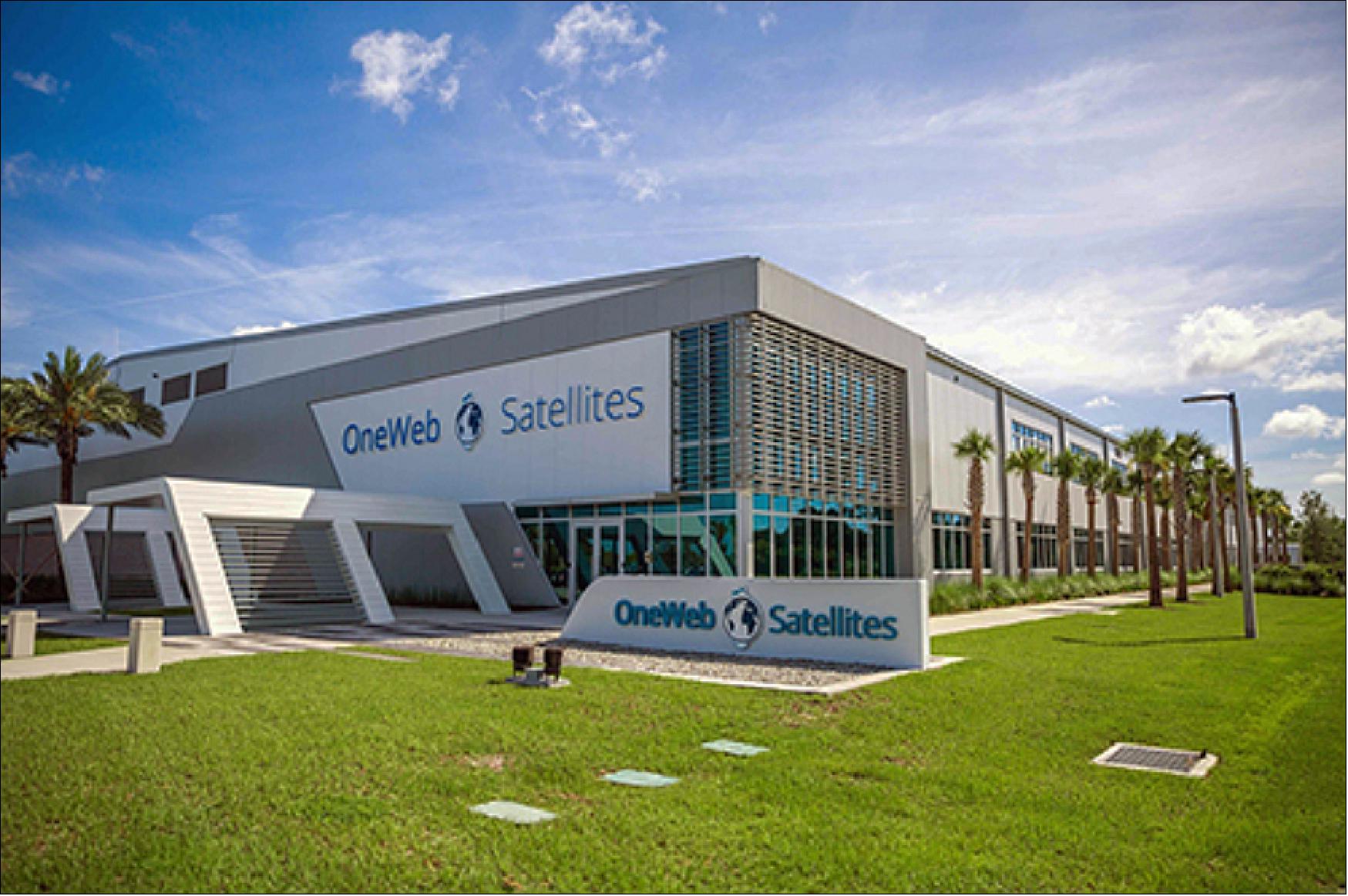
- Chairman Pai added: “Since my first day as Chairman of the FCC, my number one priority has been closing the digital divide and bringing the benefits of the digital age to all Americans. Promoting innovative technologies will be critical to accomplishing that priority. Satellite constellations have the ability to deliver broadband services using a new generation of low-Earth orbit satellite technologies. That’s why the FCC under my leadership approved OneWeb’s proposal and why I was pleased to attend the opening of OneWeb Satellite’s production facility. At the FCC, we’ll continue our work to make access to high-speed Internet available across the country.”
Key production and satellite statistics
a) The facility is capable of producing up to two satellites every day, or one per assembly line shift. Traditional manufacturers generally take more than a year to build a single satellite.
b) The facility can produce a satellite for approximately 1/50th of the cost of a traditional manufacturer.
c) Total Spacecraft Mass – 150 kg
d) Payload Mass – 60 kg
e) Propulsion – Electric (Xenon HET)
f) The design life of the satellites will be greater than seven years in a 500 km orbit and greater than five years in a 1,200 km orbit.
• February 25, 2019: A broadband satellite startup company plans to launch a satellite into space next week with an Anchorage elementary school’s name on it, a symbol of an intensifying race to bring cheaper, faster internet to Alaska. 79)

- Engineers with the company, OneWeb, visited Government Hill Elementary School on Thursday. Lesil McGuire, a former Alaska state senator, met OneWeb’s founder, Greg Wyler, in Barrow years ago. McGuire, now a consultant for OneWeb, suggested Government Hill as one of six schools around the globe to be the first to receive its satellite internet. The other schools are in Nepal, Kyrgyzstan, Rwanda, Ecuador and Honduras.
- In 2017, Anchorage-based Alaska Communications signed an agreement with OneWeb to become the state’s first reseller of the broadband access.
- In Ernestina Liranzo’s fifth-grade classroom at Government Hill Elementary on Thursday morning, OneWeb engineers Kevin Macko and Katelyn Sweeney talked about satellites and took questions from students. Kids peppered the engineers with questions, about aliens, black holes and how satellites avoid crashing into each other in orbit.

- The students later voted to name the satellite "Nanuq Polar Oso", a mash-up of Inupiaq, English and Spanish for “polar bear.” When the satellite launches, it will have a sticker on it with a map of Alaska and the school’s name, according to OneWeb.
- Eventually, an iPad-sized antenna will be installed on the roof of Government Hill Elementary to receive the satellite internet signal and allow students to communicate with the five other remote schools, McGuire said. The company is aiming to turn on its network in 2020.
• February 19, 2019: Affordable worldwide internet coverage is one step closer today, after 18 million pounds of UK Space Agency funding was awarded to OneWeb through the European Space Agency, to aid the development of its next generation satellite constellation. 80) 81)
- A global communications network in space, the system will be comprised of approximately 650 satellites initially and scale to more than 900 satellites over time.
- Science Minister Chris Skidmore is visiting the European Space Agency in the Netherlands today. He will say: "Fast internet access is something many people take for granted but in many areas of the world connectivity is still hit and miss.
- "This new 18m pound investment will go towards meeting the significant technical challenges of the project, putting the UK at the forefront of cutting-edge research and development. The commercial potential for a cost effective worldwide telecoms satellite system is huge, and the UK space sector is playing a leading role in delivering it. It is made possible by our ongoing commitment to the European Space Agency and our world-leading capabilities in space and telecommunications, which we are supporting through our modern Industrial Strategy."
- UK business OneWeb, which is headquartered in London and will employ up to 200 staff at its' White City offices, is poised to take advantage of cost effective spacecraft launch and manufacturing to deploy hundreds of satellites that could provide more affordable internet connectivity to people and businesses across the world.
- The OneWeb Sunrise program will initially focus on technologies for the next generation of satellite payloads, ground connections and space debris removal.
- The UK Space Agency investment will also support novel automation techniques and artificial intelligence to manage the proposed constellation of spacecraft and its interaction with terrestrial networks to realize global 5G connectivity.
- Adrian Steckel, CEO, OneWeb said: "Providing access to people everywhere has been the mission and vision of OneWeb since the very beginning. We will be able to realize this vision in part because of important partnerships like this one with the UK Space Agency, ESA and a range of other important partners including our European and Canadian partners. Thanks to this support, we will focus together on next generation technologies that will be game changers for realizing global 5G connectivity. - We are excited about the application of artificial intelligence and machine learning technologies to develop novel automation techniques that could help manage our constellation in future and ensure we do so safely and responsibly so that we can protect space for future generations."
- Today's announcement comes as a result of the UK's leading investment in the European Space Agency's telecommunications research program ARTES (Advanced Research in Telecommunications Systems).
- ESA is independent of the European Union and hosts its European Center for Space Applications and Telecommunications (ECSAT) in Harwell, Oxfordshire, furthering the UK's world-leading position in satellite communications.
- Magali Vaissiere, ESA Director of Telecommunications and Integrated Applications said: "Sunrise is a prominent endeavor falling under our Satellite for 5G Initiative. It represents the exciting and required new direction ESA is taking in support of our Member States' industry to remain at the forefront of not only the most advanced developments within the space world, but also to enable the necessary complement to the terrestrial networks that satellites will have to play to ensure a successful and fully inclusive digitization of industry and society."
- This ESA project will span seven nations including Canada and is an example of how the UK will continue to work across Europe and globally.
- The news comes as the first batch of 10 satellites of the OneWeb constellation are due to be launched on an Arianespace Soyuz rocket from Europe's Spaceport in French Guiana next week (26 February).
- The UK is a world leader in telecommunications satellites. Last month EUTELSAT QUANTUM, the first satellite capable of being completely reprogrammed after launch left the UK for final assembly and testing in France.
- And in November last year, Eutelsat and Airbus signed a new contract worth hundreds of millions of pounds that will see components and parts for two further communications satellites assembled in the UK. This means that 6 out of 7 of the company's next satellites will be partially built in Britain.
- The UK space sector is growing rapidly, employing 42,000 people and playing a major role in the global shift towards the commercialization of space activities - known as 'New Space'. The UK space industry is commercially focused with 82% of income from sales to consumers and businesses. The latest industry figures show it has an income of 14.8 billion pounds, employment of 41,900 and exports worth 5.5 billion pounds.
• February 13, 2019: Arianespace has completed a major preparation milestone for its next Soyuz launch with integration of the mission’s high-profile payload: the initial six spacecraft in OneWeb’s constellation, which will provide affordable high-speed internet access for users around the world. 82) 83)
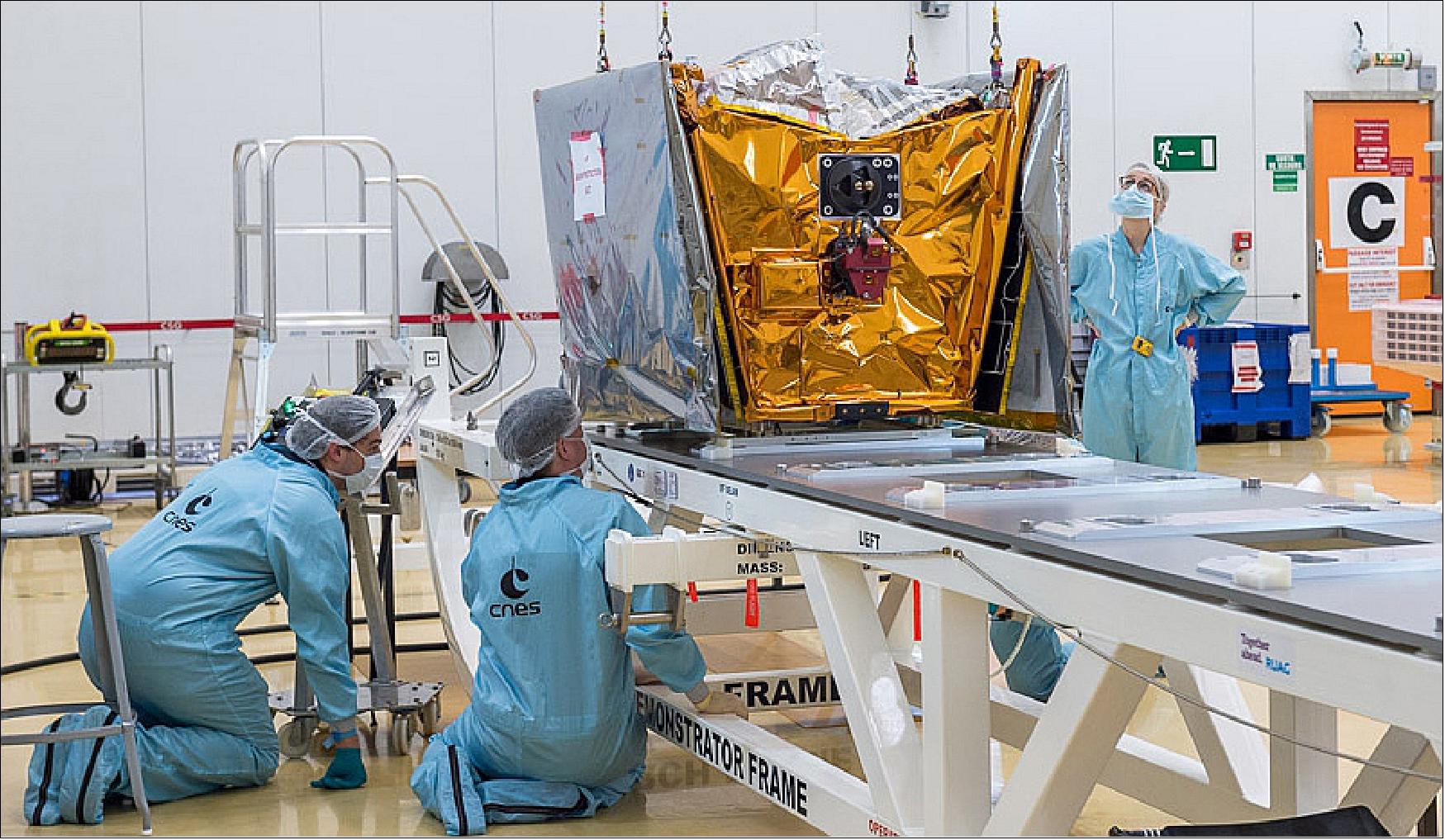
- The spacecraft – produced by the OneWeb Satellites joint venture of OneWeb and Airbus – will be orbited on Arianespace’s first Soyuz mission of 2019 from the Spaceport in French Guiana. Designated Flight VS21, it has a targeted liftoff of February 26.
- Integration of the six satellites on their multi-payload dispenser system – which will deploy them during the mission from atop Soyuz’ Fregat upper stage – was completed in the Spaceport’s S3B payload preparation facility.
- Once placed in a near-polar orbit by Soyuz, the OneWeb spacecraft will operate at an altitude of 1,200 km, giving customers extremely low latency and providing communications access to the entire world with fiber-quality internet connectivity. OneWeb is building the world’s largest and highest throughput satellite system to connect everyone, everywhere – by land, air, sea with a vision to bridge the digital divide once and for all.
• January 22, 2019: OneWeb Satellites, a joint venture between Airbus and OneWeb, today announced the delivery of the first satellites for the OneWeb constellation. 84)
- The satellites were manufactured at the OneWeb Satellites facility on the Airbus Defence and Space Toulouse site and the first six have been shipped to Kourou for launch. The first launch of the mega constellation is scheduled for 19 February 2019 on a Soyuz rocket - the beginning of a long series.
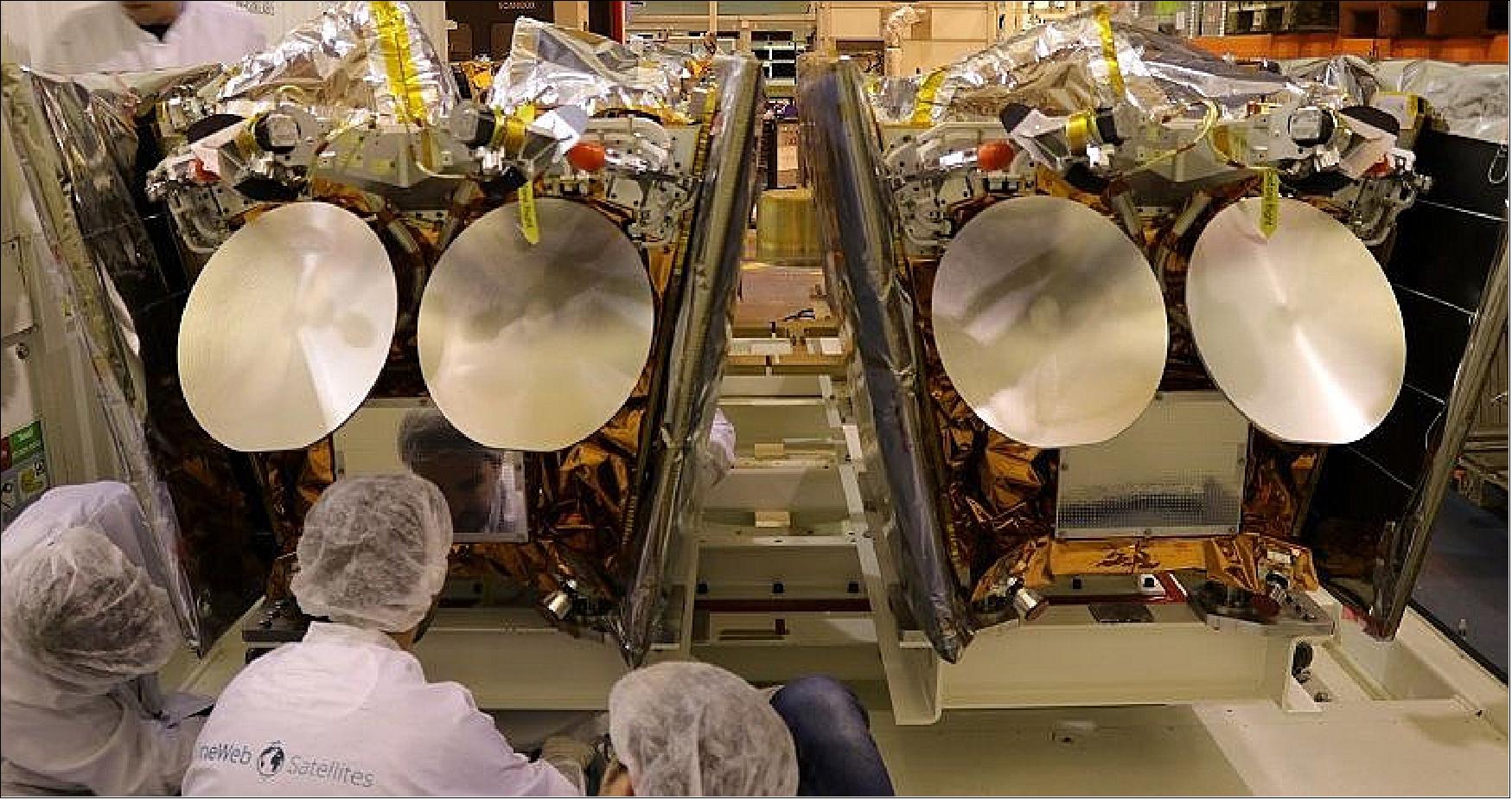
- With this generation of satellites, OneWeb Satellites is entering a new chapter in the story that started three years ago. “Our team is transforming the space industry and we are in the midst of demonstrating we can deliver on our promises,” said Tony Gingiss, OneWeb Satellites CEO.
- OneWeb Satellites will now turn its focus to ramping up production of the full constellation of satellites in its new factory in Florida, demonstrating once again the agility of this JV (Joint Venture).
- OneWeb Satellites is a joint venture between OneWeb, a global communications company whose mission is to provide Internet to everybody, everywhere, and Airbus with its first order to include the production of ultra-high performance communications satellites. The Toulouse OneWeb Satellites facility is being used to validate the innovative production methods necessary to manufacture these satellites at a scale never achieved before, de-risk any potential issues, and lay the framework for the larger multi-line OneWeb Satellites factory near the Kennedy Space Center, Florida. The satellites have a mass of about 150 kg and will operate in a near-polar 1,200 km orbit.
• December 13, 2018: Satellite broadband startup OneWeb, now three months from the launch of its first satellites, is reducing the size of its initial LEO (Low Earth Orbit) constellation by a third. Greg Wyler, OneWeb’s founder, said the company will need only 600 satellites or so instead of 900 after ground tests of the first satellites demonstrated better than expected performance. 85)
- “What it does is it lowers the cost structure to reach that first phase of global coverage,” Wyler said in a Dec. 13 interview. “Rarely do you see costs go down, so it’s a pretty big deal.”
- OneWeb had been under increased scrutiny within the satellite industry amid speculation that its satellite costs had grown well beyond their initial $500,000 target. Wyler confirmed the satellites had passed $500,000 a unit, but said the exceedance was minimal. “It is higher than the goal, but it’s significantly lower than where things would have been predicted three years ago,” he said.
- Wyler said OneWeb has added back ups for all major components on the satellites, including redundant computers and four reaction wheels per satellite, to improve the reliability of each spacecraft. OneWeb is building its satellites through a joint venture with Airbus Defence and Space.
- OneWeb has raised $1.7 billion to date from investors including Japanese conglomerate Softbank, fleet operator Intelsat and soft drink giant Coca-Cola. The heavily capitalized startup is seeking to raise the rest of its needs — at least several hundred million dollars if not over a billion based on previous estimates — through export credit agencies, though little progress has been visible since the last equity raise in late 2016.
Launch
• Launch 13: On 10 February 2022 at 18:09 UTC (15:09 local time in Kourou), Arianespace flight VS27 on a Soyuz vehicle launched another batch of 34 OneWeb satellites from the Guiana Space Center, bringing the size of the fleet into LEO (Low Earth Orbit) to 428. 86) 87)
- All satellites were released from the rocket’s Fregat upper stage over the course of nearly four hours, according to a OneWeb social media post, into a near-polar orbit at around 475 kilometers.
- The satellites will raise themselves over the next few weeks to an operational altitude at around 1,200 km, where they will join others to expand its network to 428 of a planned 648-strong constellation.
- To date, Arianespace has launched five Soyuz missions for OneWeb from the Baikonur Cosmodrome in Kazakhstan, and six from the Vostochny Cosmodrome in Russia.
- Arianespace has said it plans to launch the rest of OneWeb’s constellation this year to enable the company to provide global services.
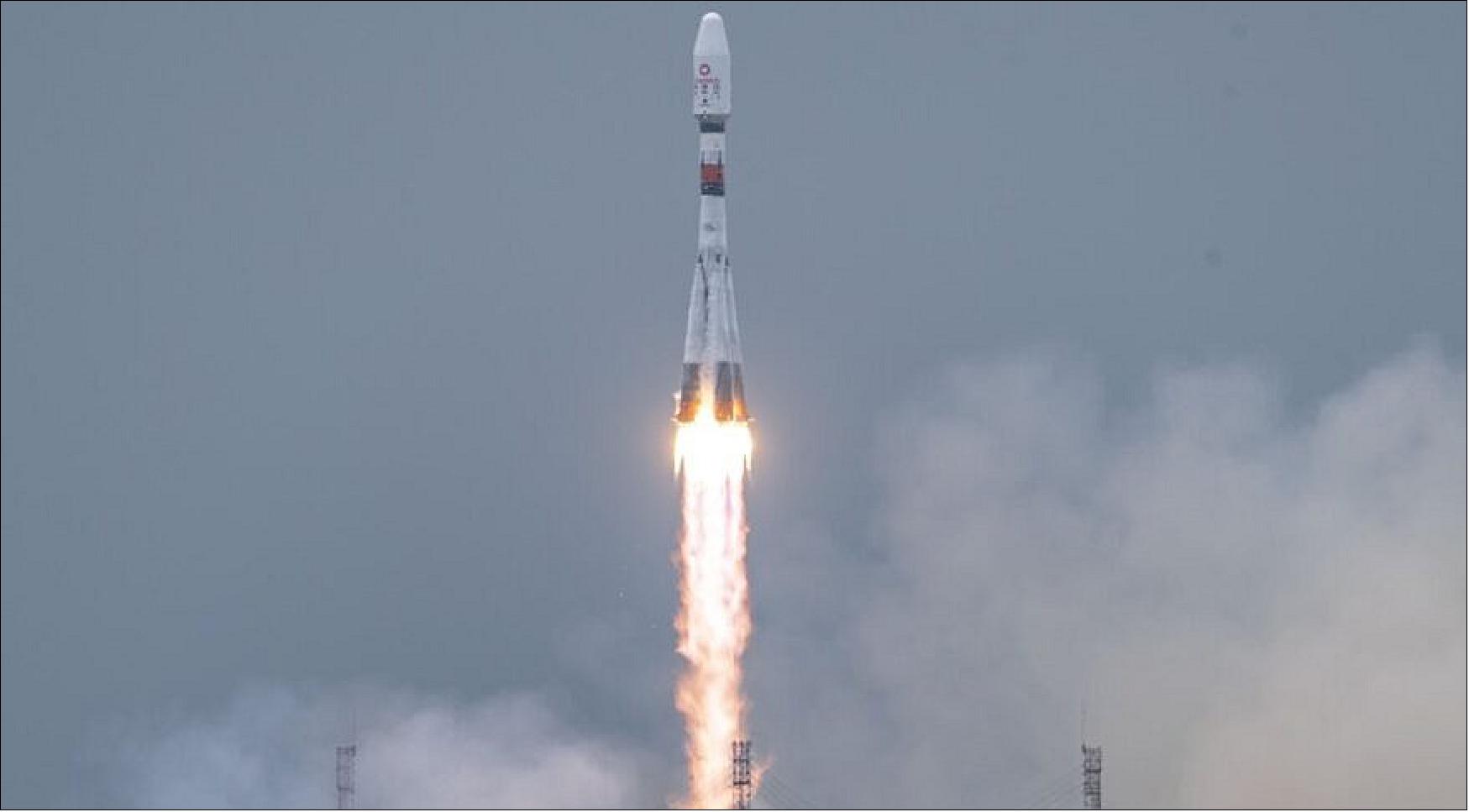
• Launch 12: On 27 December 2021 at 13:10 UTC (06:10 p.m. in Baikonur), a Soyuz-2.1b/Fregat vehicle lifted-off from Russia’s Vostochny Cosmodrome with 36 OneWeb communication satellites onboard. Thanks to ST37, 60% of OneWeb’s constellation is now in orbit, bringing the constellation to 394 satellites launched. Flight ST37 was the 63rd Soyuz mission carried out by Arianespace, the 37th with its Starsem affiliate, and the 12th mission for OneWeb. 88)
- The mission lasted three hours and 45 minutes with signal acquisition on all 36 satellites confirmed. The 36 satellites were deployed during nine separation sequences, at an altitude of 450 km. It was also the fifteenth successful launch operated by Arianespace’s teams this year, bringing to 1,101 the total number of spacecraft orbited since the start of the company’s operations.
- “It is a very special time of the year, right between Christmas and New Year’s Eve. I would like to warmly thank all the Arianespace and Starsem teams involved in this mission and the incredible work they did alongside our Russian partners in order to allow us to launch, from Baikonur Cosmodrome, our 15th and last launch of 2021. This year has been marked by key milestones, the latest one being that, with today’s flight, we will officially have deployed more than 60% of OneWeb’s constellation,” said Stéphane Israël, CEO of Arianespace. “2021 has been a really busy year for us with 15 launches operated from three different spaceports, which represents a 50% increase in launches over 2020. With 2022 headed in the same direction, we are sure to demonstrate that our services and solutions answer our clients’ needs: any time, any mass, any orbit.”
- The launch of the satellites was operated by Arianespace and its Euro-Russian affiliate Starsem under contract with Glavkosmos, a subsidiary of Roscosmos, the Russian space agency. Arianespace is responsible for the overall mission and flight-worthiness, with the support of Starsem for launch campaign activities including management of its own launch facilities at the Baikonur Cosmodrome. RKTs-Progress (the Samara Space Center) is responsible for the design, development, manufacture and integration of the Soyuz launch vehicle as well as for the 3-stage Soyuz flight. NPO Lavotchkin is responsible for the launch preparation operations and flight of the Fregat orbital vehicle.
- The satellites will raise themselves to an operational altitude of 1,200 km over the next few weeks. OneWeb will enter the new year in a position of strength, as it plans to launch global service by the end of 2022 and as demand continues from telecommunications providers, aviation and maritime markets, ISPs (Internet Service Providers), and governments worldwide for its low-latency, high-speed connectivity services to provide businesses and consumers. 89)
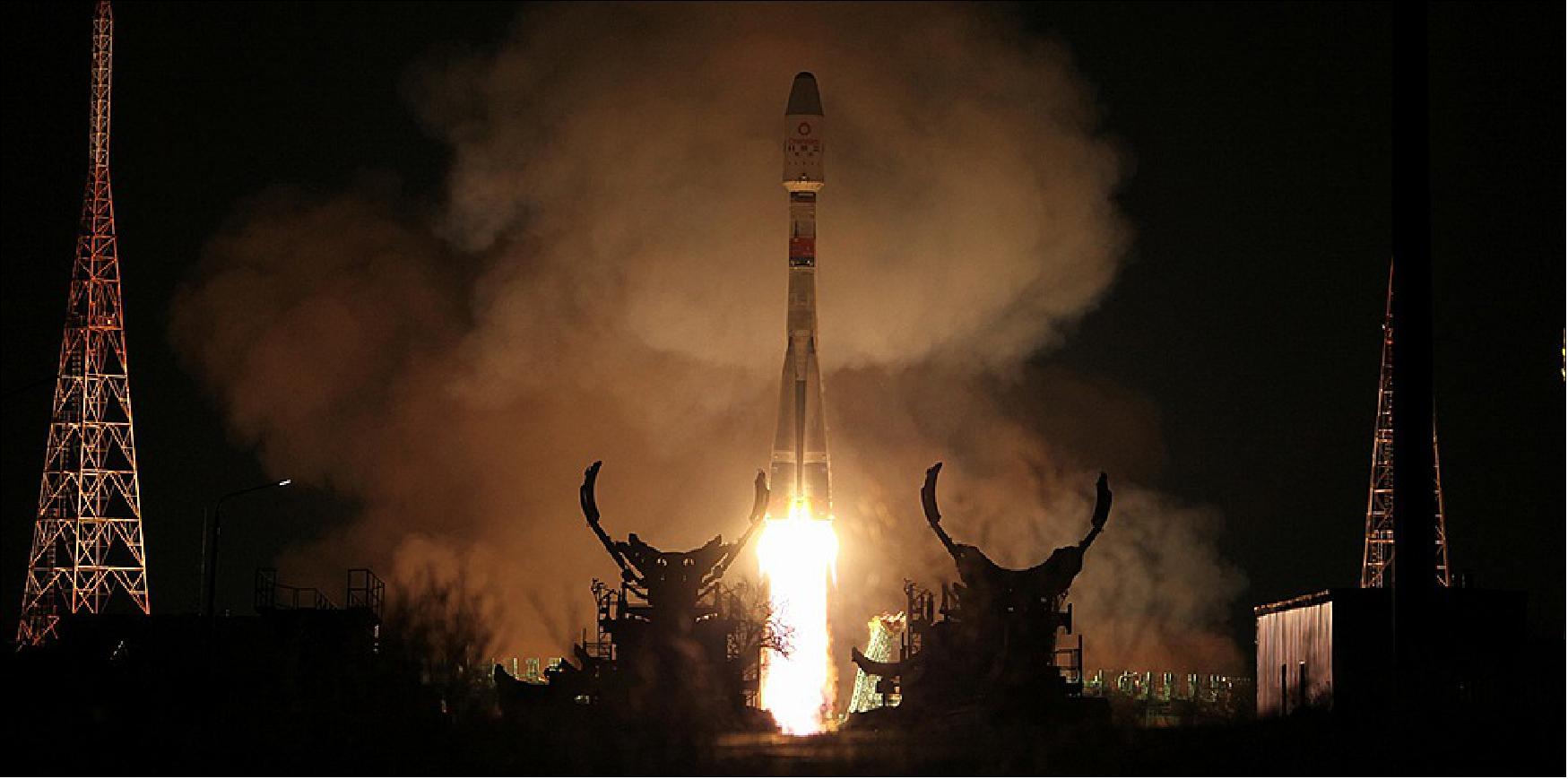
• Launch 11: Performed on Thursday, 14 October 2021 at precisely 6:40 p.m. local time at Russia’s Vostochny Cosmodrome (09:40 UTC), Soyuz Flight ST36 lifted-off with 36 OneWeb satellites onboard, bringing the size of the fleet in orbit to 358, after this successful deployment. Flight ST36 was the 61st Soyuz mission carried out by Arianespace and its Starsem affiliate. The mission lasted three hours and 51 minutes. The 36 satellites were deployed during nine separation sequences, at an altitude of 450 km. 90)
- “Congratulations to all the teams who made this eleventh launch dedicated to OneWeb’s satellites a success,” said Stéphane Israël, CEO of Arianespace. “ST36 marks a new milestone in our common history. Precisely one hour and eighteen minutes after liftoff, during the first separation sequence, we officially crossed the halfway mark for OneWeb’s constellation deployment! By the end of 2022, we will proudly operate eight more Soyuz launches in order to complete full the deployment of the constellation.”
- OneWeb’s mission is to create a global connectivity platform through a next-generation satellite constellation in Low Earth Orbit. The OneWeb constellation will deliver high-speed, low-latency connectivity to a wide range of customer sectors, including aviation, maritime, enterprise and government. Central to its purpose, OneWeb seeks to bring connectivity to the hardest to reach places, where fiber cannot reach, and thereby bridge the digital divide.
- The satellite prime contractor is OneWeb Satellites, a joint venture of OneWeb and Airbus Defence and Space. The satellites were produced in Florida, USA in its leading-edge satellite manufacturing facilities that can build up to two satellites per day on a series production line dedicated to spacecraft assembly, integration, and testing.
- The launch of the satellites was operated by Arianespace and its Euro-Russian affiliate Starsem under contract with Glavkosmos, a subsidiary of Roscosmos, the Russian space agency. Arianespace is responsible for the overall mission and flight-worthiness, with the support of Starsem for launch campaign activities including management of its own launch facilities at the Baikonur Cosmodrome. RKTs-Progress (the Samara Space Center) is responsible for the design, development, manufacture and integration of the Soyuz launch vehicle as well as for the 3-stage Soyuz flight. NPO Lavotchkin is responsible for the launch preparation operations and flight of the Fregat orbital vehicle.
• Launch 10: Soyuz Flight ST35 placed 34 more satellites into orbit. Following this 10th launch for OneWeb, Arianespace has deployed 322 satellites for the global connectivity constellation. 91)
- Nine successful launches and sixth Soyuz operated by Arianespace and Starsem since the start of the year. - With this launch, Arianespace will have deployed 1,021 satellites since its incorporation in 1980.
- Performed on Tuesday, 14 September 2021, at precisely 11:07 p.m. local time at Russia’s Baikonur Cosmodrome (18:07 UTC), Soyuz Flight ST35 lifted-off with 34 OneWeb satellites onboard, bringing, after the successful deployment, the size of the fleet in orbit to 322. Flight ST35 was the 60th Soyuz mission carried out by Arianespace and its Starsem affiliate, and the tenth mission to the benefit of OneWeb.
- The mission lasted three hours and 45 minutes. The 34 satellites were deployed during nine separation sequences, at an altitude of 450 km. It was also the ninth successful launch operated by Arianespace’s teams this year, bringing to 1,021 the total number of spacecraft orbited since the start of company’s operations.
- “Congratulations to all the teams who made this 60th launch with Soyuz, the 10th for OneWeb, a success. We are living a great moment today as we pass the step of our 1,000th satellite launched to space while our customer OneWeb is hitting a new pace with more than 300 satellites in orbit. This 1,000th satellite was named XiliaSat by our community in reference of the meaning of 1,000 in ancient Greek in a contest on our social media,” said Stéphane Israël, CEO of Arianespace. “This launch illustrates the recent acceleration in space operation – one third of these 1,000 Arianespace-launched satellites orbited over the 20 past months – and thus it is incumbent upon us, as leaders in the space sector, to embrace our responsibility to promote sustainable space operations.”
- To date, Arianespace has launched 322 OneWeb satellites with ten Soyuz launches. Arianespace will perform nine more Soyuz launches for OneWeb through 2021 and 2022. These launches will enable OneWeb to complete the deployment of its full global constellation (650 satellites) in low Earth orbit by year-end 2022.
- OneWeb’s mission is to create a global connectivity platform through a next-generation satellite constellation in Low Earth Orbit. The OneWeb constellation will deliver high-speed, low-latency connectivity to a wide range of customer sectors, including aviation, maritime, enterprise and government. Central to its purpose, OneWeb seeks to bring connectivity to the hardest to reach places, where fiber cannot reach, and thereby bridge the digital divide.
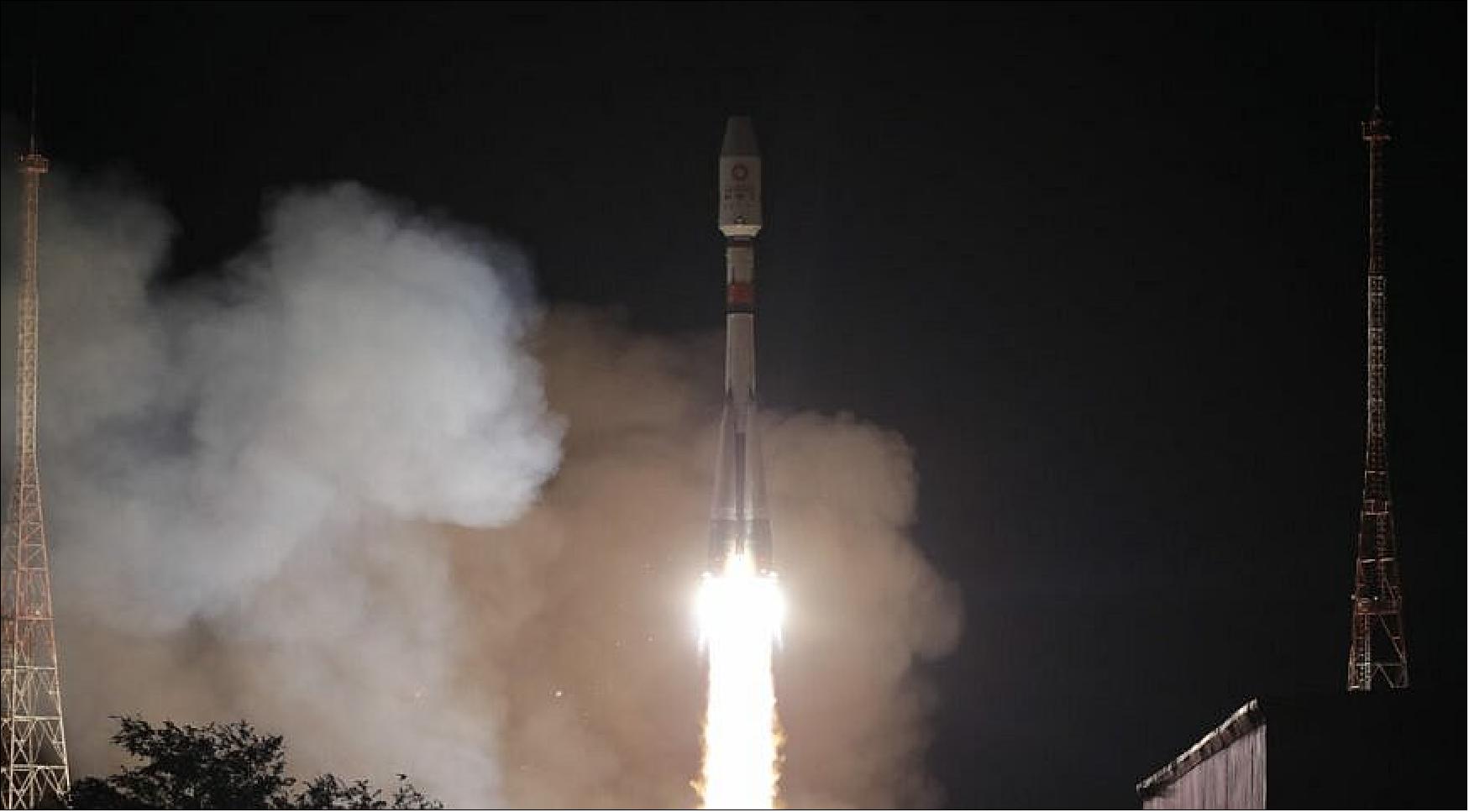
• Launch 9: On 22 August 2021, at 3:13 a.m. local time at Russia’s Baikonur Cosmodrome (22:13 UTC on August 21), Soyuz Flight ST34 lifted-off with 34 OneWeb satellites onboard, bringing, after the successful deployment, the size of the OneWeb fleet in orbit to 288. Flight ST34 was the 59th Soyuz mission carried out by Arianespace and its Starsem affiliate. The mission lasted three hours and 45 minutes. The 34 satellites have been separated, during nine separation sequences, at an altitude of 450 km. It was also the third successful launch operated by Arianespace’s teams in less than one month. 92)
- The launch of the satellites was operated by Arianespace and its Euro-Russian affiliate Starsem under contract with Glavkosmos, a subsidiary of Roscosmos, the Russian space agency. Arianespace is responsible for the overall mission and flight-worthiness, with the support of Starsem for launch campaign activities including management of its own launch facilities at the Baikonur Cosmodrome. RKTs-Progress (the Samara Space Center) is responsible for the design, development, manufacture and integration of the Soyuz launch vehicle as well as for the 3-stage Soyuz flight. NPO Lavotchkin is responsible for the launch preparation operations and flight of the Fregat orbital vehicle.
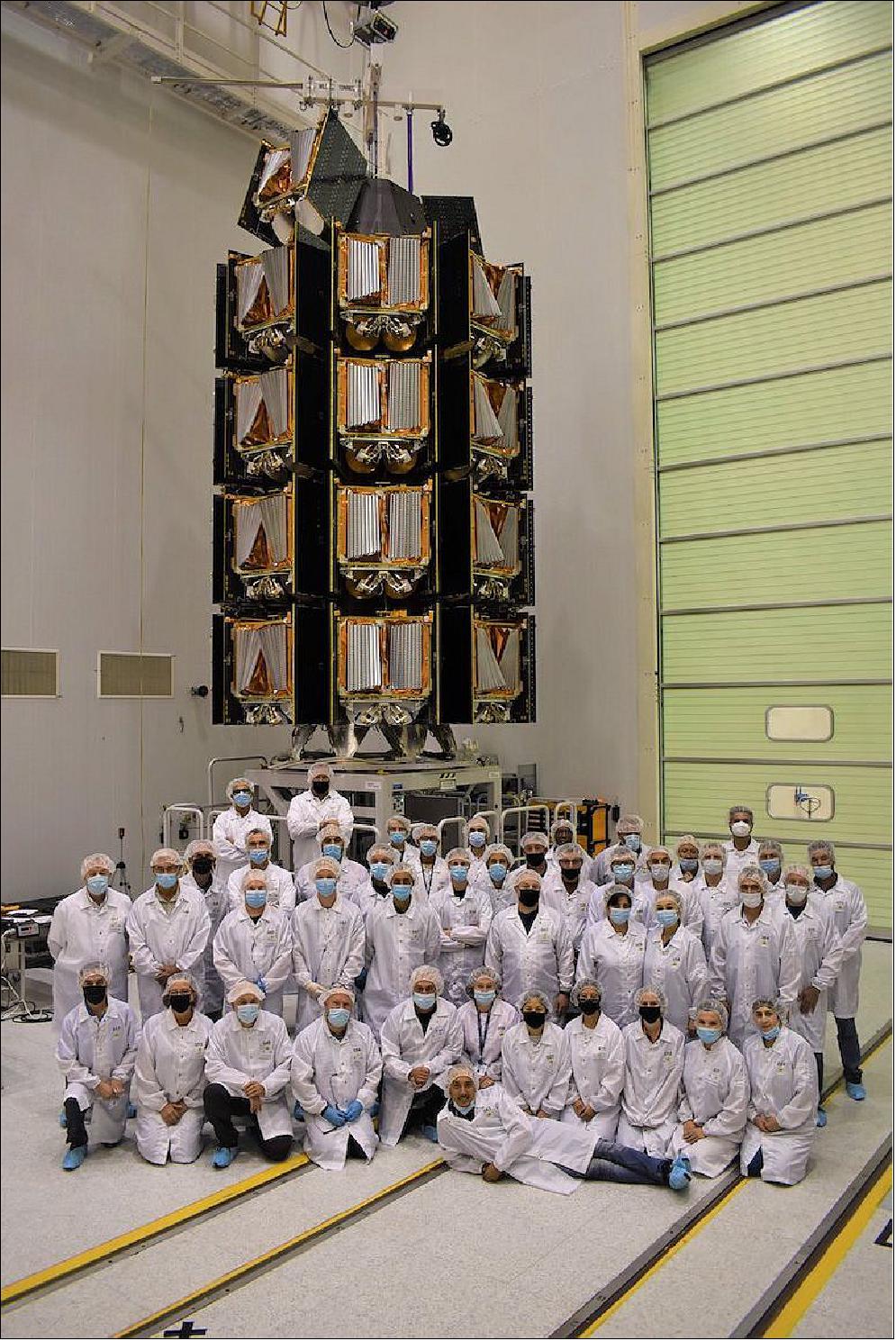
• Launch 8: On 1 July 2021, at 12:48 UTC (09:48 p.m. local time at Russia’s Vostochny Cosmodrome), Soyuz Flight ST33 lifted-off with 36 new OneWeb satellites onboard, bringing after the successful deployment the size of the fleet in orbit to 254. Flight ST33 was the 58th Soyuz mission carried out by Arianespace and its Starsem affiliate. 93) 94)
- “This new launch was very special, marking the completion of OneWeb’s ‘Five to 50’ ambition to bring into orbit the satellites required to enable connectivity services to the 50th parallel and above by years end which includes Canada, U.K., Northern Europe, Alaska and Arctic regions,” said Stéphane Israël, Chief Executive Officer of Arianespace and Starsem. “Congratulations to all the teams who made this eighth launch dedicated to OneWeb’s satellites a success!”
- Arianespace has launched 254 OneWeb satellites through eight Soyuz launches to date. Arianespace will perform 11 more Soyuz launches for OneWeb through 2021 and 2022. These launches will enable OneWeb to complete the deployment of its full global constellation of low Earth orbit satellites before the end of 2022.
- OneWeb’s mission is to create a global connectivity platform through a next-generation satellite constellation in low Earth orbit. The OneWeb constellation will deliver high-speed, low-latency connectivity to a wide range of customer sectors, including aviation, maritime, enterprise and governments. Central to its purpose, OneWeb seeks to bring connectivity to the hardest to reach places, where fiber cannot reach, and thereby bridge the digital divide.
- The satellite prime contractor is OneWeb Satellites, a joint venture of OneWeb and Airbus Defence and Space. The satellites were produced in Florida, USA in its leading-edge satellite manufacturing facilities that can build up to two satellites per day on a series production line dedicated to spacecraft assembly, integration, and testing.
- According to SpaceX, OneWeb has confirmed signal acquisition with each satellite after separating from their Soyuz 2.1b rocket, which launched from the Vostochny Cosmodrome in Russia. 95)
- It will take about a month for the satellites to raise themselves from a near-polar orbit at an altitude of 450 kilometers to 1,200 kilometers, where they will then beam connectivity back to Earth.
- They will complete OneWeb’s interim goal of expanding its footprint to the 50th parallel and above — covering Canada, U.K., Northern Europe, Alaska and Arctic regions, ahead of partial commercial services before the end of this year.
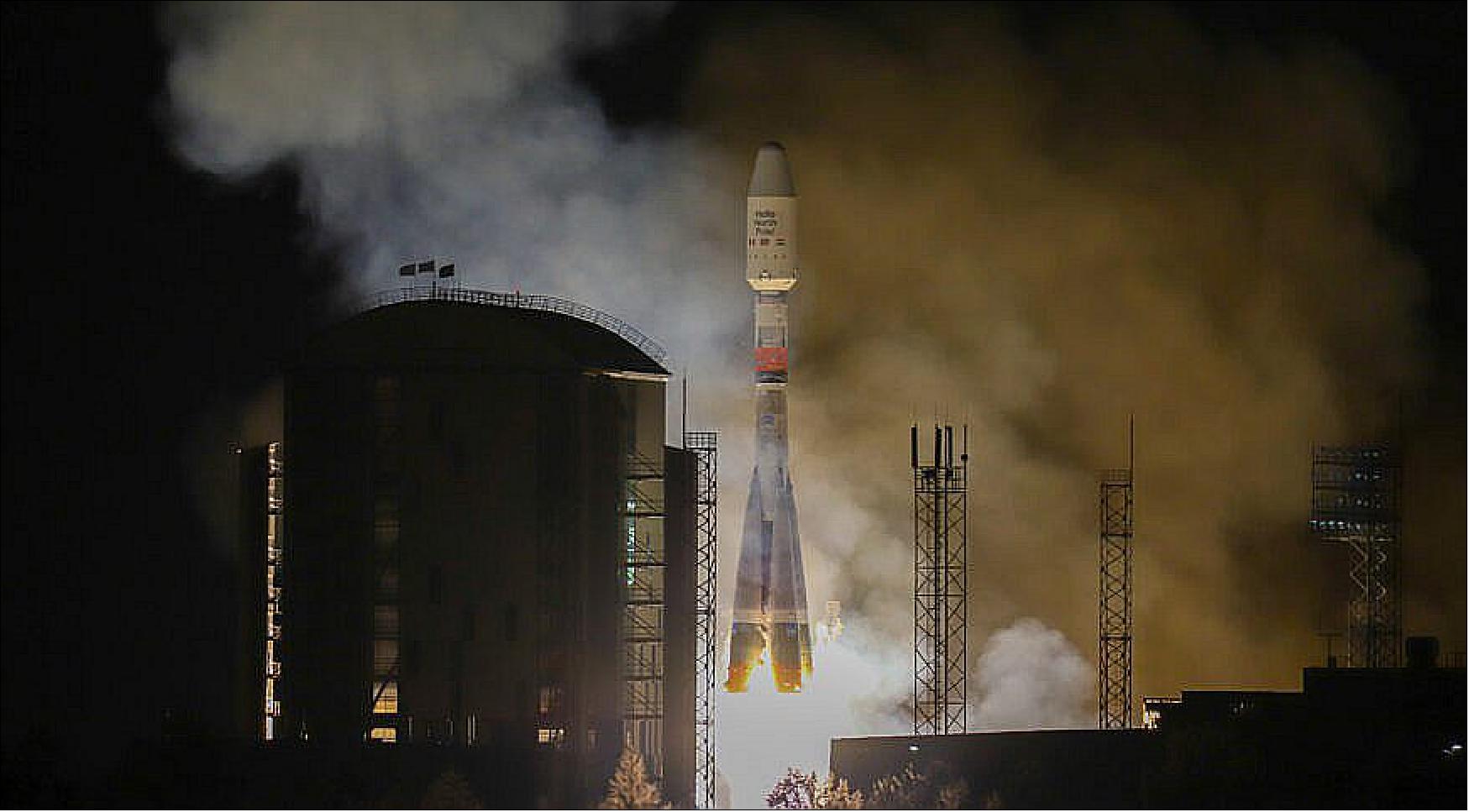
- The venture aims to launch four or five more batches of satellites in 2021 that will focus on filling out the Earth’s southernmost regions, according to Chris McLaughlin, OneWeb’s chief of government, regulation and engagement.
- McLaughlin said 10 more launches are needed to provide global services with the constellation, which recently secured the $2.4 billion it needs for deploying 648 satellites.
- “The next phase is to bring the latitude down to the 20 degree mark in the north and also bring the south pole into play and up to 20 degrees in the south,” he told SpaceNews in an interview.
- “Then there’ll be a belt in the middle of the Earth, which will be filled in during the course of next year.”
- McLaughlin underlined the importance of Australia and New Zealand to the U.K.-headquartered company as countries in the Five Eyes intelligence alliance, which also includes the United States, Canada and the United Kingdom.
• Launch 7: On 28 May 2021, OneWeb confirmed the next successful launch of 36 satellites by Arianespace from the Vostochny Cosmodrome. This launch brings OneWeb a step closer to completing its ‘Five to 50’ ambition and the start of commercial service by the end of the year. 96) 97)
- Liftoff of the Soyuz Flight ST32 (Soyuz-2.1b / Fregat) flight occurred on 28 May at 17: 38 UTC (corresponding to 02:38 a.m. on 29 May local time at Russia’s Vostochny Cosmodrome). OneWeb’s satellites separated from the rocket and were dispensed in nine batches over a period of 3 hours 52 minutes with signal acquisition on all 36 satellites confirmed.
- This latest successful launch brings OneWeb’s total in-orbit constellation to 218 satellites. These will form part of OneWeb’s 648 LEO satellite fleet that will deliver high-speed, low-latency global connectivity. There is now only one launch to go until the company has the satellites required to enable its connectivity solution to reach all regions north of 50 degrees latitude by June 2021.
- OneWeb’s satellites are built by OneWeb Satellites, a OneWeb and Airbus joint venture facility on Merritt Island, Florida that can produce two satellites a day with an innovative production-line process. Thanks to this advanced manufacturing capability, OneWeb is able to rapidly and reliably build its first-generation fleet for completion of delivery into orbit by mid-2022. With this launch, our Florida team can be proud of the 218 satellites it has built and orbited to date.
- This launch represents the fourth in a five-launch program to fulfil the ‘Five to 50’ service, enabling OneWeb to offer connectivity across the United Kingdom, Alaska, Northern Europe, Greenland, the Arctic Seas and Canada. This service is expected to be switched on before the end of the year and OneWeb intends to make global service available in 2022.
• Launch 6: On 25 April 2021 (22:14 UTC, corresponding to 7:14 on 26 April 2021 local time at Russia’s Vostochny Cosmodrome). OneWeb’s sixth launch overall places 36 new constellation satellites into orbit. Arianespace has resumed the deployment of this client’s satellite network, which now comprises 182 satellites in low Earth orbit. 98)
- Soyuz Flight ST31 (Soyuz-2.1b / Fregat) orbited 36 new OneWeb satellites – bringing the size of the fleet in orbit to 182. Flight ST31 was the 56th Soyuz mission carried out by Arianespace and its Starsem affiliate.
- “Congratulations to all the teams who made this latest mission from the Vostochny Cosmodrome a success. This launch again confirms Arianespace’s ability to deploy the OneWeb constellation through the use of three different Soyuz launch sites – in French Guiana, Kazakhstan and Russia,” said Stéphane Israël, Chief Executive Officer of Arianespace. “I want to sincerely thank OneWeb for its trust. I am delighted that our company has contributed – for the sixth time – to this client’s ultimate ambition of providing Internet access to everyone, anywhere, at any time.”
- The satellite prime contractor is OneWeb Satellites, a joint venture of OneWeb and Airbus Defence and Space. The satellites were produced in Florida, USA in its leading-edge satellite manufacturing facilities that can build up to two satellites per day on a series production line dedicated to spacecraft assembly, integration, and testing.
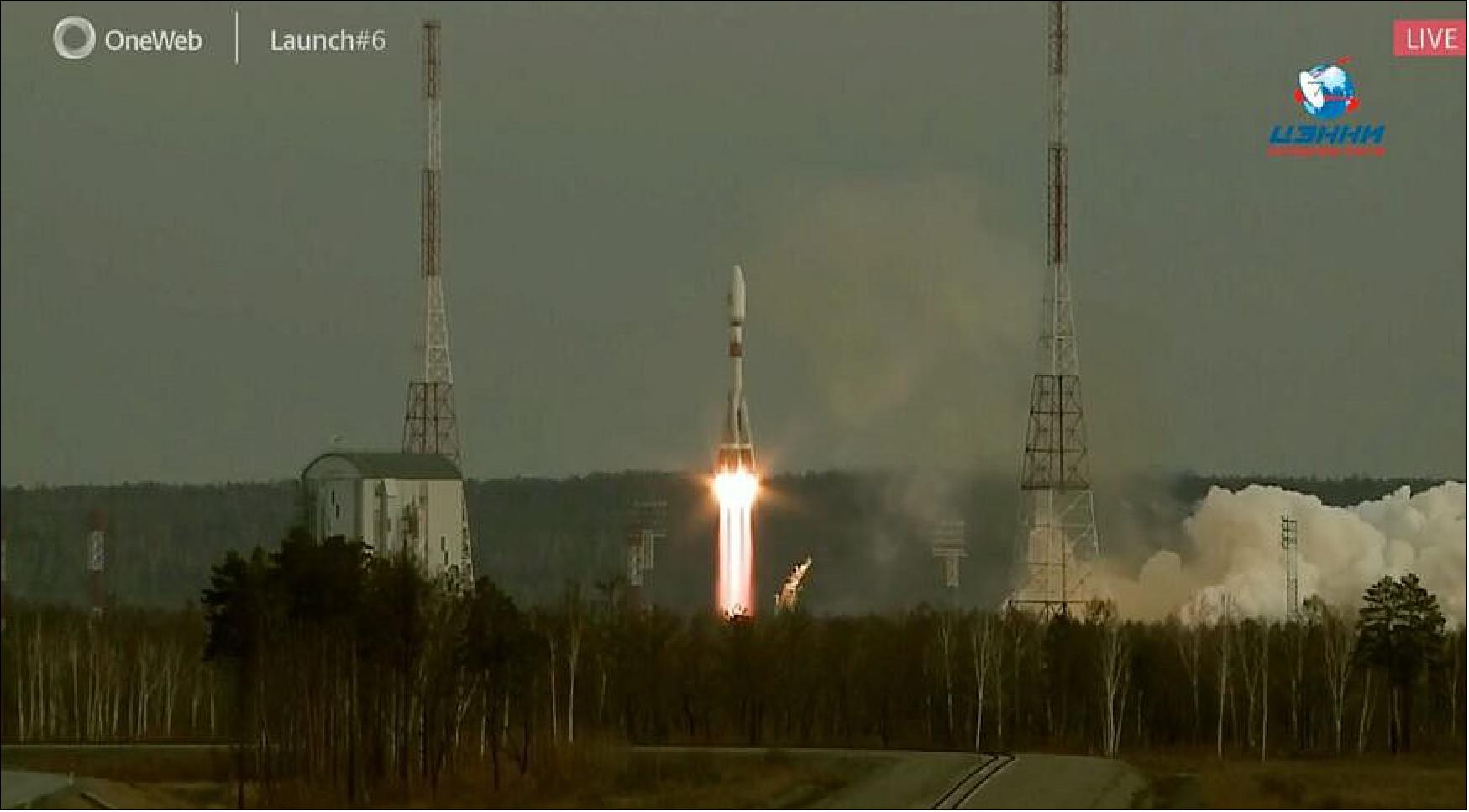
- The satellites were deployed into a near-polar orbit at an altitude of 450 km. The satellites will raise themselves to an operational orbit at an altitude of 1,200 km, following nine separation sequences over a period of about four hours from lift-off.
- One of the satellites from OneWeb’s previous batch of 36, which Arianespace launched March 25, allegedly could have come too close to a Starlink broadband spacecraft operated by SpaceX while making a similar journey.
- OneWeb-0178’s course was adjusted after projected to come close to the Starlink-1546 satellite launched in September 2020, although the exact circumstances around the issue are unclear.
- Arianespace’s latest launch for OneWeb pushes the broadband startup closer to an interim goal to expand coverage to north of 50 degrees latitude by June.
- That coverage goal, which requires launching two more batches of 36 satellites, would enable OneWeb to provide services across the entire United Kingdom before the end of this year — an important milestone for a company recently sold to the British government and Indian telecom company Bharti Global.
- It would also enable OneWeb to cover Alaska, Northern Europe, Greenland, Iceland, the Arctic Seas and Canada.
- OneWeb ultimately plans a 650-strong constellation to deliver global high-speed, low-latency broadband services to enterprise, government, maritime and aviation customers from 2022.
• Launch 5: March 25, 2021. Arianespace has resumed the deployment of this client’s satellite network, which now comprises 146 satellites in low Earth orbit. 100) 101)
- Today’s launch, Flight ST30, was the 55th Soyuz mission carried out by Arianespace and its Starsem affiliate. Performed on Thursday, March 25 at precisely 11:47 a.m. local time at Russia’s Vostochny Cosmodrome (02:47 a.m. UTC), Flight ST30 orbited 36 new OneWeb satellites – bringing the size of the fleet in orbit to 146.
- “Congratulations to all the teams who made this latest mission from the Vostochny Cosmodrome a success. This launch confirms Arianespace’s ability to deploy the OneWeb constellation through the use of three different Soyuz launch sites – in French Guiana, Kazakhstan and Russia,” said Stéphane Israël, Chief Executive Officer of Arianespace. “I want to sincerely thank OneWeb for its trust. I am delighted that our company has contributed – for the fifth time – to this client’s ultimate ambition of providing Internet access to everyone, anywhere, at any time.”
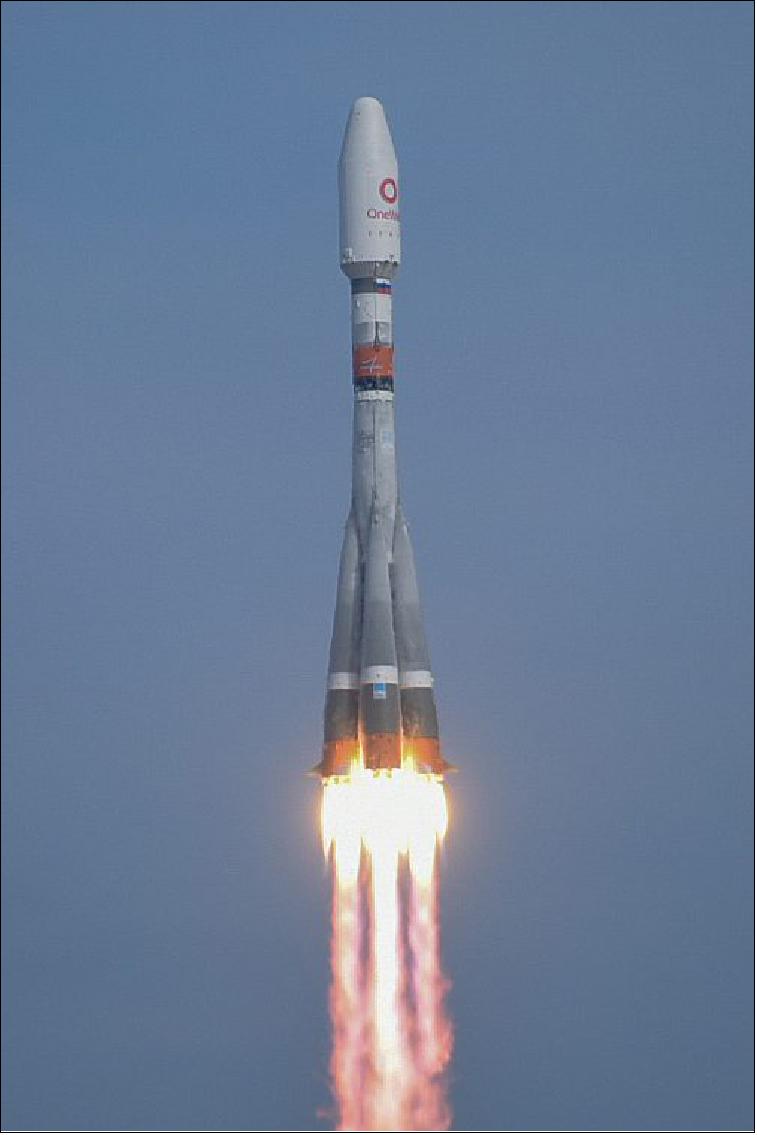
- Arianespace has launched 146 OneWeb satellites to date. Soyuz successfully orbited the initial six from French Guiana during February 2019. In February and March 2020, Arianespace and its Starsem affiliate successfully launched 68 OneWeb satellites from Baikonur Cosmodrome, as well as an additional batch of 36 satellites from the Vostochny Cosmodrome during December 2020.
- Pursuant to an amended launch contract with OneWeb, Arianespace will perform 14 more Soyuz launches through 2021 and 2022. These launches will enable OneWeb to complete the deployment of its full global constellation of low Earth orbit satellites by the end of 2022.
- OneWeb’s mission is to bring internet everywhere to everyone, by creating a global connectivity platform through a next-generation satellite constellation in low Earth orbit. The OneWeb constellation will deliver high-speed, low-latency connectivity to a wide range of customer sectors, including aviation, maritime, backhaul services, and for governments, emergency response services and more. Central to its purpose, OneWeb seeks to bring connectivity to every place where fiber cannot reach, and thereby bridge the digital divide.
- The satellite prime contractor is OneWeb Satellites, a joint venture of OneWeb and Airbus Defence and Space. The satellites were produced in Florida, USA in its leading-edge satellite manufacturing facilities that can build up to two satellites per day on a series production line dedicated to spacecraft assembly, integration, and testing.
Launch 4: OneWeb resumed deployment of its broadband satellite constellation with a launch of 36 OneWeb satellites on 18 December 2020 at 12:26 UTC, the first since the company emerged from Chapter 11 bankruptcy. 102) 103)
A Soyuz-2.1b rocket lifted off from the Vostochny Cosmodrome in eastern Russia. The launch of Flight ST29 was the 53rd Soyuz mission carried out by Arianespace and its Starsem affiliate, marking a milestone as their first from the Vostochny Cosmodrome in Russia. The rocket’s Fregat upper stage released the 36 satellites in nine sets of four satellites each, maneuvering between deployments, completing the process nearly four hours after liftoff.
The Fregat deployed the satellites in orbits at an altitude of 450 kilometers. The spacecraft, built by the Airbus-OneWeb joint venture OneWeb Satellites, will use their onboard propulsion to move into their final orbits at an altitude of 1,200 kilometers. They will join 76 satellites previously launched on three previous Soyuz flights. The size of the OneWeb fleet is now 110.
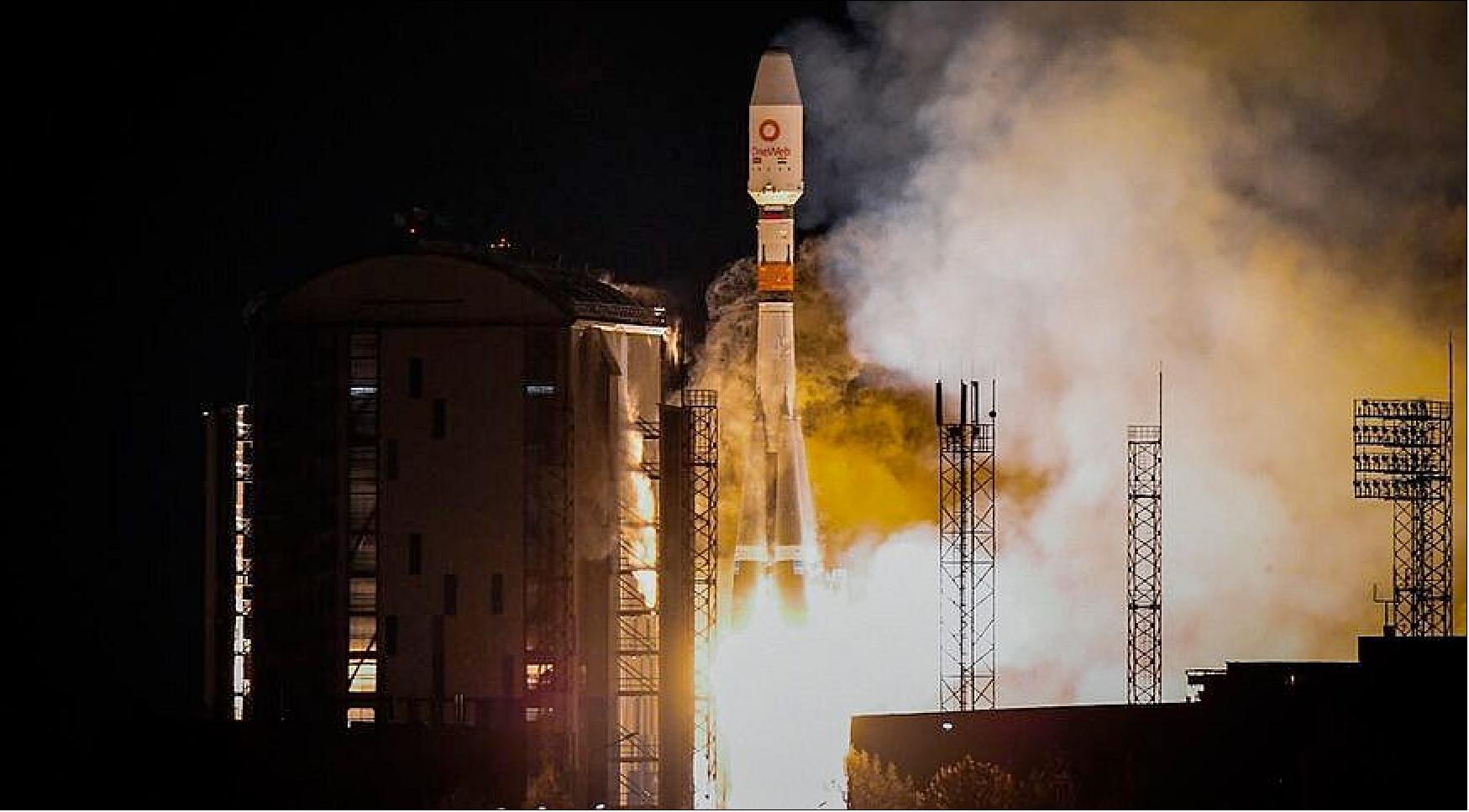
London-based OneWeb said ground teams established contact with the 36 spacecraft, verifying the satellites were alive after launch. “We’ve confirmed signal acquisition for all 36 satellites,” OneWeb tweeted. “We’re grateful to all our team and partners for making today a success.”
Launch 3: On 21 March 2020 (17:06:58 UTC), a Soyuz rocket and Fregat upper stage lifted off from the Baikonur Cosmodrome in Kazakhstan, delivering 34 more satellites to orbit for OneWeb’s space-based Internet network in the company’s second launch this year. 104) 105)
After shedding four kerosene-fueled first stage boosters, a core stage and payload shroud, the Soyuz third stage accelerated to near orbital velocity with the mission’s Fregat upper stage. The Fregat deployed from the Soyuz third stage and fired two times in a little more than an hour to inject the 34 OneWeb satellites into a near-circular polar orbit with an average altitude of around 450 km.
The Russian-made Fregat carried a multi-payload dispenser produced by RUAG Space in Sweden, which released the 34 satellites in groups of two or four. The final satellites separated nearly four hours after liftoff, and confirmation of the spacecraft separation events was relayed from the Fregat stage to ground stations intermittently — as planned — as the rocket passed overhead.
Arianespace, which is managing the launch services for OneWeb, confirmed all 34 satellites had separated from the rocket. It was the fourth launch of the year for Arianespace, and likely the last in the coming weeks, after officials suspended launch operations at the company’s primary operating base in French Guiana due to the COVID-19 coronavirus pandemic.
The successful launch Saturday gives OneWeb a constellation of 74 satellites, including spacecraft placed in orbit on two previous Soyuz/Fregat missions in February 2019 and on Feb. 6 of this year.
Fourteen of the additional OneWeb launches are expected to use Soyuz rockets later this year and next year from Baikonur, Vostochny and French Guiana. And OneWeb has agreed to launch at least 30 satellites on the inaugural flight of the next-generation European Ariane 6 rocket from French Guiana at the end of 2020.
Launch 2: A Russian Soyuz launcher fired into orbit from the remote steppe of Kazakhstan Thursday with 34 satellites built on Florida’s Space Coast, commencing a sequence of launches to deploy a network of nearly 650 spacecraft for a global broadband network owned by OneWeb. 106) 107)
The launch Thursday (6 February 2020) was the first of up to 10 OneWeb missions this year, each carrying from 32 to 36 OneWeb satellites into orbit from spaceports in Kazakhstan, Russia and French Guiana. By next year, when OneWeb aims to have at least 648 satellites in orbit, the company plans to begin providing global Internet service.
Limited service could begin before the end of this year, according to OneWeb.
The 15-story Soyuz-2.1b rocket climbed away from the Site 31 launch pad at the Baikonur Cosmodrome at 2142:41 GMT on 6 February 2020 and shot through an overcast cloud layer in the predawn skies over Kazakhstan, where liftoff occurred at 2:42 a.m. local time Friday (7 February).
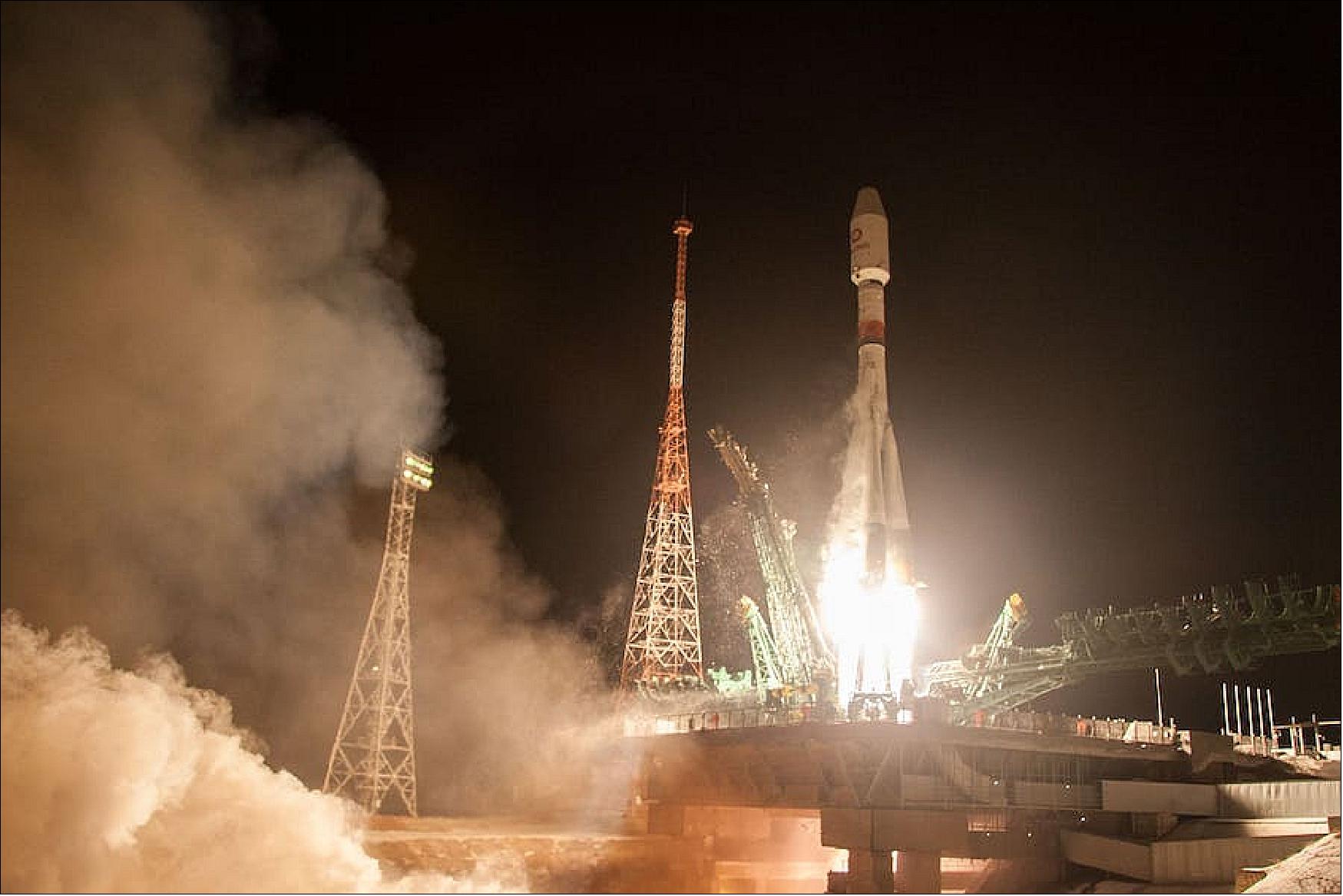
The main engine of the Fregat upper stage ignited two times to place the 34 OneWeb satellites into a targeted polar orbit roughly 450 km above Earth, with an inclination of 87.4º to the equator. — From there, each satellite will use onboard electric propulsion to climb to their 1,200 km operational orbit.
Then began a series of deployments to release the 34 OneWeb satellites from a composite dispenser, or connecting interface, made by RUAG Space in Sweden.
First, two of the 147.5 kg satellites separated from the top of the cluster. The remaining 32 spacecraft separated in groups of four at intervals of approximately 20 minutes, with maneuvers by the Fregat’s smaller attitude control thrusters in between to ensure the satellites did not collide.
The satellite separation events largely occurred when the Fregat was outside the range of ground tracking stations. Officials from OneWeb and Arianespace — which arranged Thursday’s launch under contract to OneWeb — updated the status of the deployment sequence as they received data from the Fregat upper stage.
The last group of OneWeb satellites flew off the Fregat’s dispenser around 3 hours, 45 minutes into the mission. About an hour later, officials received telemetry data confirming the deployment of all 34 satellites.
Within around 10 hours of launch, ground teams at OneWeb’s satellite operations center received signals from 30 of the 34 satellites. Officials expected to hear from the other four satellites Friday.
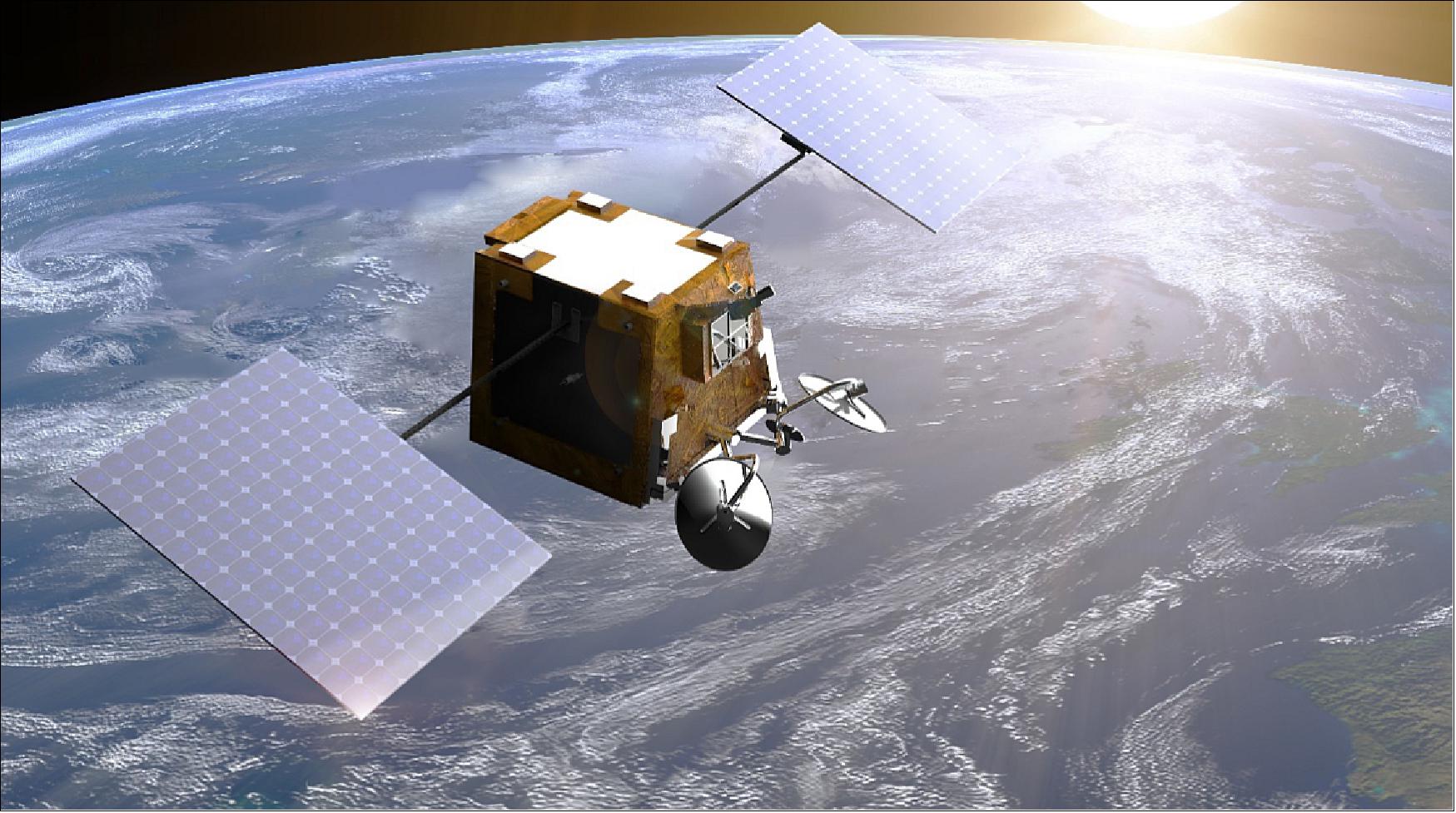
Customer | OneWeb |
Manufacturer | OneWeb Satellites (Florida factory) |
Mission | Telecommunications |
Operational Orbit of constellation | LEO at 1200 km altitude and 87.4º inclination |
Launch mass of 34 satellites | 5,015 kg (147.5 kg for each satellite) |
Propulsion | Plasmic propulsion system |
Battery | Li-ion |
Antennas | Two TTC omni antennas ; two Ku-band antennas ; two Ka-band antennas |
Stabilization scheme | 3-axis stabilized |
Coverage | Global |
Table 3: OneWeb satellites 108)
Launch 1: ArianeSpace launched the first six OneWeb satellites on 27 February 2019 (21:37 GMT) on a Soyuz-ST vehicle (named VS21) with the Fregat-MT upper stage from Kourou, French Guiana. 109) 110)
The workhorse medium-lift Soyuz vehicle delivered its payload during a flight lasting 1 hour and 22 minutes. Total payload lift performance was estimated at 1,945.2 kg. By operating this maiden flight, the first of 21 launches contracted by OneWeb in 2015, Arianespace contributes to the fulfilment of its customer's ultimate ambition: providing Internet access to everyone, everywhere.
Arianespace CEO Stéphane Israël congratulated OneWeb in his post-launch comments from the Spaceport and underscored the importance of today’s Soyuz success for both companies: “This initial mission makes our ambitious partnership – built around the launch of more than 600 OneWeb satellites – a reality.”
The initial constellation will be compromised of approximately 650 satellites and will scale to more than 900 spacecraft as it grows to meet demand around the world. OneWeb signed a contract with Arianespace in 2015 for a total of 21 Soyuz flights from three launch bases (the Spaceport in French Guiana; Baikonur Cosmodrome in Kazakhstan and Vostochny in Russia), to be performed through 2020.
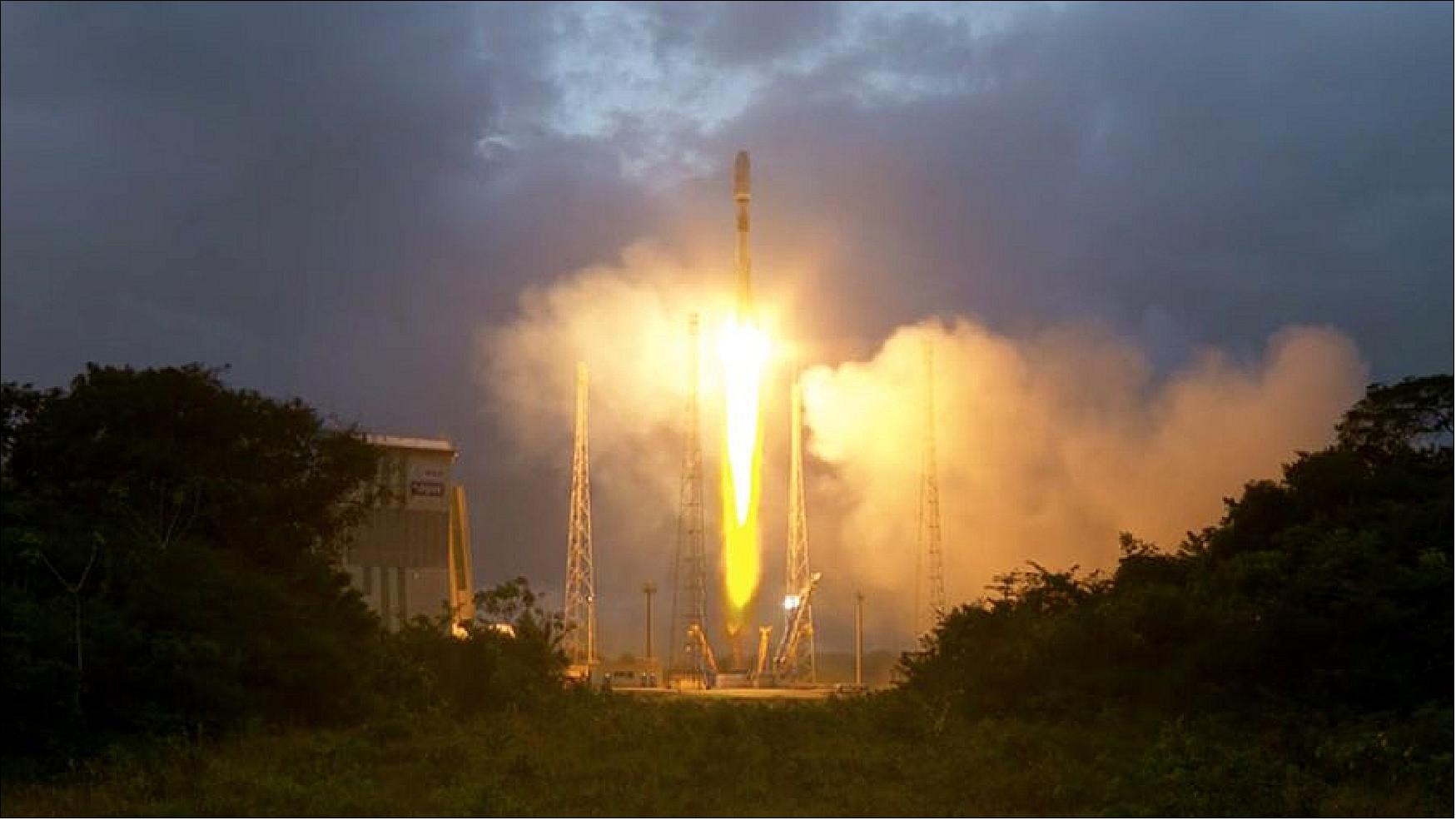
Orbit: Near-polar LEO (Low Earth Orbit), altitude of 1200 km.
Launch Campaign: Largest Commercial Launch Acquisition in History
• 21 launches provided by Arianespace using Soyuz
- Baikonur and french Guiana launch sites
- 32 satellites per launch
- 3-4 week of launch cadence
• 39 launches provided by Virgin Galactic
- Air launched over the Pacific
- 1-2 satellites per launch.
Orbit of constellation: Operational altitude of 1200 km, inclination of 87.9º, 18 orbital planes of 36 satellites each.
Mission Phases
1) Launch and deployment:
• 450-475 km insertion altitude. This altitude is above the ISS and below many high-value assets
• Soyuz launch in bulk (~30 per LV)
• Virgin Galactic fills in gaps (1-2 per LV)
2) Orbit raising maneuvers:
• Low-thrust Hall effect ion engine
• Spiral climb-out to 1200 km. This operational altitude is above high-density regions of space debris.
• Conjunctions managed by pausing thrust
3) Operations:
• Operational altitude selected in part by low density of space objects
• Stationkeeping driven by payload requirements as well as management of plane crossings
4) Disposal:
• Initial extraction from operational constellation to 1100 km circular orbit
• Perigee lowered to under 250 km for rapid atmospheric reentry
• Disposal system is required to be the highest reliability function on the satellite
• Atmospheric reentry within five years of decommissioning.
LEO (Low Earth Orbit) debris environment:
The most congested region in LEO is between 760 km and 860 km as illustrated in Figure 44.
• There are about 17,500 objects cataloged by the US Space Surveillance Network
• In general, the tracking limit of space debris in LEO is ~10 cm in diameter
• Estimates of the untrackable population are given by flux models [e.g., NASA's ORDEM (Orbital Debris Engineering Model)].
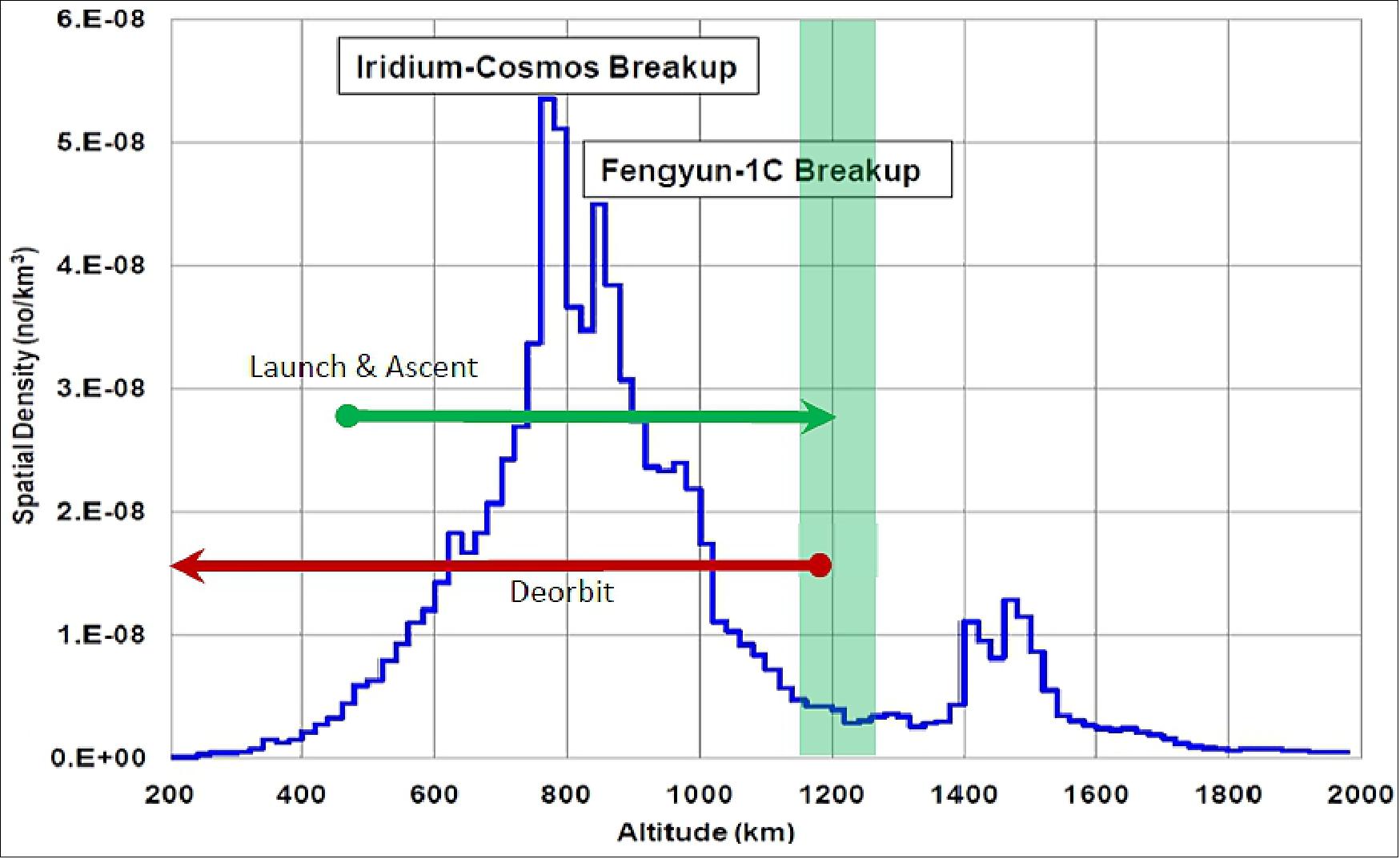
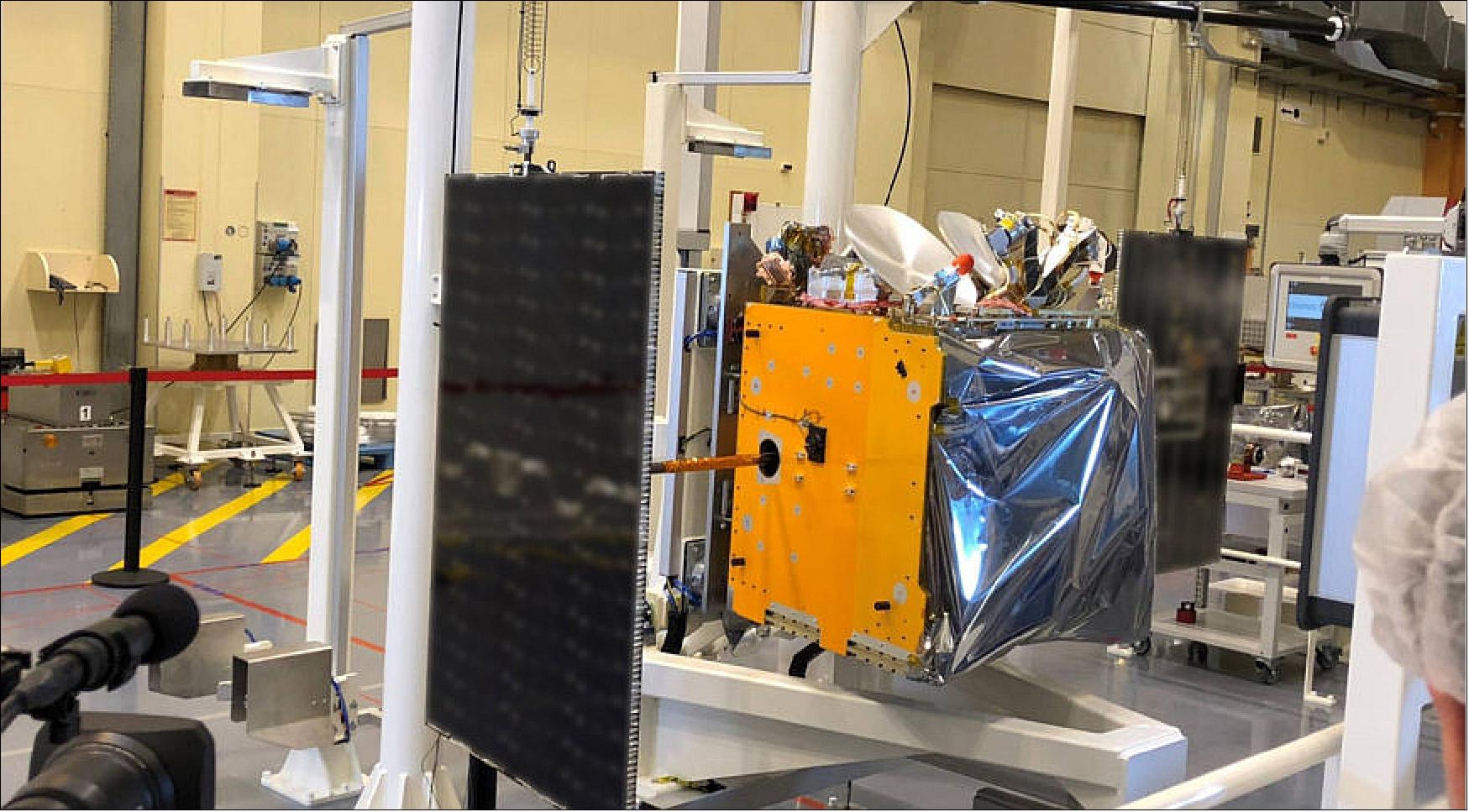
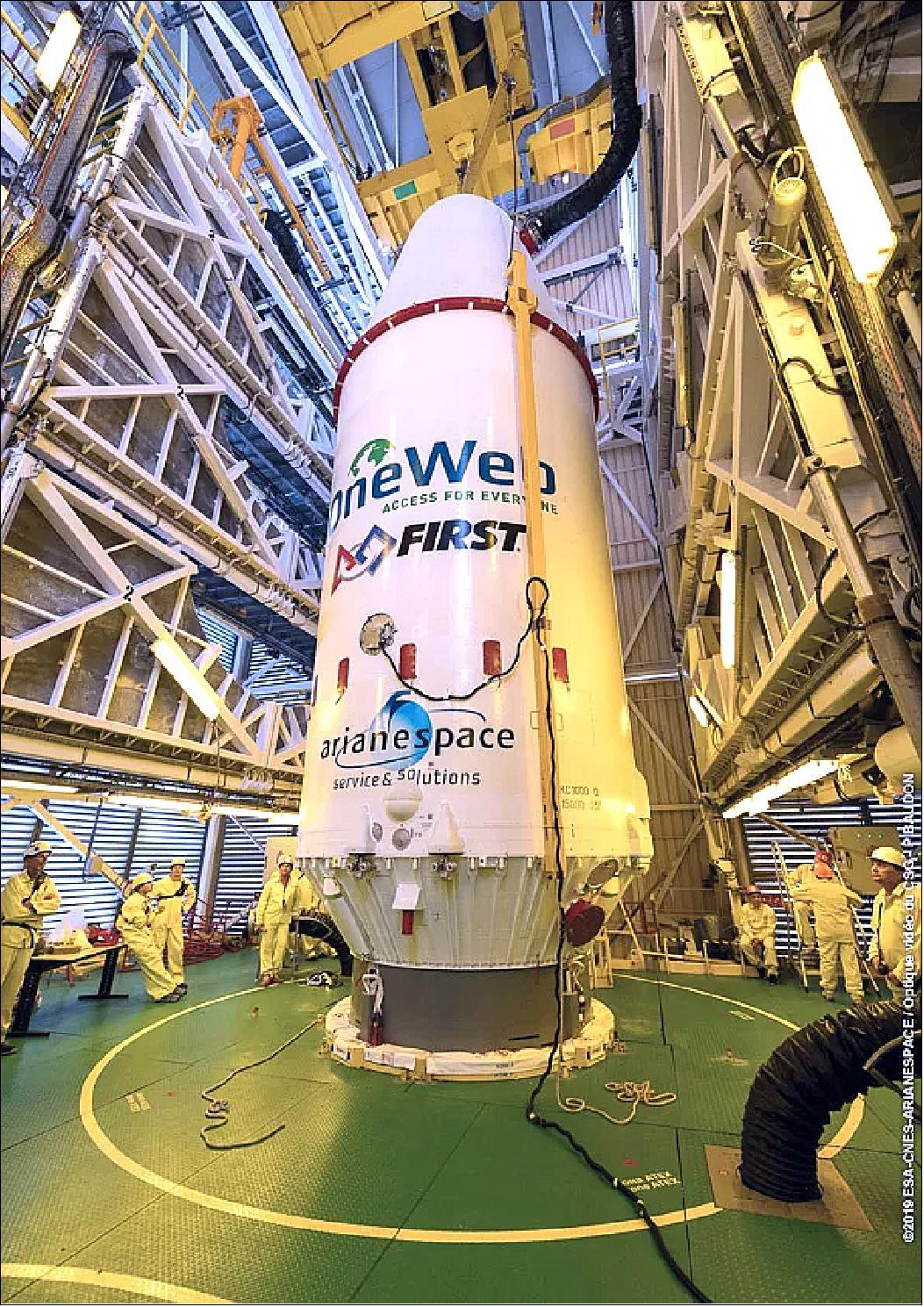
Mission Status
• June 23, 2022: U.S. troops at Thule Air Base, Greenland, a remote military outpost well outside the footprint of a typical geostationary satellite, are getting high-speed internet from OneWeb’s polar-orbiting constellation. 111)
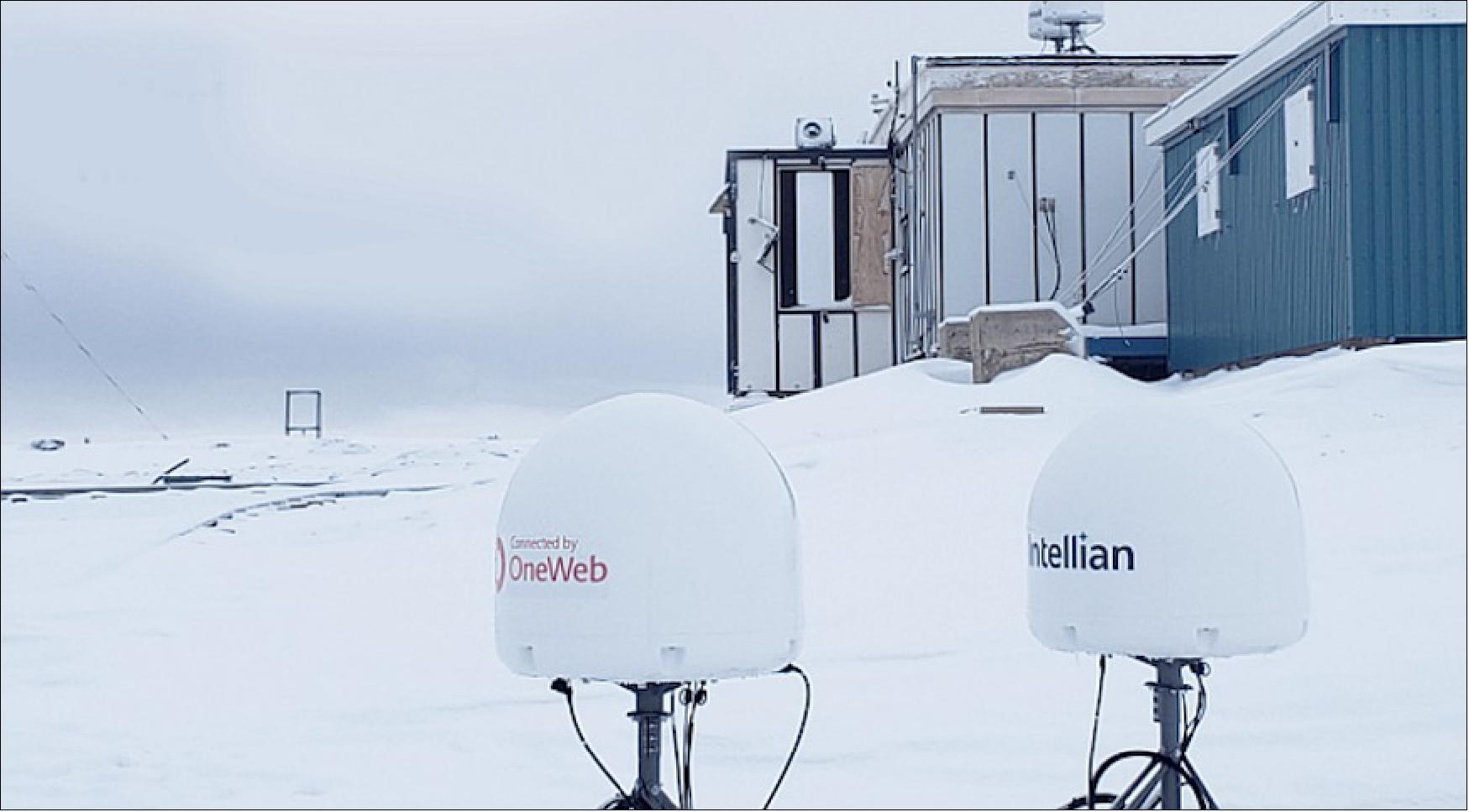
- Hughes Network Systems and OneWeb announced June 22 that they have successfully deployed a prototype low Earth orbit network at Thule, fast enough to enable video conferencing, streaming video and interactive games.
- The network supports about 600 service members living at the base. One recent evening, about 100 military personnel at Thule “were online simultaneously, consuming close to a terabyte of connectivity,” Hughes said in a news release.
- Thule Air Base is home to U.S. military units that conduct missile warning, space tracking, and satellite command-and-control operations. The Hughes-OneWeb demonstration is significant as high-speed internet connectivity in the Arctic region is hard to come by. For decades, Iridium Communications has been the only operator able to provide continuous coverage over the poles — and only for less bandwidth-hungry services such as mobile telephony and various monitoring and tracking applications.
- Hughes and OneWeb are working under a $3.4 million contract from the Air Force Research Laboratory. AFRL oversees the U.S. Air Force’s Defense Experimentation Using the Commercial Space Internet (DEUCSI) program. Hughes, the prime contractor on the Thule project, is a OneWeb investor and is supplying portions of the ground segment.
- Built in the 1950s, Thule is the northernmost U.S. military installation, located less than 1,000 miles from the North Pole.
- “The testing has demonstrated the ability of emerging LEO networks to dramatically improve communications to areas that have traditionally been extremely difficult to serve,” said AFRL program manager Brian Beal. “The residents at Thule have been thrilled with both the performance and stability of the network as they’ve used it to connect with family, friends, and colleagues around the world.”
- Hughes said the Thule LEO network includes four antennas connecting with the OneWeb satellites that orbit overhead, delivering about 14 terabytes of data per month.
Unique partnership showcases transport diversification between GEO(Geosynchronous Earth Orbit) and LEO(Low Earth Orbit) constellations: 112)
• November 4, 2021: OneWeb Technologies (OWT) of Houston TX, the US Proxy organization for OneWeb, a global provider of innovative, secure satellite communications, Intelsat, operator of the world’s largest integrated satellite and terrestrial network, and Linchpin Solutions, a leader in C5ISR (Command, Control, Communications, Computers, Combat Systems, Intelligence, Surveillance, and Reconnaissance) systems and programs, successfully demonstrated a multi-orbit satellite communications solution for representatives of the U.S. Army and Department of Defense (DoD).
- This is a strategic demonstration to the U.S. DoD that shows transport diversification between the geostationary orbit (GEO) and low Earth orbit (LEO) constellations with seamless switching between them.
- Referred to as Automated Primary, Alternate, Contingency, and Emergency (APACE) communications, the solution enables soldiers to survive and excel in contested electronic warfare environments. The reliability of communications is significantly improved by simultaneously sending data over multiple paths and adjusting the traffic flow in real-time between GEO and LEO satellite constellations.
- OWT and Intelsat used both GEO and LEO services simultaneously, switching the data flow between orbits instantly at the packet level, using software to determine which connection will provide the best experience based on the technical requirements of the end service. The software solution can be hosted on existing fielded ruggedized virtual machine platforms allowing the system to run in the harshest environments.
- Two satellite links were established during the demo – one on the Intelsat 37 (IS-37) satellite and one on a OneWeb satellite. The links communicated through various end-user terminals, including a SatCube terminal, a Kymeta U7/8 terminal, a Litecom. GEO terminal, and a OneWeb Intellian terminal, demonstrating applications such as two-way voice and data downloads and MP4 video.
- “This demonstration of low latency, high-capacity throughput via a multi-orbit solution that increases the resiliency of commercial Satcom to DoD and allied partners globally is an important steppingstone as OneWeb rises to the challenges and needs of our customers through partnerships,” said Bob Roe, CEO of OneWeb Technologies, the U.S. Proxy subsidiary of OneWeb.
- “This demonstration shows how through the power of partnership, we can provide a reliable, secure, multi-orbit, multi-band capability for the military that connects our warfighters to meet their evolving mission requirements,” said President of Intelsat General, Dave Micha. “This enables the delivery of required connectivity, throughput and services to customers when and where that reliable access is needed, even in the harshest elements.”
- OneWeb Technologies is the Government Services subsidiary of OneWeb tasked with providing Five Eyes; NATO; the UN and other strategic partners with next-generation, satellite-based connectivity anywhere in the World, at anytime.
- OWT’s global constellation of Low Earth Orbit (LEO) satellites, supported by an ecosystem of ground gateways; multi-domain antennas; and software solutions, provides customers with secure, classified and resilient multi-domain connectivity, including positioning, navigation and timing (PNT); co-hosted payloads; and communications on-the-move.
- Intelsat’s FlexMove service, combined with partner terminals, can be deployed within an hour. For military customers, this quick set-up, reliable and secure offering provides beyond-line-of-sight (BLOS) seamless communications at times when connectivity is most critical.
- Intelsat is the world’s most trusted integrated space and ground satellite network with a 50-year record of delivering seamless and secure coverage across 200+ countries. We are building a unified global 5G network that will support virtually any access technology, enabling the next generation of global mobility, IoT, and 5G services. Merging software-defined technology and multiple networks and orbits, we bring the world a single, more powerful way to connect easily.
• June 27, 2021: OneWeb, the global communications network powered from Space, and BT (BT.L), one of the world’s leading communication services companies, today announced they have signed a Memorandum of Understanding (MoU), to explore the provision of improved digital communication services to some of the hardest to reach parts of the UK. The groundbreaking agreement between OneWeb and BT (British Telecom) comes as investment in expanding modern, digital infrastructure remains a top priority for the UK’s economic recovery and development post-COVID. 113)
- OneWeb’s network has a unique capability to serve hard to reach communities and the work with BT will focus on how satellite technology might support improved capacity, mobile resilience, backhaul and coverage, including Fixed Wireless Access, in challenging geographic locations, as BT explores new options to enhance rural connectivity. As part of the discussions, the companies will consider opportunities to deliver OneWeb’s connectivity services from low Earth orbit to businesses and communities around the UK, as well as identifying collaboration opportunities to develop new services beyond UK’s shores for BT’s global customers.
- OneWeb continues to execute the deployment of its network at pace and is seeing increasing demand from customers. The company has announced recent distribution partner signings across multiple industries and territories above the 50th Parallel with communication companies including the AST Group, PDI, and ACS, among others. Today’s MoU announcement further demonstrates OneWeb’s execution momentum, and the confidence customers have in its services and offering.
- OneWeb’s Chief Executive Officer, Neil Masterson, said: “This partnership is a huge sign of progress in the resilience and advancement of the overall telecom infrastructure in the UK. OneWeb’s network will be a vital means for bridging the last digital divides across the network and we are excited to be part of the solution with BT to expand the nation’s digital infrastructure.”
- Philip Jansen, Chief Executive, BT, said: “Our ambitious full fibre and mobile commitments have put BT at the forefront of efforts to expand digital connectivity across the UK. It is clear that greater partnership is needed, both with Government and within industry, to ensure connectivity can reach every last corner of the country. Our agreement with OneWeb is an important step to understanding how that goal could be achieved in the future.”
- Digital Infrastructure Minister, Matt Warman, added: “No one should miss out on the benefits of better broadband and mobile coverage. It is great that BT and OneWeb are working together to explore new ways to bring faster and more reliable connectivity to the hardest to reach homes. Alongside industry we have kicked off the biggest broadband build in British history and are spending a record £5.5 billion to end poor or patchy 4G coverage and deliver gigabit speeds in all corners of the UK.”
- British Telecommunications plc is a wholly owned subsidiary of BT Group plc and encompasses virtually all businesses and assets of the BT Group.
• May 13, 2021: Japanese internet giant SoftBank has agreed an alliance with OneWeb to expand its low Earth orbit (LEO) broadband services in Japan and worldwide. 114)
- The collaboration with SoftBank, which has invested in OneWeb, is an important step toward getting regulatory approvals and setting up ground stations in Japan for the startup’s growing constellation.
- SoftBank owns stakes in technology, energy and financial companies worldwide, and also operates a telecoms business in Japan where it serves more than 45 million mobile consumer and enterprise subscribers.
- OneWeb said their alliance will promote their combined communications services, including platforms SoftBank is building to digitize company operations.
- SoftBank posted net income equivalent to nearly $46 billion for its fiscal year ending March 31, a record for a Japanese listed company.
- Successful bets in the company’s $100 billion Vision Fund and its successor boosted these figures, including gains from South Korean e-commerce company Coupang and food-delivery service DoorDash when they listed on public markets.
- The results will grow investor confidence in SoftBank founder Masa Son, who often speaks about investing for a future when ubiquitous connectivity meets “singularity,” when machines can outthink humans.
- Son blamed COVID-19 after SoftBank reported its first annual loss in 15 years in 2020, an operating loss of 1.36 trillion yen ($12.7 billion).
- The Japanese company was an early investor in OneWeb. At one point it tried to engineer a merger between the startup and established satellite fleet operator Intelsat, which operates spacecraft in geostationary orbit (GEO).
- Holders of Intelsat’s debt shot down that deal in 2017.
- Struggling under nearly $15 billion of debt as the COVID-19 pandemic worsened, Intelsat entered bankruptcy protection in May 2020 in a process it is still working through a year later.
- COVID-19 also pushed OneWeb into bankruptcy in March 2020.
- After the British government and Indian telecom company Bharti Global rescued OneWeb from Chapter 11 in November, SoftBank returned with a $350 million capital infusion. Hughes Network Systems, which is developing parts of OneWeb’s ground segment, invested $50 million.
- On April 27, French satellite operator Eutelsat paid $550 million to buy 24% of OneWeb.
- OneWeb expects to raise the rest of the money it needs to complete its constellation, estimated to be around $500 million, later in 2021.
- It has already launched more than a third of its 648 LEO satellite fleet, ahead of its goal to launch partial services before the end of this year, and globally in 2022.
- As part of plans to create a new government subsidiary for selling its services, OneWeb said May 10 it will buy Texas-based managed satcoms provider TrustComm for an undisclosed sum.
- The acquisition comes after OneWeb, which expects the Department of Defense will be its largest customer, secured a demo contract with the U.S. Air Force Research Laboratory (AFRL) for strategic Arctic locations. Hughes is the prime contractor for that contract.
• October 23, 2019: OneWeb, a global communications company with a mission to connect everyone everywhere, is presenting three papers at the 2019 International Astronautical Congress (IAC) this week, focused on analyses and recommendations for the protection of the future of Space. These papers represent the continuation of OneWeb’s pledge to champion an industry-wide culture of shared education, coalition-building, awareness-raising and research into Space environmental issues via its Responsible Space program. 115)
- OneWeb’s Responsible Space commitments are designed to build on, and strengthen the work already being done within the Space community. The research and papers provide a framework for responsible practices for the wider industry, other partners, and policymakers. OneWeb’s aim with these papers is to share our learnings and expertise; to invite additional coordination, collaboration, and to build shared responsibility for us all, to ensure the future of Space.
- The papers, co-authored by OneWeb’s Director of Mission Systems Engineering, Tim Maclay, and other respective experts, provide an analysis of three key elements in protecting space as a shared resource.
1) Long-Term Environmental Effects of Deploying the OneWeb Satellite Constellation. 116)
This study confirms the benefits of OneWeb’s design choices in relation to potential environmental effects. Led by Dr. Hugh Lewis (debris modeling expert) at the University of Southampton, UK, the analysis demonstrates that separating planes within a constellation result in: high post-mission deorbit reliability and short deorbit times, both of which significantly reduce the environmental impact of deploying large constellations.
2) Responsible Satellite Design and Operational Practices: A Critical Component of Effective Space Environment Management (SEM) 117)
Co-authored with Iridium and Maxar, this joint position paper proposes a comprehensive set of responsible design and operational practices to ensure the long-term sustainability of the Low Earth Orbit (LEO) environment. These recommendations contribute to an industry-wide discussion on the Space environment challenges posed by the rapid increase in commercial launch activity in recent years and proposes updates to long-standing (and outdated) debris mitigation guidelines.
3) Space Environment Management: Framing the Objective and Setting Priorities for Controlling Orbital Debris Risk. 118)
This paper discusses the need for Space Environment Management (SEM) as an important element of assuring safe satellite operations in LEO. While characterizing the environment and actively avoiding collisions (Space Traffic Management) are necessary to assure safe operations, these activities alone are not sufficient. The paper makes the case that managing the environment is equally critical if we are to achieve sustainable operations in the long term. Debris Mitigation and Debris Remediation: not generating more debris and cleaning up large, derelict objects already circling the globe, are key elements of Space Environment Management (SEM).
“Since OneWeb launched its Responsible Space initiative in June, we have been heartened by the support and offers of collaboration from across the industry. We are taking our work to the next level by actively investing in the academic, technical and practical space protection agenda,” said Tim Maclay, Director of Mission Systems Engineering. “Taking a leadership position on this topic is about collaborating to make sure future generations can benefit from the New Space ecosystem and taking necessary actions to maintain a sustainable environment to achieve this aim.”
4) New Satellite Technologies to Provide the Geographic Ubiquity Needed to Connect the Globe, Benefitting the SDGs, 5G, and the Digital Divide. 119)
Half of the world’s people still have no internet access. Half of the world’s people lack the connectivity that has, without a doubt, become essential to education, knowledge-gathering, and the fundamental goals of every government, all because of where they live. Whether the area be remote or riddled with treacherous terrain, connecting many of these individuals has not been feasible. However, advancement in satellite technologies will be able to provide the geographic ubiquity needed to connect the globe and provide that foundational backbone to societal connectivity. Made possible through newly-launched non-geostationary satellite constellations, this connectivity has far more implications in development than just email and entertainment: these constellations will aid in the achievement of every single one of the United Nation’s SDGs (Sustainable Development Goals); they will enable 5G implementation even outside of highly-populated areas; and perhaps most importantly, close the digital divide.
• September 4, 2019: OneWeb, whose goal is to connect everyone everywhere, today announced the details of its Arctic high-speed, low-latency internet service. OneWeb will deliver 375 Gbit/s of capacity above the 60th parallel North. With service starting in 2020, there will be enough capacity to give fiber-like connectivity to hundreds of thousands of homes, planes, and boats, connecting millions across the Arctic. 120)
- The dense, flexible coverage of OneWeb’s polar-orbiting satellites coupled with its high-speed service and low latency capabilities will provide a superior connectivity experience to the 48% of the Arctic currently without broadband coverage. In fact, OneWeb most recently proved its system’s capabilities through HD video streaming tests last month with its first six satellites that showcased extreme low latencies under 40 milliseconds and high speed services.
- A global network, OneWeb’s Arctic service will be deployed significantly earlier and provide 200 times more capacity than planned systems. Substantial services will start towards the end of 2020, with full 24-hour coverage being provided by early 2021, supplying unprecedented blanket coverage to every part of the Arctic Circle.
- “Connectivity is critical in our modern economy,” said U.S. Senator for Alaska Lisa Murkowski. “As the Arctic opens, ensuring the people of the Arctic have access to affordable and reliable broadband will make development safer, more sustainable and create new opportunities for the next generation leading in this dynamic region of the globe.”
- Adrian Steckel, OneWeb Chief Executive Officer, said: “Connectivity is now an essential utility and a basic human right. Our constellation will offer universal high-speed Arctic coverage sooner than any other proposed system meeting the need for widespread connectivity across the Arctic.”
- Home to millions of people, the Arctic is a growing economic hub for many important industries. OneWeb’s seamless global network will facilitate smart shipping, connected aviation, the collection of climate data, and the growth of a digital economy across the region.
• August 11, 2019: OneWeb has succeeded in bringing into use the company's spectrum rights in the Ku- and Ka-band spectrum. 121) 122)
- To achieve this milestone, OneWeb’s satellites have been transmitting at the designated frequencies in the correct orbit for more than 90 days, enabling OneWeb to meet the requirements to secure spectrum bands over which it has priority rights under ITU rules and regulations. These rights will now be confirmed as the UK administration, which has filed our satellite system with the ITU, will complete the required Notification and Registration process of the company’s LEO network.
- By meeting the requirements of the ITU regulations, OneWeb is well on its way to securing spectrum rights to high priority Ku-band spectrum for service links, and Ka-band for its global gateways. It will now have access to over 6 GHz of spectrum that will enable it to deliver its high-speed, low latency connectivity.
- This achievement is the latest in a string of major milestones charting OneWeb’s progress toward commercial service and full global coverage by 2021, including the successful launch of its first six satellites in February, the opening of its state-of-the-art Florida manufacturing facility earlier this month, and proving its ability to deliver low latency, high-speed services through its recent full HD streaming tests.
- During the remainder of 2019, OneWeb will focus on commencing its monthly launch program of more than 30 satellites per month, building an initial constellation of 650 satellites on its way to 1,980 satellites. The first phase of the constellation will provide global coverage; and further additions to the network will be focused on adding capacity to meet growing customer demands.
- Sustainability is a core OneWeb’s commitment to bridge the digital divide. In June 2019, OneWeb reaffirmed its promise to leave no trace in space with its Responsible Space commitments based on the premise that Space is a shared natural resource, which if used responsibly, can help transform the way we live, work, and connect.
- Ruth Pritchard-Kelly, VP of Regulatory for OneWeb, said spectrum is a scarce resource and the ITU plays a vital role in the global management for access. The harsh reality for anyone trying to make a real impact on global connectivity is that no matter how good your network is, success is not possible without the correct spectrum. With the company's spectrum now in use, OneWeb has proved it can bring together all the elements required — in space, on the ground, and in between — to change the face of connectivity everywhere.
• July 16, 2019: OneWeb, whose mission is to enable internet access everywhere for everyone, is delighted to announce the successful test of its six satellites in Low Earth Orbit. All satellites delivered high-speed, low-latency services, with speed of more than 400 Mbit/s which enabled the fastest realtime video streaming in Full HD from Space. The tests, which took place in Seoul, South Korea, represent the most significant demonstration of the OneWeb constellation to date, proving its ability to provide superior broadband connectivity anywhere on the planet. 123)
- OneWeb’s satellites are performing well, enabling the company to continue its path forward towards a fully functioning global constellation in 2021 and delivering partial service beginning as early as 2020. OneWeb’s service will broaden and innovate the use cases of satellite connectivity and will represent an important step towards enabling quality access everywhere for everyone.
- OneWeb is aggressively moving forward on the implementation of its first phase of the network which will start with an initial 650 satellites and grow up to 1,980 satellites. This first phase of the constellation will provide global coverage; and further additions to the network will be focused on adding capacity to meet growing customer demands.
- The recent satellite tests were conducted in partnership with Intellian, the developer and manufacturer of OneWeb user terminals and SatixFy, developer and manufacturer of the 125 MHz SCPC test modem. The tests included: latency, speed, jitter, seamless handover between satellites and power control. During its test, OneWeb demonstrated:
a) Extremely low latency with an average of 32 milliseconds;
b) Seamless beam and satellite handovers;
c) Accurate antenna pointing and tracking;
e) Live streamed video at resolutions up to 1080p (Full HD); and
g) Test speed rates of more than 400 Mbit/s.
- From realtime gaming to Facetime, streaming HD movies to operating Google maps on the move to using cloud software, OneWeb’s service opens up a raft of new applications which are needed to meet the connectivity needs of today and tomorrow. These initial tests are only the beginning and OneWeb will continue testing as it prepares for its next launch later this year.
- “Our tests prove that OneWeb will enable very high speed and low latency connectivity everywhere and we are on schedule to offer the service globally in 24 months. OneWeb is going to transform the way we think about connectivity and how we use it.” said Adrian Steckel, CEO of OneWeb.
- “This demonstration in Seoul shows the strength that OneWeb and Intellian have together to provide global coverage. The technology in the Intellian user terminals connecting with OneWeb satellites shows our capabilities for now and for the future. We will succeed on this mission with OneWeb,” said Eric Sung, CEO of Intellian.
About Intellian Technologies, Inc.
Intellian is the global leader of mobile satellite communication systems for maritime, government, military and NGSO (Non-Geostationary-Satellite Orbit) sectors. Founded in 2004, Intellian is leading the way in driving innovation in the satellite communications market. The industry’s top-ranking companies choose Intellian’s maritime satellite antenna systems to deliver connectivity when it matters most. Intellian operates in 12 offices worldwide, including global logistics centers in Asia, the Americas, and Europe, and is supported by a network of more than 550 partners across the globe.
• May 7, 2019: OneWeb has announced a partnership with Intellian Technologies Inc., a global communications company with HQs in Seoul Korea, to build user terminals designed specifically for remote enterprise networks, cellular backhaul expansion and remote connectivity needs. 124) 125)
- The user terminals will be the units provided to customers to enable the high-speed, low latency service that our global satellite constellation will deliver. These user terminals will be perfect for a range of use cases including connecting businesses in rural areas, schools, hospitals, farms and community centers.
- This partnership represents a significant step-forward in the development of OneWeb’s system following the launch of its first satellites and its first customer announcements in February 2019. With six satellites now on-orbit and a range of antennas now in place, OneWeb is ready to advance the development of its portfolio of user terminals, ranging from compact flat panels to highly-efficient dual parabolics. All our user terminals will be designed to serve a range of customer needs, market verticals and use cases.
- With many remote and unconnected areas around the world still lacking access to broadband, these user terminals will help to close to gaps and connect remote enterprises, as well as, expand cellular backhaul capacity which is essential for extending connectivity. The terminals will utilize dual-parabolic antennas to deliver cost-effective and efficient throughput making high-speed and low-latency services available in hard-to-reach areas and helping bridge the digital divide. OneWeb expects these terminals to be available for Commercial use in 2020.
- Adrian Steckel, CEO of OneWeb, said this is an exciting moment for OneWeb as the company expands and develops the firm's own user terminals with an extremely important partner. The company's user terminals will always be designed with customer needs in-mind, ensuring a service is delivered they can trust.
- Eric Sung, CEO of Intellian, noted that the company is thrilled that the firm's design and manufacturing capabilities will help connect people in remote locations to this new satellite ecosystem.
• March 18, 2019: OneWeb announced it has secured its largest fundraising round to date with the successful raise of $1.25 billion in new capital. This brings the total funds raised to $3.4 billion. This round was led by SoftBank Group Corp., Grupo Salinas, Qualcomm Technologies Inc., and the Government of Rwanda. 126)
- The new funds, following the successful first launch of OneWeb’s satellites, enable the company to accelerate the development of the first truly global communications network by 2021. OneWeb’s system will deliver high speed, low latency, seamless broadband access, everywhere on Earth.
- "This latest funding round, our largest to date, makes OneWeb’s service inevitable and is a vote of confidence from our core investor base in our business model and the OneWeb value proposition," said Adrian Steckel, CEO of OneWeb. "With the recent successful launch of our first six satellites, near-completion of our innovative satellite manufacturing facility with our partner Airbus, progress towards fully securing our ITU priority spectrum position, and the signing of our first customer contracts, OneWeb is moving from the planning and development stage to deployment of our full constellation. Our success is made possible thanks to the backing of our investors and the cooperation of our world class commercial partners including Arianespace, Airbus, Qualcomm Technologies Inc., Virgin, and Hughes.”
- OneWeb’s satellites, produced through its joint venture with Airbus doing business as “OneWeb Satellites”, will ramp-up production this spring at its new, state-of-the-art manufacturing facility in Exploration Park, Florida. Following the company’s successful launch of satellites on 27 February, OneWeb will embark on the largest satellite launch campaign in history. Starting in Q4, OneWeb will begin monthly launches of more than 30 satellites at a time, creating an initial constellation of 650 satellites to enable full global coverage. After this first phase, OneWeb will add more satellites to its constellation to meet growing demands.
- On the additional investment, Marcelo Claure, COO of SoftBank Group Corp. and CEO of SoftBank Group International said: “OneWeb has extended its first-mover advantage and is on track to become the world’s largest and first truly global communications network. At SoftBank, our aim is to invest in transformative companies at the leading edge of technology disruption. OneWeb’s potential is undeniable as the growth in data from 5G, IoT, autonomous driving and other new technologies drives demand for capacity above and beyond the limits of the existing infrastructure.”
- OneWeb’s priority rights to a large block of globally harmonized spectrum and its Low Earth Orbit (LEO) constellation design will enable a unique combination of high speed, low latency, and truly global service. OneWeb’s network will go beyond the limits of existing infrastructure, enabling connectivity for rural communities and schools as well as for business and industries that demand seamless global connectivity solutions such as Aviation, Maritime, Backhaul, and Land Mobility. OneWeb’s customers will be able to develop and support a wide range of emerging applications that require real-time communication and collaboration.
- “I have worked for over 20 years to bring network access to people throughout Mexico and Latin America and have seen first-hand the power of connectivity to change and improve lives. OneWeb will have the ability to reach places that have previously been impossible to connect. We are proud to be supporting Adrian and the entire OneWeb team and are looking forward to creating new opportunities for people everywhere,” said Ricardo Salinas, Founder and Chairman of Grupo Salinas.
- Greg Wyler, Chairman and Founder of OneWeb, added “We are committed to bridging the digital divide, and this funding helps ensure our globally shared dream will soon become a reality. We look forward to continuing our work with the many supportive and forward-looking Governments, ISPs(Internet Service Providers), and Telecom Operators to help them broaden the reach of connectivity to connect people everywhere.”
• March 5, 2019: The first six satellites of OneWeb's constellation were successfully launched on 27 February on a Soyuz rocket from the Kourou spaceport. These 6 satellites form part of a constellation to be made up initially by 648 low earth orbit (LEO) satellites, possibly building up to over 900 as needed to meet clients' growing needs. 127)
- OneWeb's constellation, the biggest broadband satellite system ever developed, will provide connectivity for billions of users around the whole world, taking communications networks to areas that would otherwise be unconnected. The system can give global 3G, LTE, 5G and Wifi access at affordable prices to users right around the world.
- This launch marks the transition from successful proof-of-concept to the commercialization of OneWeb "for everyone, everywhere", all in the interests of bridging the so-called digital divide. OneWeb has now struck out on the deployment of the biggest satellite constellation ever produced; from the end of this year it will regularly be launching about 30 satellites a month.
- To set an eyecatching example, OneWeb has undertaken to connect up 6 schools in formerly unconnected regions of the world: Alaska, Nepal, Honduras, Ecuador, Rwanda and Kyrgyzstan.
- GMV, undisputed number one in the supply of control centers for satellites of all types, will be helping to achieve all the above goals.
- In 2016 GMV won the contract for developing the command and control (C2) center of the whole constellation, thus taking on a great challenge.
- After weighing up diverse C2 platforms, OneWeb opted for GMV's product line, capable of meeting OneWeb's specific and complex needs while sticking to a tight development schedule. GMV's C2 system has been installed in the constellation's UK and USA operation centers and will be providing access to the command process and telemetry, automation of contacts between the satellites and ground antenna, as well as keeping track of the overall state of the constellation.
- GMV's command and control center includes different solutions from its inhouse real-time product line, such as hifly, for satellite monitoring and control; flyplan, for automation of contacts, and fleetDashboard, developed in collaboration with OneWeb's operations team, which provides global knowledge on the state of the constellation.
• February 27, 2019: Flight VS21 - Arianespace’s second launch of the year - took place on Wednesday, 27 February at 6:37 p.m., (Kourou time) from the Guiana Space Center (CSG), Europe’s spaceport in French Guiana (South America). 128)
- By operating this maiden flight, the first of 21 launches contracted by OneWeb in 2015, Arianespace contributes to the fulfilment of its customer’s ultimate ambition: providing Internet access to everyone, everywhere.
- The maiden mission for OneWeb brought the number of constellation satellites orbited by Arianespace to 109, which demonstrates a remarkable ability to meet the needs of this market segment with its current and future family of launchers.
- Stéphane Israël, Arianespace Chief Executive Officer, said: “By deploying the OneWeb constellation, Arianespace also accomplishes its mission: ‘Using space for a better life on Earth’ when participating in the build-up of a global communications network that will bridge the digital divide. The success of this first flight marks the go-ahead of 20 more Soyuz launches contracted by OneWeb in 2015, representing more than 600 satellites to be orbited in less than two years – and we take great pride in working toward such an objective!”
Ground Segment
• August 20, 2020: Indian telecommunications giant Bharti Enterprises is asking India’s space agency ISRO to help develop user terminals for OneWeb and to collaborate on providing broadband across the Indian continent. 129)
- Sunil Mittal, the billionaire chairman of Bharti Enterprises, said during an Aug. 20 webinar hosted by ISRO that OneWeb should start providing broadband early in 2022 from a constellation of low-Earth-orbit (LEO) satellites, and that plans are underway to build two or three gateway stations in India for domestic services.
- “OneWeb is going to be the world’s LEO satellite constellation flying about 648 satellites at 1,200 kilometers, covering every inch of the globe,” Mittal said.
- Bharti Enterprises and the British government are buying OneWeb out of bankruptcy protection. The buyers pledged in July to each invest $500 million to revive OneWeb, though neither indicated until now that the constellation would have the same number of satellites as planned before Chapter 11 proceedings.
- OneWeb has 74 satellites in orbit, and will need many more launches plus the rollout of several ground stations before it can provide global service. Prior to its March bankruptcy filing, OneWeb was targeting global service in 2021.
- Mittal didn’t say when launches would resume, but said the plan is for OneWeb to “start to deliver these services in the early part of ‘22 once the constellation is going to be up.”
- Test services will start in late 2021 once OneWeb’s coverage extends over arctic regions and down to northern European countries, Mittal said.
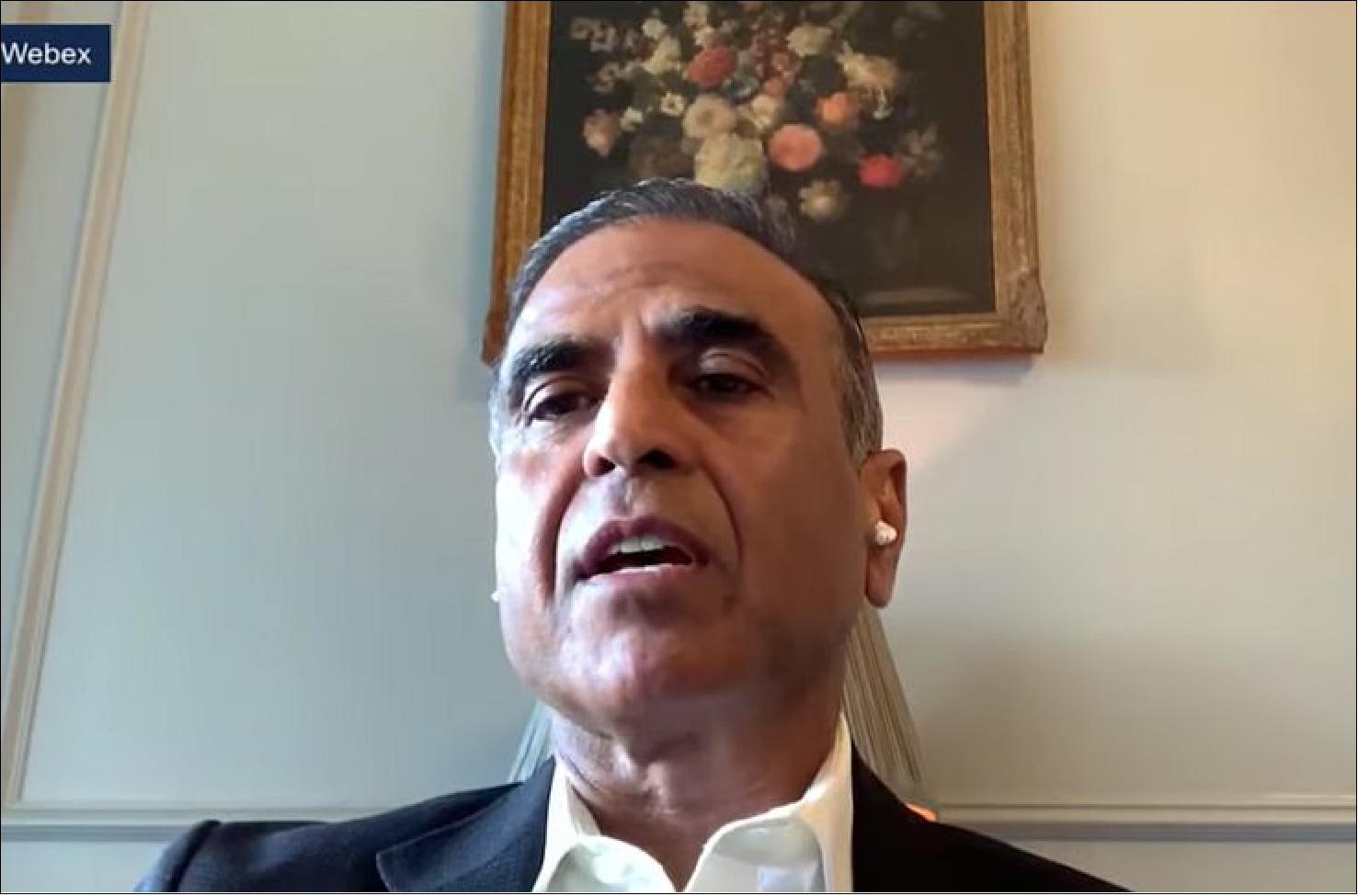
- With that coverage, “we will have started to test a lot of ground and user terminals,” Mittal said. “It is here we would like to see ISRO’s hand and support in work to develop user terminals which cater to the needs of Indian requirements.”
- The nonexistence of affordable user terminals for high-speed consumer broadband from LEO satellites is a significant concern for OneWeb and the satellite industry. Current user terminals that can work with LEO broadband satellites are either based on flat, phased-array antennas or mechanical tracking antennas with two dishes — both expensive approaches.
- Antenna challenges notwithstanding, Mittal said Bharti Enterprises has “already earmarked a lot of areas in India where the benefits of this LEO constellation broadband connectivity will be made available.”
- “We will also seek to build a very strong cooperation agreement with ISRO to see the combination of a GEO-LEO constellation for Indian territory is put to use where we can combine the strength and capacity requirements of the nation,” he added.
- ISRO provides satellite broadband across India through its fleet of domestically built GSAT geostationary satellites. The agency operates 15 geostationary communications satellites, according to the ISRO website, which provide broadband and broadcast services.
- Mittal said Bharti Enterprises has demonstrated less than 32 milliseconds of signal lag — around 20 times faster than geostationary satellites — using BMW cars linked to OneWeb satellites. He described the test results as a “game changer,” since latencies below 50 milliseconds feel akin to real time.
• March 9, 2020: Hughes Network Systems, LLC (HUGHES), the global leader in broadband satellite networks and services, and OneWeb, the global communications company with a mission to bring connectivity to everyone everywhere, today announced that Hughes has become a worldwide distribution partner for OneWeb. 130)
- OneWeb’s constellation of Low Earth Orbit (LEO) satellites will expand Hughes service offerings and ensure its customers can access low-latency, high-speed connectivity, wherever they are. Applications will include enterprise and government networking, cellular backhaul and community Wi-Fi hotspots.
- “We are entering a new era of global connectivity demand that can only be fulfilled by a mix of data transport services, including terrestrial, geostationary and Low Earth Orbit satellites,” said Pradman Kaul, president, Hughes. “OneWeb complements our service portfolio with a truly global coverage, low-latency option that will enable our customers to meet their end users’ needs for connectivity everywhere.”
- The new agreement expands an already successful relationship between the two companies. Hughes is an investor, through its parent company EchoStar, and an ecosystem partner to OneWeb, helping to develop essential ground network technology for OneWeb’s LEO system.
- OneWeb works with carefully selected distribution partners in each of its core markets, providing new business and expansion opportunities through the low latency, global, high throughput attributes of OneWeb’s network.
- “Connectivity is only truly valuable when it delivers the user experience that customers need, and in today’s fast-moving digital economy, businesses and civil government organizations need high quality, continuous internet access wherever they are,” said Adrian Steckel, CEO, OneWeb. “I’m delighted that Hughes is joining OneWeb on our mission to deliver this vision. Hughes is already an important investor and an invaluable technology partner, and I look forward to working together to bring OneWeb’s pioneering technology to markets around the world.”
- OneWeb is building its initial constellation of 650 LEO satellites. By late 2021, OneWeb will be offering low latency services globally, with the same capacity over the water, in the air, in previously unconnectable places, and everywhere else.
- Service testing on the satellites already in orbit is underway, using gateways that Hughes is building for the network. Results are positive, including seamless satellite and beam handovers, high speeds and low latency.
- The gateways feature multiple tracking antennas to support operation and handoff of high-speed user traffic to and from the LEO satellites, and can handle up to 10,000 terminal hand-offs per second – a technological and engineering breakthrough. Every OneWeb terminal, whether for fixed or mobile services, will incorporate a core module, including modem, developed and manufactured by Hughes.
• In November 2017, Hughes Network Systems LLC signed a contract with OneWeb for the production of a ground network system, supporting OneWeb’s constellation of LEO satellites. The contract includes production of the gateway sites each with multiple tracking satellite access points to support operation and hand-off of high-speed user traffic between satellites. 131) 132)
“Designing a ground system capable of supporting hundreds of LEOs with seamless handoff of broadband traffic between satellites presented a significant challenge,” said John Corrigan, senior vice president of Engineering for Hughes. “But our team was up to the task, and we are proud to be partnering with OneWeb on realizing this revolutionary satellite communications system to close the global digital divide.”
Joint development of the ground network system began approximately two years ago. The current agreement includes equipment to support multiple satellite access points in gateway locations around the world, each including a custom switching complex, outdoor modems, and power amplifiers. Shipments are expected to start in mid-2018.
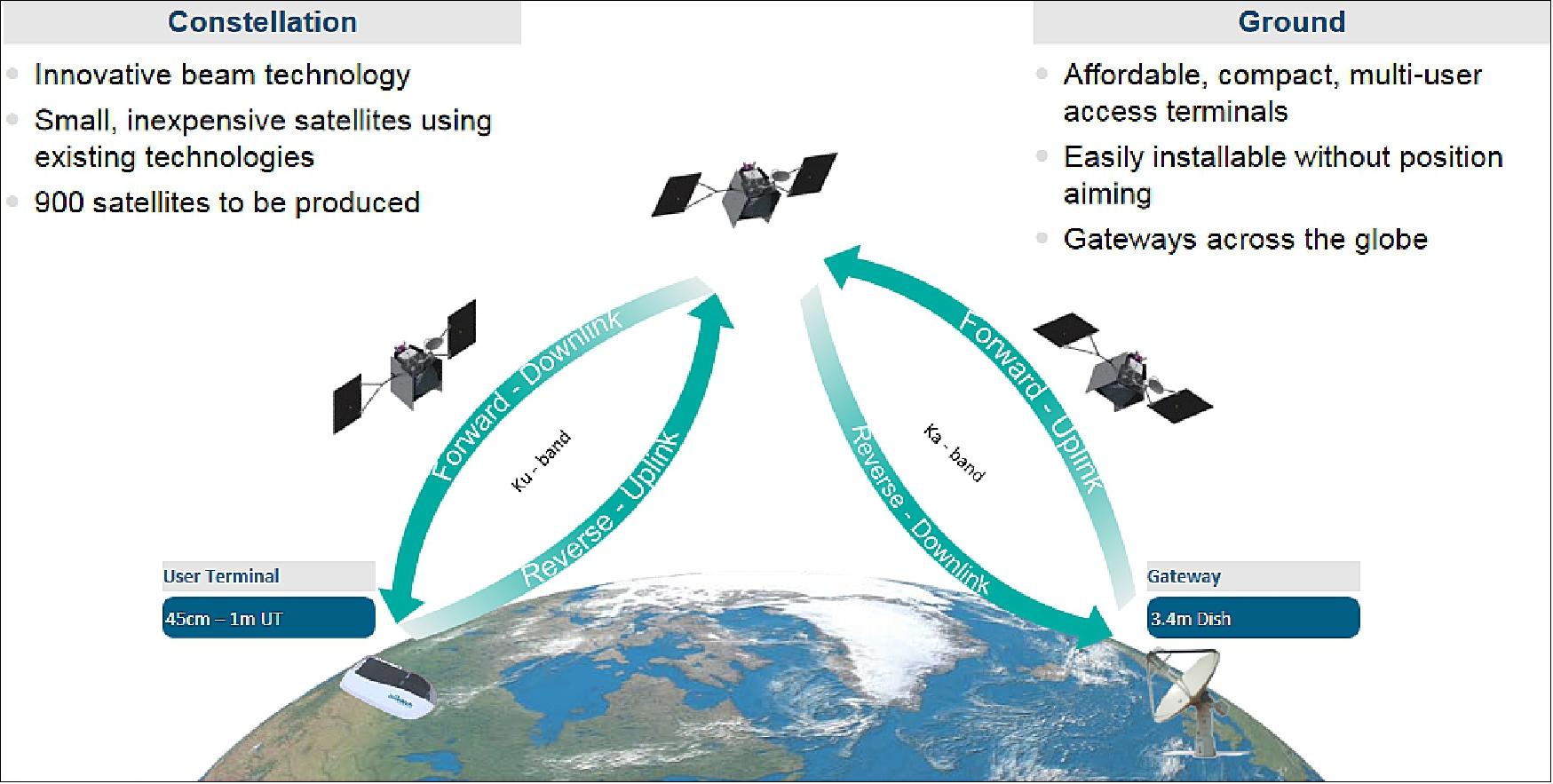
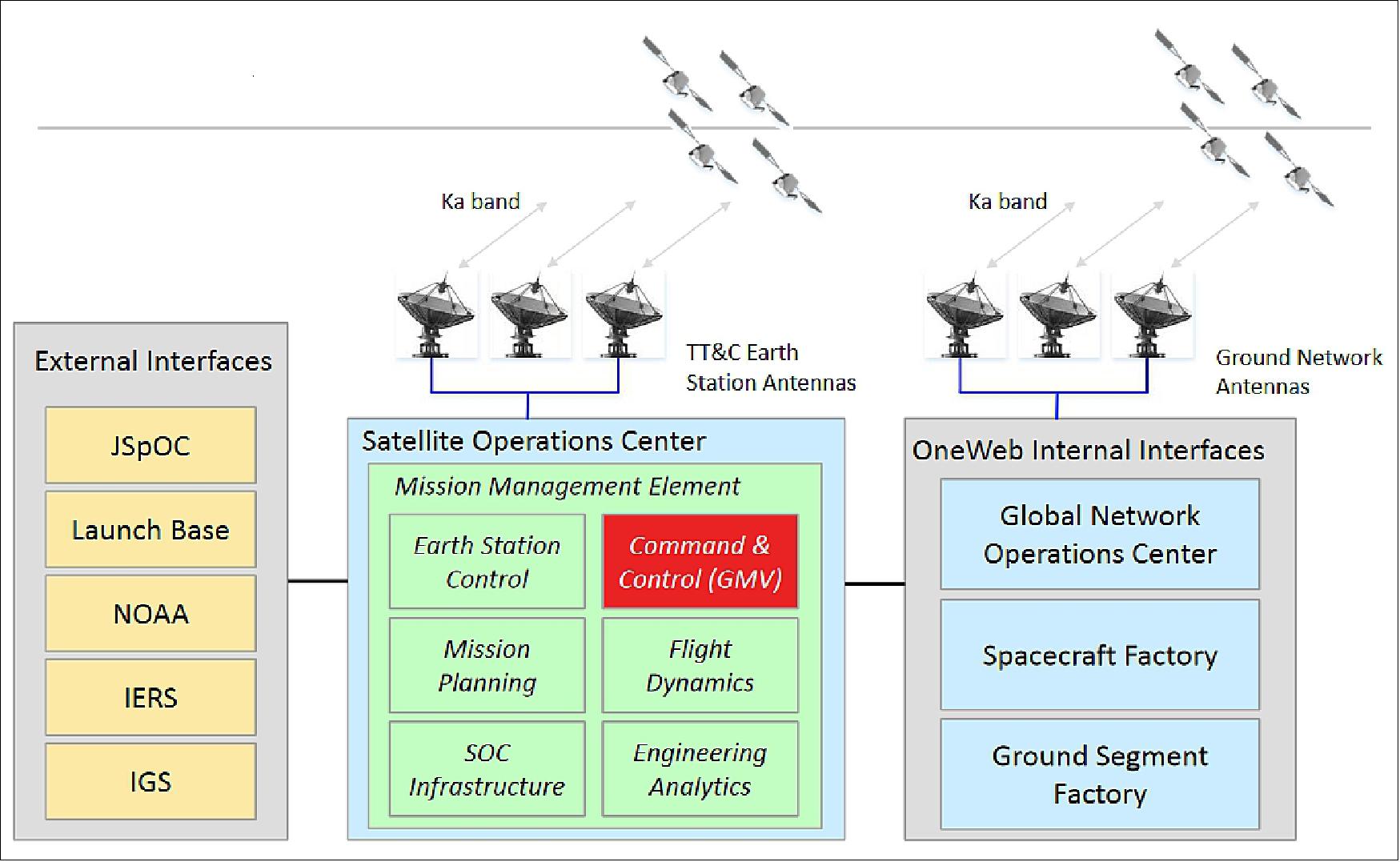
References
1) “Airbus Defence and Space Selected to Partner in Production of OneWeb Satellite Constellation ,” Airbus DS, June 15, 2015, URL: http://airbusdefenceandspace.com/newsroom/news-and-features/airbus-defence-and-space-selected-to-partner-in-production-of-oneweb-satellite-constellation/
2) Peter B. de Selding, “OneWeb Taps Airbus To Build 900 Internet Smallsats,” Space News, June 19, 2015, URL: http://spacenews.com/airbus-wins-oneweb-contract/
3) “Funding To The Tune Of $500 Million Obtained By OneWeb For Their Microsatellite Constellation,” Satnews Daily, June 25, 2015, URL: http://www.satnews.com/story.php?number=1143992329
4) “OneWeb signs agreement with Arianespace for the deployment of the OneWeb Constellation,” Arianespace, June 25, 2015, URL: http://www.arianespace.com/news-press-release/2015/6-25-2015-OneWeb.asp
5) “Virgin Galactic Signs Contract with OneWeb to Perform 39 Satellite Launches,” Virgin Galactic, June 25, 2015, URL: http://www.virgingalactic.com/press/virgin-galactic-signs-contract-with-oneweb-to-perform-39-satellite-launches/
6) “ESA announces dedicated support for the development of megaconstellations,” ESA ARTES Applications, July 31, 2015, URL: https://artes.esa.int/news/esa-announces-dedicated-support-development-megaconstellations
7) ”OneWeb Petitions The FCC For LEO Satellite Constellation Access To US Markets,” Satnews Daily, April 29, 2016, URL: http://www.satnews.com/story.php?number=130548477
8) “OneWeb Announces Plans to Launch a New Satellite Constellation to Bring High-Speed Internet to Underserved Areas Around the World,” BusinessWire, January 15, 2015, URL: http://www.businesswire.com/news/home/20150115005196/en/OneWeb-Announces-Plans-Launch-Satellite-Constellation-Bring#.VY5V20Y_PRI
10) Peter B. de Selding, “OneWeb’s Big Announcement Should Quiet Doubters,” Space News, June 25, 2015, URL: http://spacenews.com/news-analysis-onewebs-big-announcement-should-quiet-doubters/
11) ”Airbus Defence and Space and OneWeb create OneWeb Satellites company – the next stage of the OneWeb adventure,” Airbus DS, Press Release, Jan. 26, 2016, URL: https://airbusdefenceandspace.com/wp-content/uploads/2016/01/press-release-space-systems-26012016-2-eng.pdf
12) ”OneWeb Satellites Drives Into Florida With Multi-Million Dollar Manufacturing Facility,” Satnews Daily, April 19, 2016, URL: http://www.satnews.com/story.php?number=2077944514
13) ”First three subcontractors selected by OneWeb Satellites,” Airbus DS, June 1, 2016, URL: https://airbusdefenceandspace.com/newsroom/news-and-features/first-three-subcontractors-selected-by-oneweb-satellites/
14) ”OneWeb announces key funding form SoftBank Group and other investors,” Space Daily, Dec. 21, 2016, URL: http://www.spacedaily.com/reports/OneWeb_announces_key_funding_form_SoftBank_Group_and_other_investors_999.html
15) ”Done deal — Intelsat and OneWeb to combine synergies... and technologies... as well as new SoftBank investment,” Satnews Daily, Feb. 28, 2017, URL: http://www.satnews.com/story.php?number=121259652
16) ”A Consolidated Intelsat and OneWeb,” Space Daily, March 16, 2017, URL: http://www.spacedaily.com/reports/A_Consolidated_Intelsat_and_OneWeb_999.html
17) ”Plug is Pulled ... No-Go for Intelsat and OneWeb Merger ... and Intelsat's Statement,” SatNews Daily, June 1, 2017, URL: http://www.satnews.com/story.php?number=1570677260
18) Caleb Henry, ”OneWeb asks FCC to authorize 1,200 more satellites,” Space News, 20 March 2018, URL: http://spacenews.com/oneweb-asks-fcc-to-authorize-1200-more-satellites/
19) Mike Lindsay, ”OneWeb Collision Risk CONOPS,” SSA Operators' Workshop, Denver, Colorado, Nov. 3-5, 2016, URL: https://advancedssa.com/assets/img/workshop/presentations/OneWeb_SSA_Workshop.pdf
20) ”Shovels Fly as Ground is Broken For OneWebSatellites Spacecraft Integration Facility,” Satnews Daily, March 16, 2017, URL: http://www.satnews.com/story.php?number=499858844
21) ”Satellite Serial Production Initiated by OneWeb,” Satnews Daily, June 27, 2017, URL: http://www.satnews.com/story.php?number=187088687
22) ”OneWeb's Greg Wyler Testifies Before U.S. Senate Committee on Commerce, Science and Technology,” Satnews Daily, October 25, 2017, URL: http://www.satnews.com/story.php?number=1185539197
23) Eric Zeis, Gregory Pedersen, Didier Alary, Cyrille Tourneur, Helmut W. Zaglauer, ”OneWeb 3rd party PlatForm: A disruptive low cost platform enabling new LEO missions,” Proceedings of the 11th IAA Symposium on Small Satellites for Earth Observation, Berlin, Germany, April 24-28, 2017, paper: IAA-B11-1002
24) http://onewebsatellites.com/
25) Jason Rainbow, ”Eutelsat and OneWeb agree multi-orbit merger plan,” SpaceNews, 26 July 2022, URL: https://spacenews.com/eutelsat-and-oneweb-discussing-multi-orbit-merger-plan/
26) Jason Rainbow, ”OneWeb backs up Starlink 5G interference warning,” SpaceNews, 12 July 2022, URL: https://spacenews.com/oneweb-backs-up-starlink-5g-interference-warning/
27) Jeff Foust, ”OneWeb to launch second-generation satellites with Relativity Space,” SpaceNews, 1 July 2022, URL: https://spacenews.com/oneweb-to-launch-second-generation-satellites-with-relativity-space/
28) ”Busek Scales Thruster Production for Airbus OneWeb Satellites,” Space Daily, 24 June 2022, URL: https://www.spacedaily.com/reports/Busek_scales_thruster_production_for_Airbus_OneWeb_satellites_999.html
30) ”Sustainable connectivity in space,” ESA Applications, 27 May 2022, URL: https://www.esa.int/Applications/Telecommunications_Integrated_Applications/Sustainable_connectivity_in_space
31) Jason Rainbow, ”OneWeb signs contract to launch satellites from India in 2022,” SpaceNews, 20 April 2022, URL: https://spacenews.com/oneweb-signs-contract-to-launch-satellites-from-india-in-2022/
32) Debra Werner, ”Telstra to build teleports for OneWeb constellation,” SpaceNews, 22 March 2022, URL: https://spacenews.com/telstra-teleports-for-oneweb/
35) ”Arianespace to serve OneWeb’s ambitions, will orbit 34 additional satellites with Soyuz,” Arianspace, 3 February 2022, URL: https://www.arianespace.com/press-release/arianespace-to-serve-onewebs-ambitions-will-orbit-34-additional-satellites-with-soyuz/
36) Jason Rainbow, ”OneWeb forges Indian distribution partnership,” SpaceNews, 20 January 2022, URL: https://spacenews.com/oneweb-forges-indian-distribution-partnership/
37) ”BT Secures Industry First Global Partnership With OneWeb,” OneWeb Media Center, 2 November 2021, URL: https://oneweb.net/media-center/bt-secures-industry-first-global-partnership-with-oneweb
38) Jason Rainbow, ”OneWeb and Saudi Arabia create $200 million connectivity joint venture,” SpaceNews, 27 October 2021, URL: https://spacenews.com/oneweb-and-saudi-arabia-create-200-million-connectivity-joint-venture/
39) ”NSIL/ISRO and OneWeb to collaborate for taking Digital Connectivity to every Corner of the World,” OneWeb, 11 October 2021, URL: https://oneweb.net/media-center/nsil-isro-and-oneweb-to-collaborate-for-taking-digital-connectivity-to-every-corner-of-the-world
40) ”Eutelsat raises its shareholding in OneWeb,” Eutelsat Press Release, 6 October 2021, URL: https://www.eutelsat.com/en/news/press.html#/pressreleases/eutelsat-raises-its-shareholding-in-oneweb-3133766
41) Sandra Erwin, ”OneWeb signs distribution deal with Peraton, broadens reach into military market,” Space News, 16 September 2021, URL: https://spacenews.com/oneweb-signs-distribution-deal-with-peraton-broadens-reach-into-military-market/
42) Jason Rainbow, ”OneWeb and AT&T partner to extend fiberlike coverage across United States,” SpaceNews, 8 September 2021, URL: https://spacenews.com/oneweb-and-att-partner-to-extend-fiberlike-coverage-across-united-states/
43) Park Si-soo, ”OneWeb’s antenna supplier in South Korea expanding production to meet growing demand for LEO broadband terminals,” SpaceNews, 25 August 2021, URL: https://spacenews.com/onewebs-antenna-supplier-in-south-korea-expanding-production-to-meet-growing-demand-for-leo-broadband-terminals/
44) Jason Rainbow, ”OneWeb unveils its smallest user terminal for LEO broadband,” SpaceNews, 24 August 2021, URL: https://spacenews.com/oneweb-unveils-its-smallest-user-terminal-for-leo-broadband/
45) ”OneWeb Announces Significant New Equity Partner,” OneWeb, 12 August 2021, URL: https://oneweb.net/media-center/oneweb-announces-significant-new-equity-partner
46) ”Flight ST34: Arianespace supports OneWeb’s ambitions by increasing its fleet of satellites to nearly 300 spacecraft,” Arianespace Press Release, 12 August 2021, URL: https://www.arianespace.com/press-release/flight-st34-oneweb/
47) Jason Rainbow, ”U.K. to strengthen regulations for Starlink, OneWeb and other NGSO constellations,” SpaceNews, 26 July 2021, URL: https://spacenews.com/u-k-to-strengthen-regulations-for-starlink-oneweb-and-other-ngso-constellations/
48) Jason Rainbow, ”Bharti Global invests extra $500 million to take largest OneWeb stake,” SpaceNews, 29 June 2021, URL: https://spacenews.com/bharti-global-invests-extra-500-million-to-take-largest-oneweb-stake/
49) Jeff Foust, ”EU sees conflict of interest with Eutelsat’s investment in OneWeb,” SpaceNews, 26 May 2021, URL: https://spacenews.com/eu-sees-conflict-of-interest-with-eutelsats-investment-in-oneweb/
50) Jason Rainbow, ”UK funds beam-hopping satellite for OneWeb-led consortium in 2022,” SpaceNews, 24 May 2021, URL: https://spacenews.com/uk-funds-beam-hopping-satellite-for-oneweb-led-consortium-in-2022/
51) Jason Rainbow, ”OneWeb creating government subsidiary after buying TrustComm,” SpaceNews, 10 May 2021, URL: https://spacenews.com/oneweb-creating-government-subsidiary-after-buying-trustcomm/
52) Jason Rainbow, ”Hughes and OneWeb get U.S. Air Force contract for Arctic broadband,” SpaceNews, 5 May 2021, URL: https://spacenews.com/oneweb-gets-u-s-air-force-contract-for-arctic-broadband/
53) Jason Rainbow, ”Eutelsat buys a quarter of OneWeb to get a LEO broadband growth engine,” SpaceNews, 27 April 2021, URL: https://spacenews.com/eutelsat-buys-a-quarter-of-oneweb-to-get-a-leo-broadband-growth-engine/
54) Jeff Foust, ”OneWeb continues to study offering navigation services,” SpaceNews, 08 April 2021, URL: https://spacenews.com/oneweb-continues-to-study-offering-navigation-services/
55) ”OneWeb and The AST Group partner to broaden access to fast, seamless connectivity at sea,” AST, 07 April 2021, URL: https://www.theastgroup.com/us/news/oneweb-and-ast-group-partner-broaden-access-fast-seamless-connectivity-sea/
56) Sandra Erwin, ”OneWeb looking to fill demand for connectivity in the Arctic,” SpaceNews, 28 March 2021, URL: https://spacenews.com/oneweb-looking-to-fill-demand-for-connectivity-in-the-arctic/
57) ”Wi-Fi on planes boosted by satellite constellation,” ESA Applications, 19 March 2021, URL: https://www.esa.int/Applications/Telecommunications_Integrated_Applications/Wi-Fi_on_planes_boosted_by_satellite_constellation
58) ”Intellian signs $73 million contract with OneWeb for user terminals,” Intellian, 08 March 2021, URL: https://intelliantech.com/news/newsroom/intellian-signs-73-million-contract-with-oneweb-for-user-terminals/#
59) ”Flight ST30: Arianespace to hit its stride with next OneWeb launch,” Arianespace Press Release, 18 March 2021, URL: https://www.arianespace.com/press-release/st30-announce/
60) Jeff Foust, ”OneWeb raises $400 million,” SpaceNews, 15 January 2021, URL: https://spacenews.com/oneweb-raises-400-million/
61) ”Hughes Selected by OneWeb for Ground System Development and Production under New $250 Million Contract,” Hughes Press Release, 16 December 2020, URL: https://www.hughes.com/resources/press-releases/hughes-selected-oneweb-ground-system-development-and-production-under-new
62) ”OneWeb's satellite plant returns to full-scale production,” SpaceDaily, 1 December 2020, URL: https://www.spacedaily.com/reports/OneWebs_satellite_plant_returns_to_full-scale_production_999.html
63) ”UK government secures satellite network OneWeb,” UK Government Press Release, 20 November 2020, URL: https://www.gov.uk/government/news/uk-government-secures-satellite-network-oneweb
64) Jeff Foust, ”Bankruptcy court approves OneWeb sale,” SpaceNews, 2 October 2020, URL: https://spacenews.com/bankruptcy-court-approves-oneweb-sale/
65) ”Arianespace announces the resumption of the OneWeb constellation’s deployment,” Arianespace, 21 September 2020, URL: https://www.arianespace.com/press-release/arianespace-announces-the-resumption-of-the-oneweb-constellations-deployment/
66) ”UK's OneWeb resumes satellite production after bankruptcy,” Space Daily, 21 September 2020, URL: https://www.spacedaily.com/reports/UKs_OneWeb_resumes_satellite_production_after_bankruptcy_999.html
67) ”OneWeb Requests FCC Rules Relaxation + SpaceX’s $$$ Injection,” Satnews, 20 August 2020, URL: https://news.satnews.com/2020/08/20/oneweb-requests-fcc-rules-relaxation-spacexs-injection/
68) Caleb Henry, ”Hughes Network Systems to invest $50 million in revived OneWeb,” SpaceNews, 28 July 2020, URL: https://spacenews.com/hughes-network-systems-to-invest-50-million-in-revived-oneweb/
69) Chris Forrester, ”Questioning The UK Plan For OneWeb,” Satnews, 20 July 2020, URL: https://news.satnews.com/2020/07/20/questioning-the-uk-plan-for-oneweb/
70) ”UK government to acquire cutting-edge satellite network,” UK government press release, 3 July 2020, URL: https://www.gov.uk/government/news/uk-government-to-acquire-cutting-edge-satellite-network
71) https://www.bharti.com/chairman-message.html
72) ”OneWeb Files for Chapter 11 Restructuring to Execute Sale Process,” OneWeb, 27 March 2020, URL: https://www.oneweb.world/media-center/oneweb-files-for-chapter-11-restructuring-to-execute-sale-process
73) ”Hughes and OneWeb Announce Global Distribution Partnership for Low Earth Orbit Satellite Service,” PR Newswire, 9 March 2020, URL: https://www.prnewswire.com/news-releases/hughes-and-oneweb-announce-global-distribution-partnership-for-low-earth-orbit-satellite-service-301019416.html
74) ”RUAG Space dispenses another batch of Airbus OneWeb satellites,” Space Daily, 7 February 2020, URL: http://www.spacedaily.com/reports/RUAG_Space_Mega_Dispenser_with_Hat_used_for_Airbus_OneWeb_Satellite_Launch_999.html
75) ”OneWeb lifts off: Next batch ready to launch,” Airbus, 3 February 2020, URL: https://web.archive.org/web/20210928060754/https://www.airbus.com/newsroom/press-releases/en/2020/02/oneweb-lifts-off-next-batch-ready-to-launch.html
76) ”OneWeb Confirms Launch Date from Baikonur, Kazakhstan,” OneWeb, 30 January 2020, URL: https://www.oneweb.world/assets/news/media/OneWebLaunch30012020.pdf
77) Stephen Clark, ”OneWeb’s first full-up launch delayed to January ,” Spaceflight Now, 12 November 2019, URL: https://spaceflightnow.com/2019/11/12/onewebs-first-full-up-launch-delayed-to-january/
78) ”OneWeb Satellites and partners OneWeb and Airbus transform space industry with world’s first high-volume satellite production facility in Florida,” OneWeb, 22 July 2019, URL: https://www.oneweb.world/media-center/oneweb-satellites-and-partners-oneweb-and-airbus-transform-space-industry-with-worlds-first-high-volume-satellite-production-facility-in-florida
79) ”Why an Elementary School's Name in Anchorage, Alaska, was Selected to be on a OneWeb Satellite,” Satnews Daily, 25 February 2019, URL: http://www.satnews.com/story.php?number=1363437694#
80) ”18m pounds for OneWeb satellite constellation to deliver global communications,” Space Daily, 19 February 2019, URL: http://www.spacedaily.com/reports/18m_pounds_for_OneWeb_satellite_constellation_to_deliver_global_communications_999.html
81) UKSA and Chris Skidmore MP, ”£18m for OneWeb satellite constellation to deliver global communications,” GOV.UK, 18 February 2019, URL: https://www.gov.uk/government/news/18m-for-oneweb-satellite-constellation-to-deliver-global-communications
82) ”Six OneWeb satellites are integrated for their upcoming Arianespace Soyuz launch,” Arianespace, 13 February 2019, URL: http://www.arianespace.com/mission-update/vs21-oneweb-integration/
83) ”Integration of Six OneWeb Spacecraft Completed by Arianespace for Upcoming Launch,” Satnews Daily, 13 Feb. 2019, URL: http://www.satnews.com/story.php?number=1603746248
84) ”OneWeb Satellites has shipped first satellites for the OneWeb constellation to launch site,” Airbus Press Release, 22 January 2019, https://www.airbus.com/newsroom/press-releases/en/2019/01/oneweb-satellites-has-shipped-first-satellites-for-the-oneweb-constellation-to-launch-site.html
85) Caleb Henry, ”OneWeb scales back baseline constellation by 300 satellites,” Space News, 13 December 2018, URL: https://spacenews.com/oneweb-scales-back-constellation-by-300-satellites/
86) ”Arianespace’s thirteenth flight for OneWeb successfully deployed 34 additional satellites,” Arianespace Press Release, 10 February 2022, URL: https://www.arianespace.com/press-release/arianespaces-thirteenth-flight-for-oneweb-successfully-deployed-34-additional-satellites/
87) Jason Rainbow, ”Arianespace launches 34 OneWeb satellites in first mission of 2022,” SpaceNews, 10 February 2022, URL: https://spacenews.com/arianespace-launches-34-oneweb-satellites-in-first-mission-of-2022/
88) ”Flight ST37, the 15th operated by Arianespace in 2021, successfully placed 36 more OneWeb satellites into orbit,” Arianespace Press Release, 27 December 2021, URL: https://www.arianespace.com/press-release/flight-st37-the-15th-operated-by-arianespace-in-2021-sucessfully-placed-36-more-oneweb-satellites-into-orbit/
89) ”OneWeb Confirms Successful Launch of 36 Satellites, After Rapid Year of Progress,” OneWeb, 27 December 2021, URL: https://oneweb.net/media-center/oneweb-confirms-successful-launch-of-36-satellites-after-rapid-year-of-progress
90) ”With Flight ST36, Arianespace sets a new mark; more than half of the OneWeb constellation now successfully deployed,” Arianespace Press Release, 14 October 2021, URL: https://www.arianespace.com/press-release/soyuz-st36-oneweb-success/
91) ”With Flight ST35 for OneWeb, Arianespace sets a new mark by successfully putting more than 1,000 satellites in orbit since its foundation,” Arianespace Press Release, 14 September 2021, URL: https://www.arianespace.com/press-release/flight-st35-success-oneweb/
92) ”Following VA254 and VV19, Flight ST34 marks Arianespace’s third successful launch in less than one month,” Arianespace Press Release, 22 August 2021, URL: https://www.arianespace.com/press-release/soyuz-st34-oneweb-success/
93) ”Flight ST33: Arianespace successfully deploys 36 OneWeb constellation satellites,” Arianespace Press Release, 1 July 2021, URL: https://www.arianespace.com/press-release/flight-st33-arianespace-successfully-deploys-36-oneweb-constellation-satellites/
94) ”OneWeb Completes its ‘Five to 50’ Mission to Cover Regions North of 50 Degrees Latitude including UK, Canada, Alaska and Arctic Region,” OneWeb, 1 July 2021, URL: https://www.oneweb.world/media-center/oneweb-completes-its-five-to-50-mission
95) Jason Rainbow, ”OneWeb hits coverage goal with latest launch, sets sights on southern regions,” SpaceNews, 1 July 2021, URL: https://spacenews.com/oneweb-hits-coverage-goal-with-latest-launch-sets-sights-on-southern-regions/
96) ”Successful Launch Brings OneWeb Closer to ‘Five to 50’ Ambition,” OneWeb, 28 May 2021, URL: https://www.oneweb.world/media-center/successful-launch-brings-oneweb-closer-to-five-to-50-ambition
97) ”Flight ST32: Arianespace successfully deploys OneWeb constellation satellites,” Arianespace Press Release, 29 May 2021, URL: https://www.arianespace.com/press-release/flight-st32-arianespace-successfully-deploys-oneweb-constellation-satellites/
98) ”Flight ST31: Arianespace successfully deploys OneWeb constellation satellites,” Arianespace Press Release, 26 April 2021, URL: https://www.arianespace.com/press-release/flight-st31-arianespace-successfully-deploys-oneweb-constellation-satellites/
99) Jason Rainbow, ”OneWeb adds 36 satellites to broadband constellation as deployment accelerates,” SpaceNews, 25 April 2021, URL: https://spacenews.com/oneweb-adds-36-satellites-to-broadband-constellation-as-deployment-accelerates/
100) ”Flight ST30: Arianespace successfully deploys OneWeb constellation satellites,” Arianespace Press Release, 25 March 2021, URL: https://www.arianespace.com/press-release/soyuz-st30-success/
101) ”Launch#5 Building the Network,” OneWeb, 25 March 2021, URL: https://www.oneweb.world/
102) Jeff Foust, ”OneWeb resumes satellite deployment with Soyuz launch,” SpaceNews, 18 December 2020, URL: https://spacenews.com/oneweb-resumes-satellite-deployment-with-soyuz-launch/
103) ”Flight ST29: Successful OneWeb constellation’s satellites deployment with Arianespace’s first mission from the Vostochny Cosmodrome,” Arianespace Press Release, 18 December 2020, URL: https://www.arianespace.com/press-release/flight-st29-successful-oneweb-constellations-satellites-deployment-with-arianespaces-first-mission-from-the-vostochny-cosmodrome/
104) Stephen Clark, ”Soyuz rocket successfully launches 34 more OneWeb satellites,” 21 March 2020, URL: https://spaceflightnow.com/2020/03/21/soyuz-rocket-successfully-launches-34-more-oneweb-satellites/
105) ”OneWeb successfully launches 34 more satellites into orbit in second launch of 2020,” OneWeb, 21 March 2020, URL: https://www.oneweb.world/media-center/oneweb-successfully-launches-34-more-satellites-into-orbit-in-second-launch-of-2020
106) Stephen Clark, ”Successful Soyuz launch deploys 34 satellites for OneWeb network,” Spaceflight Now, 7 February 2020: https://spaceflightnow.com/2020/02/07/successful-soyuz-launch-deploys-34-satellites-for-oneweb-network/
107) ”Mission success: Arianespace and Starsem launch 34 OneWeb satellites to help bridge the digital divide,” Arianespace, 7 February, 2020, URL: https://www.arianespace.com/press-release/mission-success-arianespace-and-starsem-launch-34-oneweb-satellites-to-help-bridge-the-digital-divide/
108) ”Soyuz Flight ST27 Launch Kit, Arianespace, February 2020, URL: https://www.arianespace.com/wp-content/uploads/2020/01/ST27-launch-kit_EN.pdf
109) ”Connecting everyone, everywhere: Arianespace orbits the first six OneWeb satellites on its latest Soyuz success,” Arianespace, 27 February 2019, URL: http://www.arianespace.com/mission-update/soyuz-vs21-success-oneweb/
110) ”Arianespace launches first batch of OneWeb satellites,” Space Daily, 28 February 2019, URL: http://www.spacedaily.com/reports/Arianespace_successfully_performs_the_first_of_21_launches_for_the_OneWeb_constellation_999.html
111) Sandra Erwin, ”Hughes and OneWeb deploy high-speed internet for U.S. military at remote Arctic base,” SpaceNews, 23 June 2022, URL: https://spacenews.com/hughes-and-oneweb-deploy-high-speed-internet-for-u-s-military-at-remote-arctic-base/
112) ”OneWeb Technologies and Intelsat Demo Global Multi-Orbit Satellite Service to U.S. Department of Defense,” OWT, 4 November 2021, URL: https://web.archive.org/web/20220703175510/https://www.onewebtechnologies.net/about/news/article/20211104-OneWeb-Technologies-and-Intelsat-Demo-Global-Multi-Orbit-Satellite-Service-to-DoD.html
113) ”OneWeb and BT sign agreement to explore rural connectivity solutions in the UK and beyond,” OneWeb, 27 June 2021, URL: https://www.oneweb.world/media-center/oneweb-and-bt-sign-agreement-to-explore-rural-connectivity-solutions-in-the-uk-and-beyond
114) Jason Rainbow, ”OneWeb agrees SoftBank alliance to get Japanese regulatory approvals,” SpaceNews, 13 May 2021, URL: https://spacenews.com/oneweb-agrees-softbank-alliance-to-get-japanese-regulatory-approvals/
115) ”OneWeb takes Responsible Space to the Next Level with Recommendations for Sustainable Space Practices,” OneWeb, 23 October 2019, URL: https://www.oneweb.world/media-center/oneweb-takes-responsible-space-to-the-next-level-with-recommendations-for-sustainable-space-practices
116) H. G. Lewis, T. Maclay, JP Sheehan and M. Lindsay, ”Long-Term Environmental Effects of Deploying the OneWeb Satellite Constellation,” Proceedings of the 70th IAC (International Astronautical Congress), Washington DC, USA, 21-25 October 2019, paper: IAC-19-A6.2.4, URL: https://iafastro.directory/iac/proceedings/IAC-19/IAC-19/A6/2/manuscripts/IAC-19,A6,2,4,x53804.pdf
117) T. Maclaya, W. Everetts, D. Engelhardt, ”Responsible Satellite Design and Operational Practices:A Critical Component of Effective Space Environment Management (SEM),” Proceedings of the 70th IAC (International Astronautical Congress), Washington DC, USA, 21-25 October 2019, paper: IAC-19-A6.10-B4.10.3 URL: https://iafastro.directory/iac/proceedings/IAC-19/IAC-19/A6/10-B4.10/manuscripts/IAC-19,A6,10-B4.10,3,x54708.pdf
118) T. Maclaya, D. McKnight, ”Space Environment Management: Framing the Objective and Setting Priorities for Controlling Orbital Debris Risk,” Proceedings of the 70th IAC (International Astronautical Congress), Washington DC, USA, 21-25 October 2019, paper: IAC-19-A6.8.3, URL: https://iafastro.directory/iac/proceedings/IAC-19/IAC-19/A6/8/manuscripts/IAC-19,A6,8,3,x49636.pdf
119) Ruth Pritchard-Kelly, ”New Satellite Technologies to Provide the Geographic Ubiquity Needed to Connect the Globe, Benefitting the SDGs, 5G, and the Digital Divide,” Proceedings of the 70th IAC (International Astronautical Congress), Washington DC, USA, 21-25 October 2019, paper: IAC-19-B2.5, URL: https://iafastro.directory/iac/proceedings/IAC-19/IAC-19/B2/5/manuscripts/IAC-19,B2,5,1,x48679.pdf
120) ”OneWeb brings fiber-like internet for the Arctic in 2020,” OneWeb, 4 September 2019, URL: https://www.oneweb.world/media-center/oneweb-brings-fiber-like-internet-for-the-arctic-in-2020
121) ”OneWeb's Global Ku- and Ka-Band Spectrum is Secured,” Satnews Daily, 11 August 2019, URL: http://www.satnews.com/story.php?number=1228106568
122) ”OneWeb Secures Global Spectrum Further Enabling Global Connectivity Services,” OneWeb, 7 August 2019, URL: https://www.oneweb.world/media-center/oneweb-secures-global-spectrum-further-enabling-global-connectivity-services
123) ”OneWeb’s Satellites Deliver Real-Time HD Streaming from Space,” OneWeb, 16 July 2019, URL: https://www.oneweb.world/media-center/onewebs-satellites-deliver-real-time-hd-streaming-from-space
124) ”OneWeb Partners with Intellian for User Terminals,” Satnews Daily, 7 May 2019, URL: http://www.satnews.com/story.php?number=125976386
125) ”OneWeb and Intellian Announce User Terminal Partnership to Enable Remote Enterprise and Cellular Backhaul Connectivity Expansion,” Intellian Press Release, 7 May 2019, URL: [web source no longer available]
126) ”OneWeb Secures $1.25 Billion in New Funding After Successful Launch,” OneWeb Press Release, 18 March 2019, URL: https://www.oneweb.world/newsroom/oneweb-secures-1-25-billion-in-new-funding-after-successful-launch
127) ”GMV controls the first satellites of OneWeb's mega-constellation,” Space Daily, 5 March 2019, URL: http://www.spacedaily.com/reports/GMV_controls_the_first_satellites_of_OneWebs_mega_constellation_999.html
128) ”Arianespace successfully performs the first of 21 launches for the OneWeb constellation,” 27 February 2019, URL: http://www.arianespace.com/press-release/arianespace-successfully-performs-the-first-of-21-launches-for-the-oneweb-constellation/
129) Caleb Henry, ”Bharti Enterprises asks ISRO for help developing OneWeb user terminals,” SpaceNews, 20 August 2020, URL: https://spacenews.com/bharti-enterprises-asks-isro-for-help-developing-oneweb-user-terminals/
130) ”Hughes and OneWeb Announce Global Distribution Partnership for Low Earth Orbit Satellite Service,” OneWeb, 9 March 2020, URL: https://www.oneweb.world/media-center/hughes-and-oneweb-announce-global-distribution-partnership-for-low-earth-orbit-satellite-service
131) ”Hughes Signs $190M Contract with OneWeb for Production of Ground Network System for Global Internet Services,” Hughes 7 November 2017, URL: https://www.hughes.com/who-we-are/resources/press-releases/hughes-signs-190m-contract-oneweb-production-ground-network
132) ”Architecting OneWeb's Massive Satellite Constellation Ground System,” Ground Segment Architecture Workshop 2017, URL: http://gsaw.org/wp-content/uploads/2017/03/2017s10moreira_tseu.pdf
The information compiled and edited in this article was provided by Herbert J. Kramer from his documentation of: ”Observation of the Earth and Its Environment: Survey of Missions and Sensors” (Springer Verlag) as well as many other sources after the publication of the 4th edition in 2002. Comments and corrections to this article are always welcome for further updates (eoportal@symbios.space).